
MANUAL
Release 02.2024
Training Script Language
PRACTICE

Training Script Language PRACTICE | 2
©
1989-2024 Lauterbach
Training Script Language PRACTICE
TRACE32 Online Help
TRACE32 Directory
TRACE32 Index
TRACE32 Training ............................................................................................................................
Training Script Language PRACTICE ..........................................................................................1
History ......................................................................................................................................... 5
E-Learning ................................................................................................................................... 5
Ready-to-Run Scripts ................................................................................................................. 5
Related Documents .................................................................................................................... 5
Introduction to Script Language PRACTICE ........................................................................... 6
Area of Use 6
Run a Script 7
Create a PRACTICE Script ......................................................................................................... 9
Convert TRACE32 Settings to a Script 9
Command LOG 14
Command History 15
Script Editor PEDIT 16
Syntax Highlighting 18
Debugging of PRACTICE Script ................................................................................................ 19
Debug Environment 20
Display the PRACTICE Stack 24
PRACTICE Language ................................................................................................................. 25
Program Elements 25
Comments 25
Commands 25
Functions 25
Labels 26
PRACTICE Flow Control ............................................................................................................ 27
Conditional Program Execution 27
Command List 27
Subroutine Calls 32
Command List 32
Example 33
GOTO/JUMPTO 35
Command List 35

Training Script Language PRACTICE | 3
©
1989-2024 Lauterbach
Example 36
Script Calls 38
Command List 38
Example 38
PRACTICE Macros 39
Declare a Macro 39
Assign Content to a Macro 41
Macro Handling 43
Macros as Strings 45
Macros as Numbers 47
Note for Testing 50
More Complex Data Structures 51
Script Examples ......................................................................................................................... 52
Run Through Program and Generate a Test Report 52
Check Contents of Addresses 58
Check Contents of Address Range 59
Check the Contents of Variables 62
Record Formatted Variables 63
Record Variable as CSV 64
Test Functions 66
Test Function with Parameter File 67
Parameter Passing ..................................................................................................................... 69
Pass Parameters to a PRACTICE Script or to a Subroutine 69
PARAMETERS/RETURNVALUES vs. ENTRY 77
Operating System Interaction ................................................................................................... 82
Operating System Detection 82
Printing Results 83
Accessing Environment Variables 85
Running a Command 86
File Manipulation 87
Time and Date Functions 91
I/O Commands ............................................................................................................................ 92
Output Command 92
Input Command 92
I/O via the AREA Window 94
Event Control via PRACTICE 96
Simple Dialogs ............................................................................................................................ 97
Dialog Programming .................................................................................................................. 100
Control Positioning 103
Control Properties 105
Enable or Disable a Control 106

Training Script Language PRACTICE | 4
©
1989-2024 Lauterbach
Collect data from a control 107
Setting a value or state to a control 110
Execute a command 111
File Browsing 113
Icons 115
Dialog Example 116
PRACTICE in a Multi-Core Environment .................................................................................. 121
Communication via InterCom 122
Designing Robust PRACTICE Scripts ...................................................................................... 124
Path Functions and Path Prefixes 125
Host Operating System 127
Debug Hardware 128
Target CPU and Board 129
TRACE32 Version 130
TRACE32 Settings 131
Storing and Retrieving Settings 133
Robust Error Handling 136
Argument Handling 138
Creating a Custom Command 139
Common Pitfalls 140

Training Script Language PRACTICE | 5
©
1989-2024 Lauterbach
Training Script Language PRACTICE
Version 04-Mar-2024
History
31-Jan-2023 Solaris was removed as supported host OS.
02-Nov-2022 In the chapter ‘Related Documents‘ has been added.
E-Learning
Videos about the script language PRACTICE can be found here:
support.lauterbach.com/kb/articles/practice-tutorial
Ready-to-Run Scripts
Ready-to-run PRACTICE scripts provided by the Lauterbach experts are published and updated daily here:
https://www.lauterbach.com/scripts.html
Related Documents
• “PowerView User’s Guide” (ide_user.pdf): In the chapters Operands and Operators you will
find everything that you need to know about operands and operators.

Training Script Language PRACTICE | 6
©
1989-2024 Lauterbach
Introduction to Script Language PRACTICE
Area of Use
The main tasks of PRACTICE scripts are:
• To provide the proper start-up sequence for the development tool
• To automate FLASH programming
• To customize the user interface
• To store and reactivate specific TRACE32 settings
• To run automatic tests
The standard extension for PRACTICE scripts is.cmm.
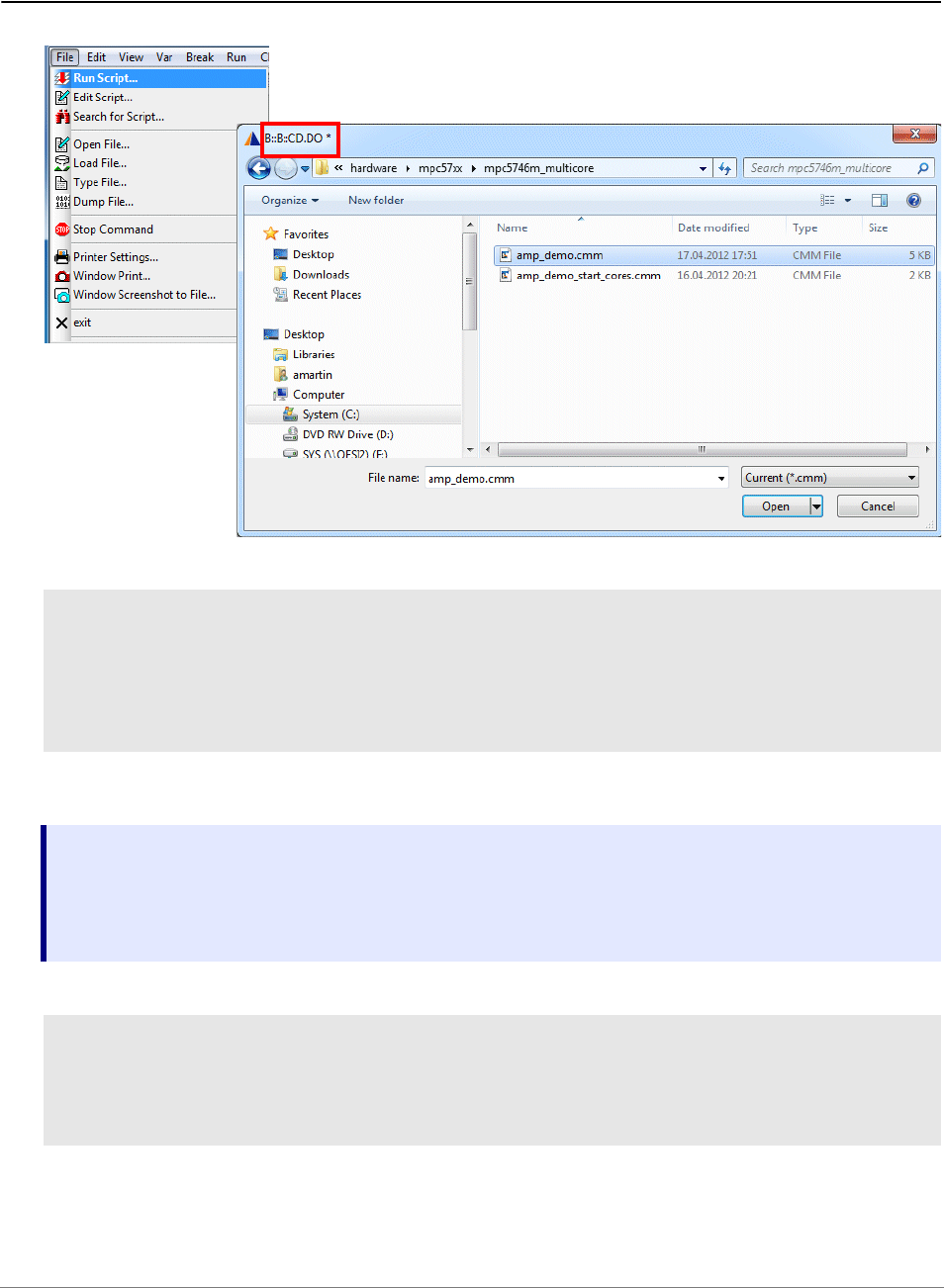
Training Script Language PRACTICE | 7
©
1989-2024 Lauterbach
Run a Script
CD.DO * // "*" opens a file browser for script
// selection
// TRACE32 first changes to the directory
// where the selected script is located and
// then starts the script
ChDir.DO <filename> Change to the directory where the script <filename> is located
and start the script.
DO <filename> Start script <filename>.
PATH [+] <path_name> Define search paths for PRACTICE scripts.
DO memtest
ChDir.DO c:/t32/demo/powerpc/hardware
PATH c:/t32/tests

Training Script Language PRACTICE | 8
©
1989-2024 Lauterbach
It is possible to execute a PRACTICE script on startup of TRACE32. For details refer to “Automatic Start-
up Scripts” in PRACTICE Script Language User’s Guide, page 14 (practice_user.pdf).

Training Script Language PRACTICE | 9
©
1989-2024 Lauterbach
Create a PRACTICE Script
Convert TRACE32 Settings to a Script
The commands STOre and ClipSTOre generate scripts that allow to reactivate the specified TRACE32
<setting> at any time.
<setting> is in most cases the setup of a command group.
<setting>
SYStem Setting for command group SYStem.
Break Setting for command group Break.
Win TRACE32 window configuration.
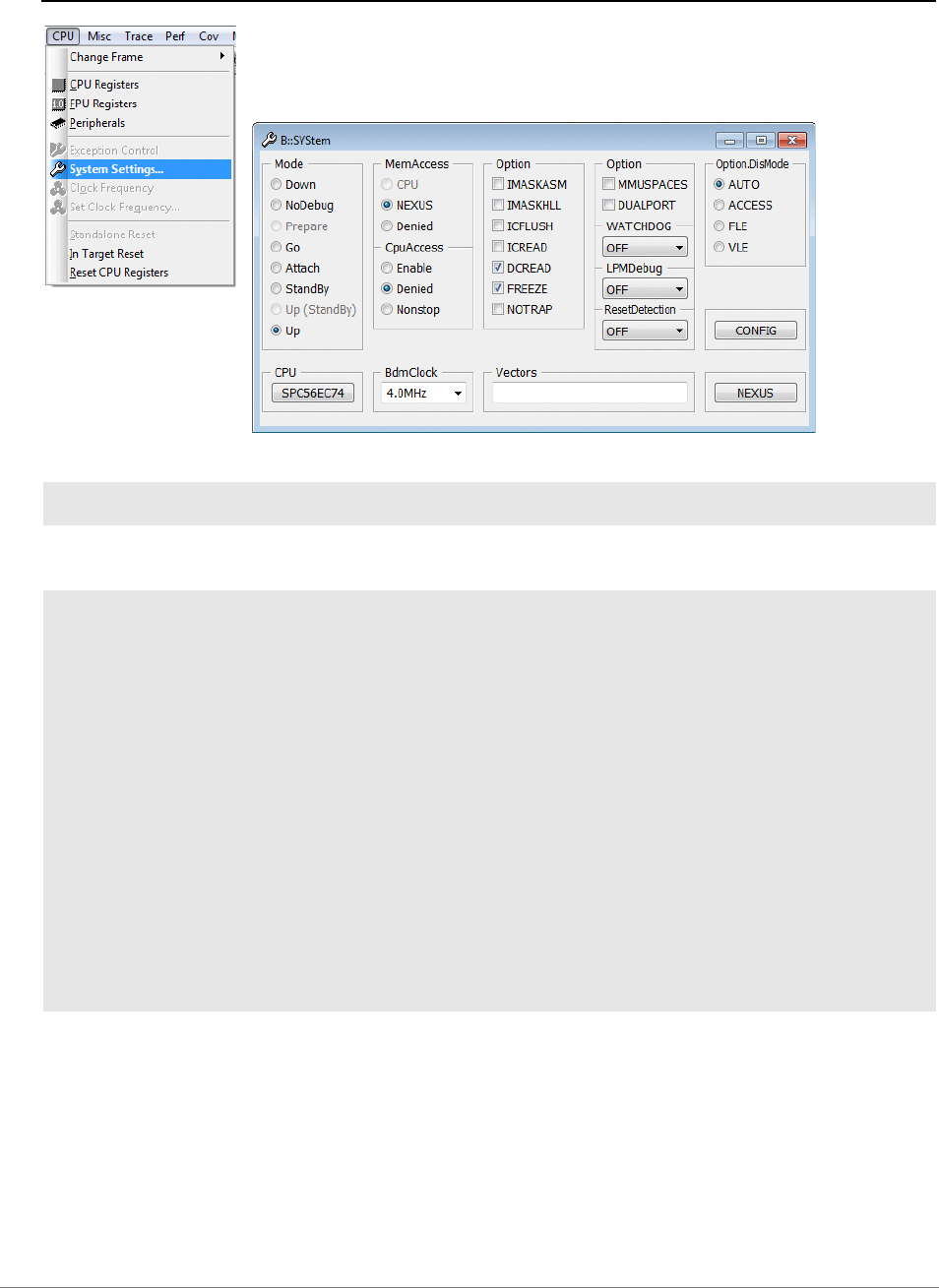
Training Script Language PRACTICE | 10
©
1989-2024 Lauterbach
Create a script to reactivate the current SYStem settings and store it to clipboard
ClipSTOre SYStem
SYSTEM.RESET
SYSTEM.CPU SPC56EC74
SYSTEM.CONFIG.CORENUMBER 2.
SYSTEM.CONFIG.CORE 1. 1.
CORE.ASSIGN 1.
SYSTEM.MEMACCESS NEXUS
SYSTEM.CPUACCESS DENIED
SYSTEM.OPTION.IMASKASM OFF
SYSTEM.OPTION.IMASKHLL OFF
SYSTEM.BDMCLOCK 4000000.
SYSTEM.CONFIG.TRISTATE OFF
SYSTEM.CONFIG.SLAVE OFF
SYSTEM.CONFIG.TAPSTATE 7.
SYSTEM.CONFIG.TCKLEVEL 0.
SYSTEM.CONFIG.DEBUGPORT Analyzer0
SYSTEM.CONFIG.CJTAGFLAGS 0x3
SYSTEM.MODE UP
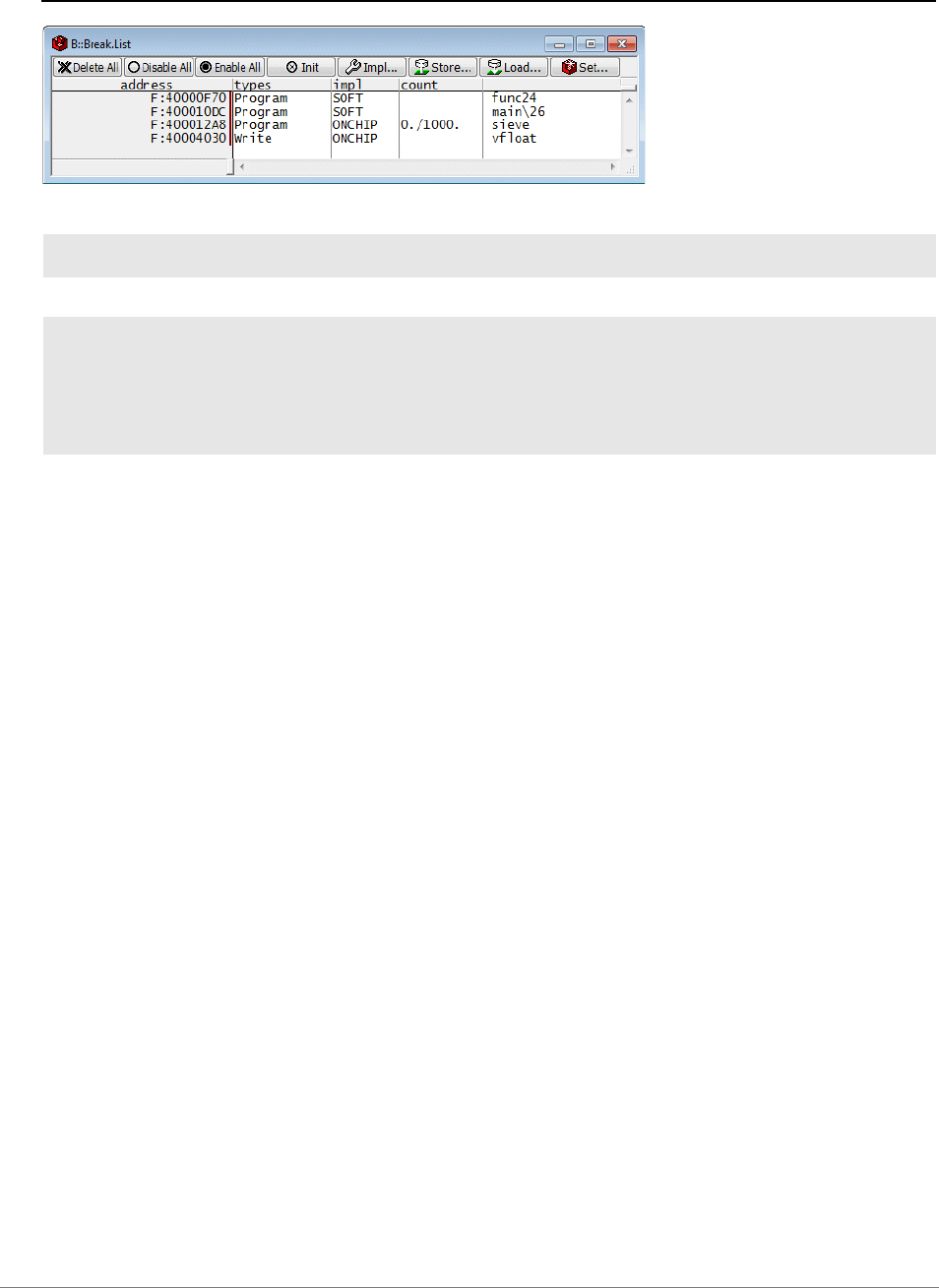
Training Script Language PRACTICE | 11
©
1989-2024 Lauterbach
Create a script to reactivate current Break settings and store it to clipboard
The breakpoints are saved at a symbolic level by default.
ClipSTOre Break
Break.RESet
Break.Set func24 /Program
Break.Set main\26 /Program
Break.Set sieve /Program /Onchip /COUNT 1000.
Var.Break.Set mstatic1; /Write
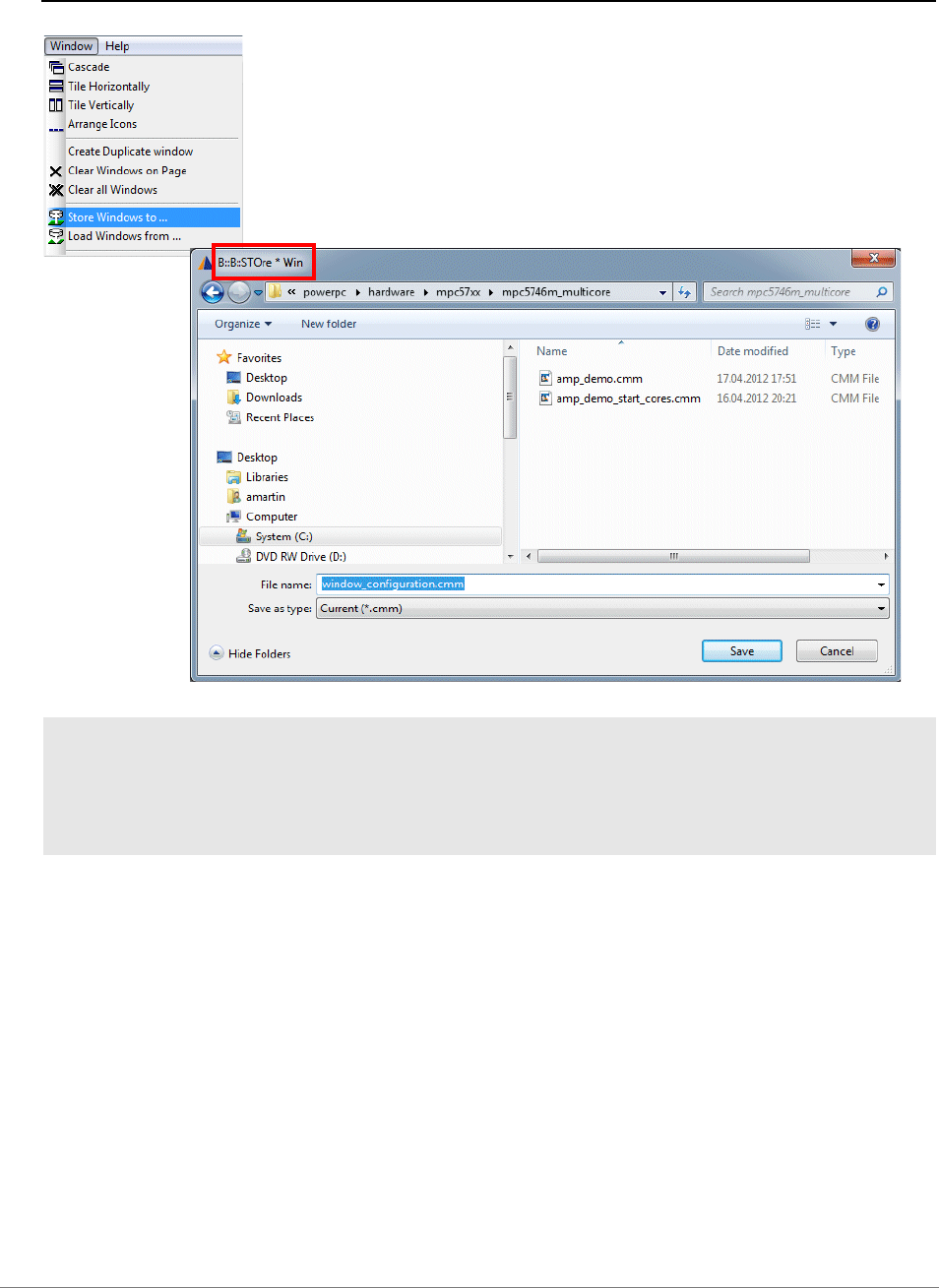
Training Script Language PRACTICE | 12
©
1989-2024 Lauterbach
Create a script to reactivate the current window configuration
STOre window_configuration.cmm Win /NoDate // TRACE32 creates script
// window_configuration
// to reactivate the
// current window
// configuration

Training Script Language PRACTICE | 13
©
1989-2024 Lauterbach
.
B::
TOOLBAR ON
STATUSBAR ON
FramePOS 15.625 8.9286 193. 47.
WinPAGE.RESet
WinPAGE.Create P000
WinCLEAR
WinPOS 0.0 22.214 80. 5. 0. 0. W002
Var.View %SpotLight.on %E flags %Open vtripplearray
WinPOS 0.0 31.429 80. 8. 5. 0. W003
Frame /Locals /Caller
WinPOS 0.0 0.0 80. 16. 13. 1. W000
WinTABS 10. 10. 25. 62.
List.auto
WinPOS 84.25 0.0 77. 20. 0. 0. W004
Register.view
WinPOS 83.875 24.071 105. 6. 0. 0. W001
PER , "FlexCAN"
WinPAGE.select P000
ENDDO
Each PRACTICE script should end with an ENDDO instruction.
ENDDO Return from PRACTICE script.
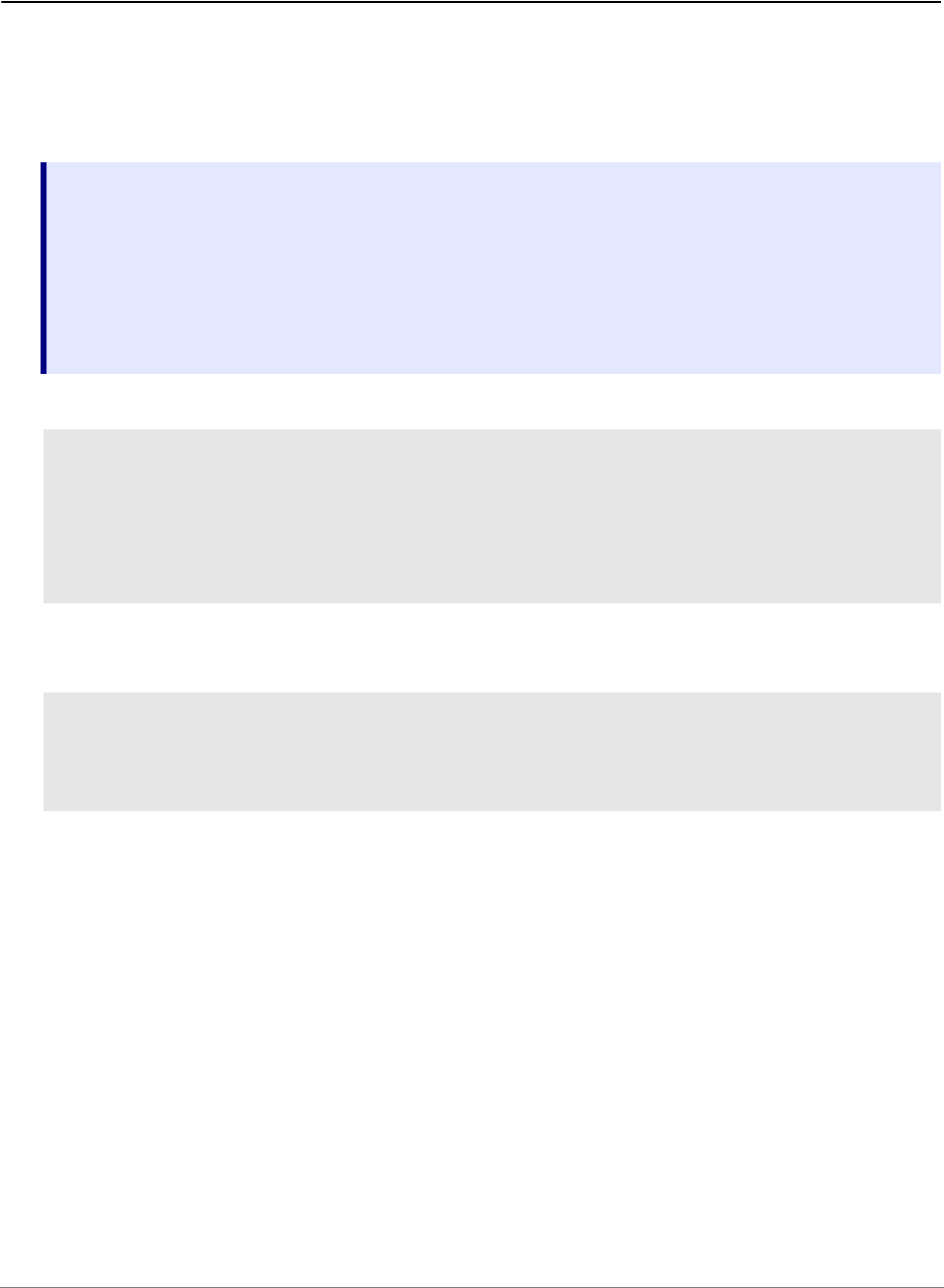
Training Script Language PRACTICE | 14
©
1989-2024 Lauterbach
Command LOG
The LOG command allows users to create a record of most of the activities in the TRACE32 PowerView
GUI.
Commands to control the LOG command:
Contents of a command log:
LOG.OPEN <log_file> Create and open a file for the command LOG. The default extension
for LOG files is (.log).
LOG.CLOSE Close the command LOG file.
LOG.OFF Switch off command LOG temporarily.
LOG.ON Switch on command LOG.
LOG.type Display command LOG while recording.
LOG.OPEN my_log.log // Creates and opens the .log file
LOG.type // Displays .log file contents while recording
… // Recording
LOG.CLOSE // Closes .log file
B::B::List
B::Go func24
// B::LOG.ON
B::B::PER , "Analog to Digital Converter"
B::B::PER.Set.simple ANC:0xFFE00000 %L (d.l(ANC:0xFFE00000)&~0x40000000)|0x40000000
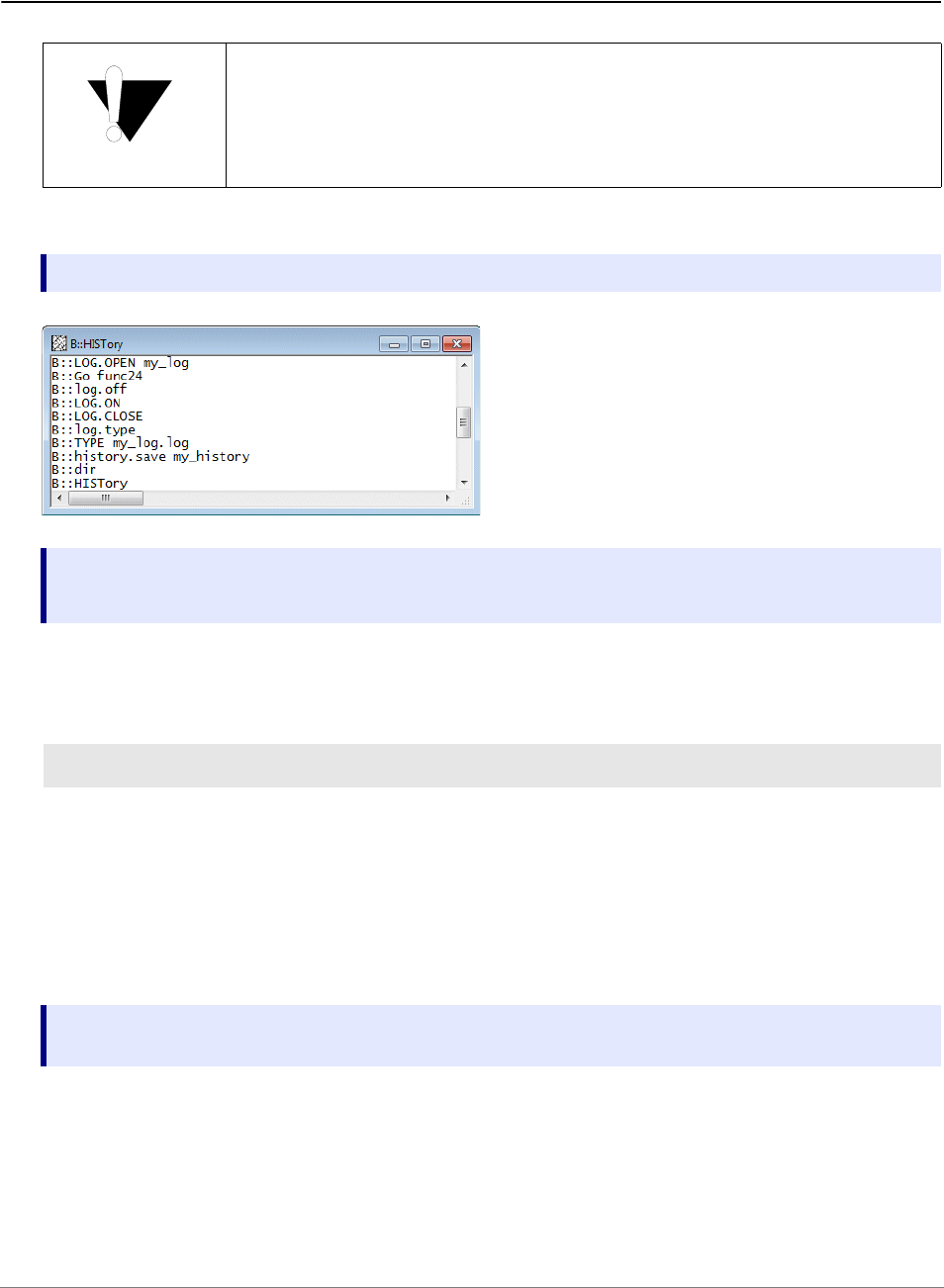
Training Script Language PRACTICE | 15
©
1989-2024 Lauterbach
Command History
By default the script autostart.cmm contains the line:
which automatically saves the command history in your temporary directory when you exit TRACE32 and
recalls the command history when you start TRACE32 again.
The command history records only commands entered into the command line.
The default extension for HISTory-files is (.log)
HISTory.type Display the command history
HISTory.SAVE [<file>] Save the command history
HISTory.SIZE [<size>] Define the size of the command history
AutoSTOre , HISTory
AutoSTOre <filename> {<setting>} Store defined settings automatically at the exit of
TRACE32 and reactivate them at the start of TRACE32
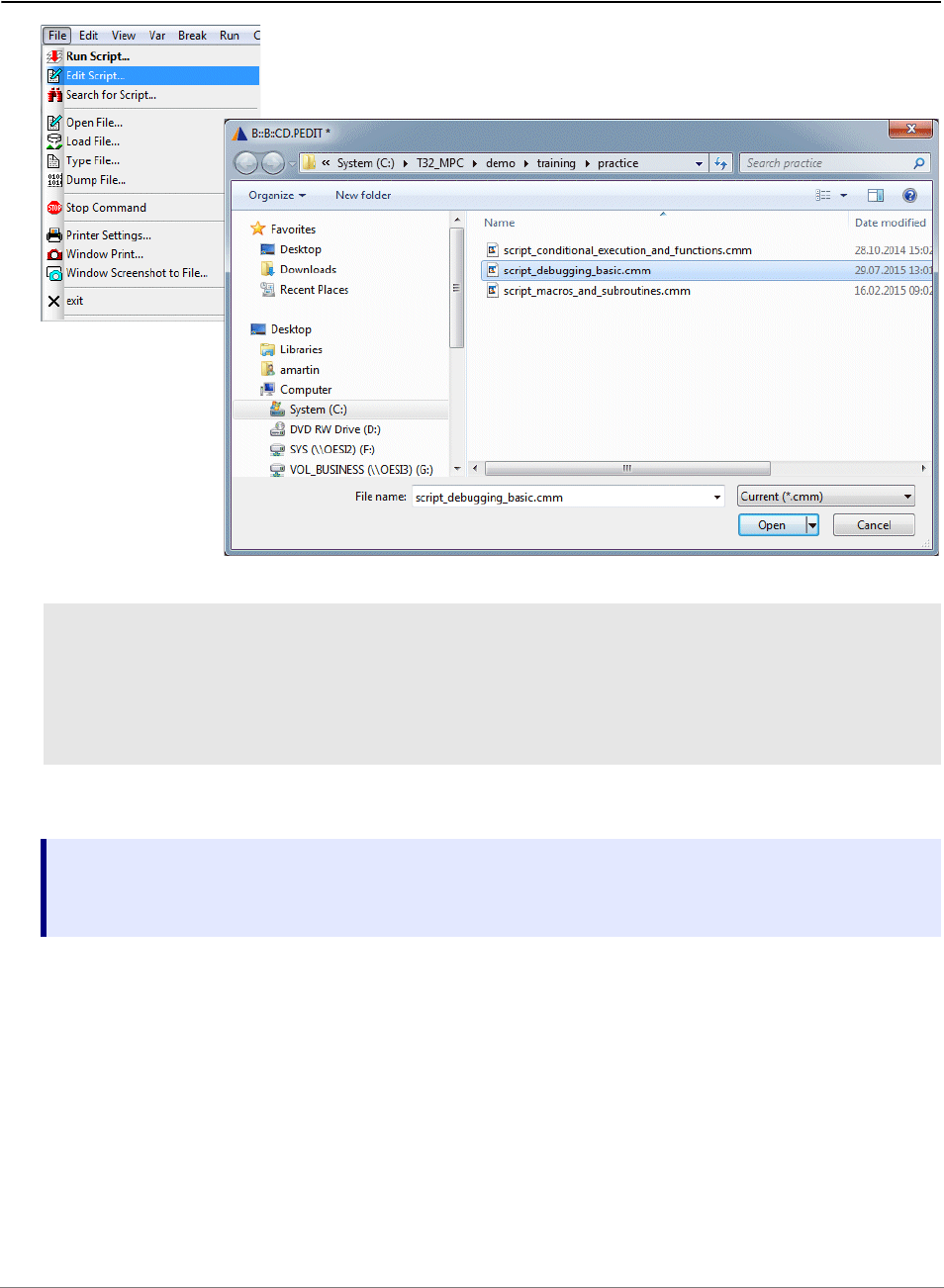
Training Script Language PRACTICE | 16
©
1989-2024 Lauterbach
Script Editor PEDIT
CD.PEDIT * // "*" opens a file browser for script
// selection
// TRACE32 first changes to the directory
// where the selected script is located and
// then opens the script in a PEDIT window
ChDir.PEDIT <filename> Change to the directory where the script <filename> is located and
open script in script editor PEDIT.
PEDIT <filename> Open script <filename> in script editor PEDIT.
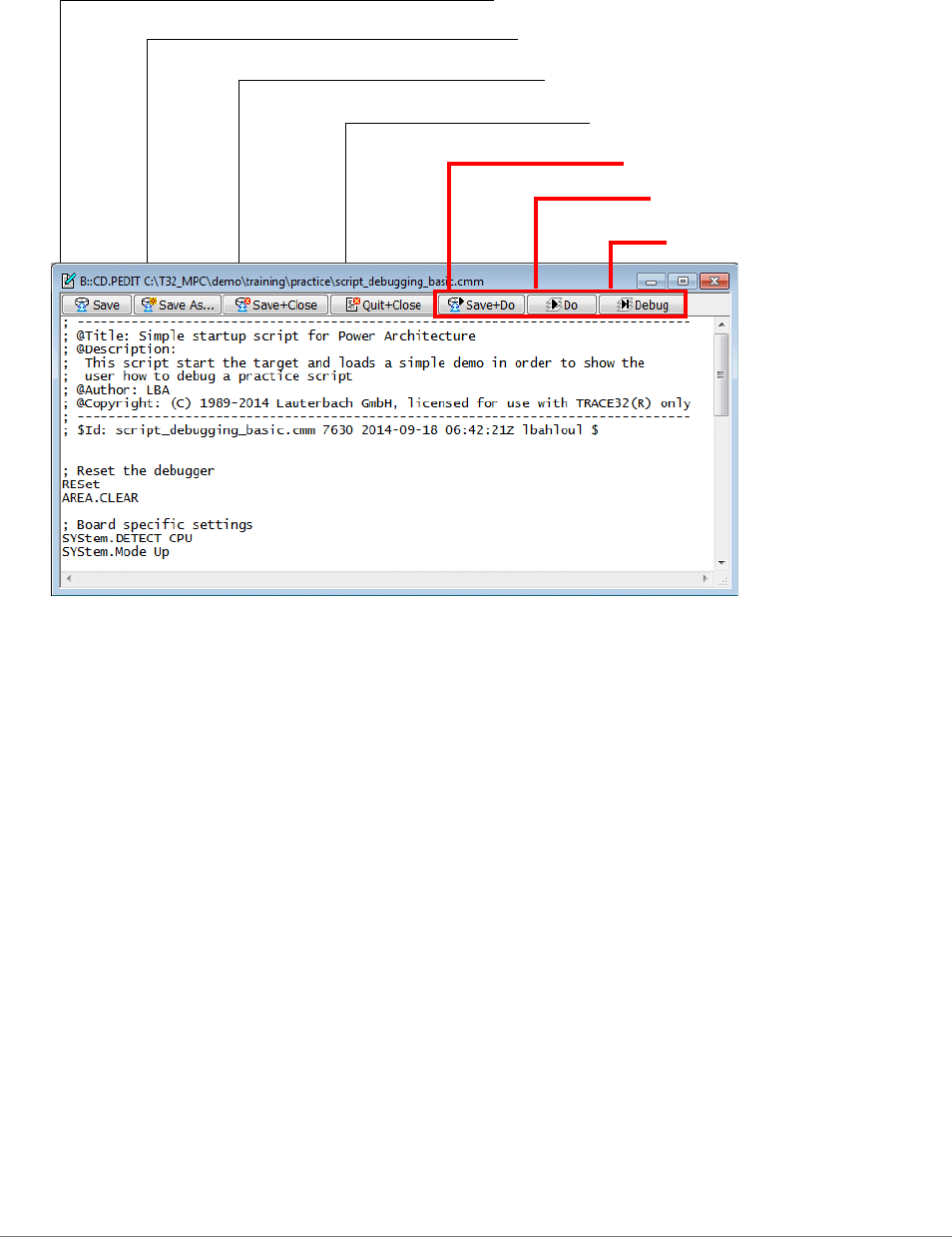
Training Script Language PRACTICE | 17
©
1989-2024 Lauterbach
In addition to a standard editor, PEDIT provides the ability to start or to debug a script.
Start PRACTICE script
Save and then start PRACTICE script
Close and do not save PRACTICE script
Close and save PRACTICE script
Save PRACTICE script with a new name
Save PRACTICE script
Debug PRACTICE script
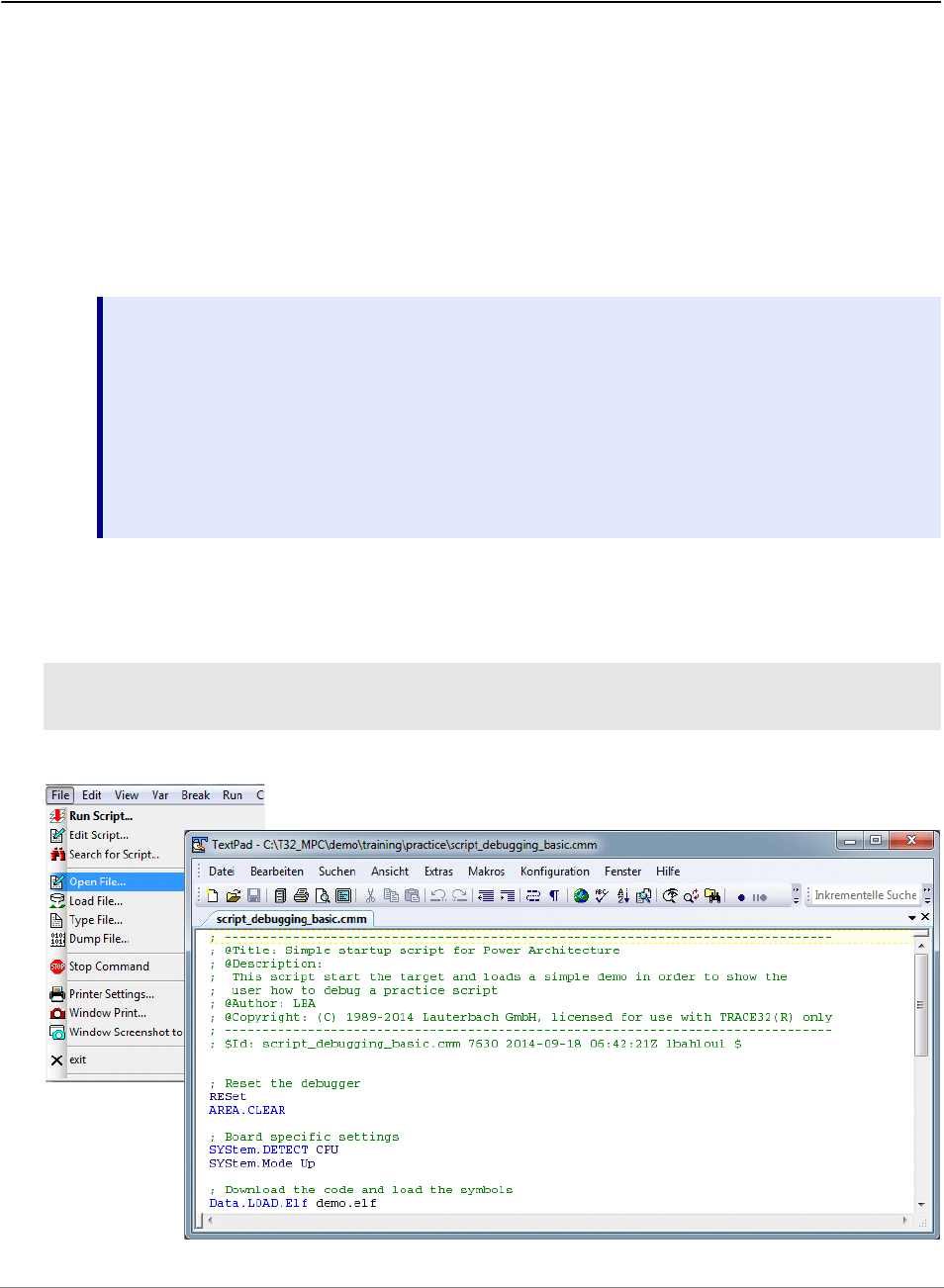
Training Script Language PRACTICE | 18
©
1989-2024 Lauterbach
Syntax Highlighting
In TRACE32, the PRACTICE script editor PEDIT provides syntax highlighting, configurable auto-indentation,
multiple undo and redo.
In addition to, or as an alternative to the built-in PRACTICE script editor PEDIT, you can work with an
external editor. To configure syntax highlighting for PRACTICE scripts in an external editor, take these steps:
1. Redirect the call of the TRACE32 editor EDIT to an external editor by using the TRACE32
command SETUP.EDITEXT.
2. Install the syntax highlighting files provided by Lauterbach for the external editor.
Lauterbach provides syntax highlighting files for some common text editors. Please refer to
~~/demo/practice/syntaxhighlighting for details. ~~ stands for the
<trace32_installation_directory>, which is c:/T32 by default.
EDIT <filename> Open file with standard TRACE32 editor.
SETUP.EDITEXT ON <command> Advise TRACE32 to use the specified external editor if
the EDIT command is used.
<command> contains the command that TRACE32
sends to your host OS to start the external editor. In this
string the following replacements will be made:
• * will be replaced by the actual file name.
• # will be replaced by the actual line number.
// Instruct TRACE32 to use TextPad when the EDIT command is used
SETUP.EDITEXT ON "C:\Program Files (x86)\TextPad 5\TextPad.exe ""* (#)"""
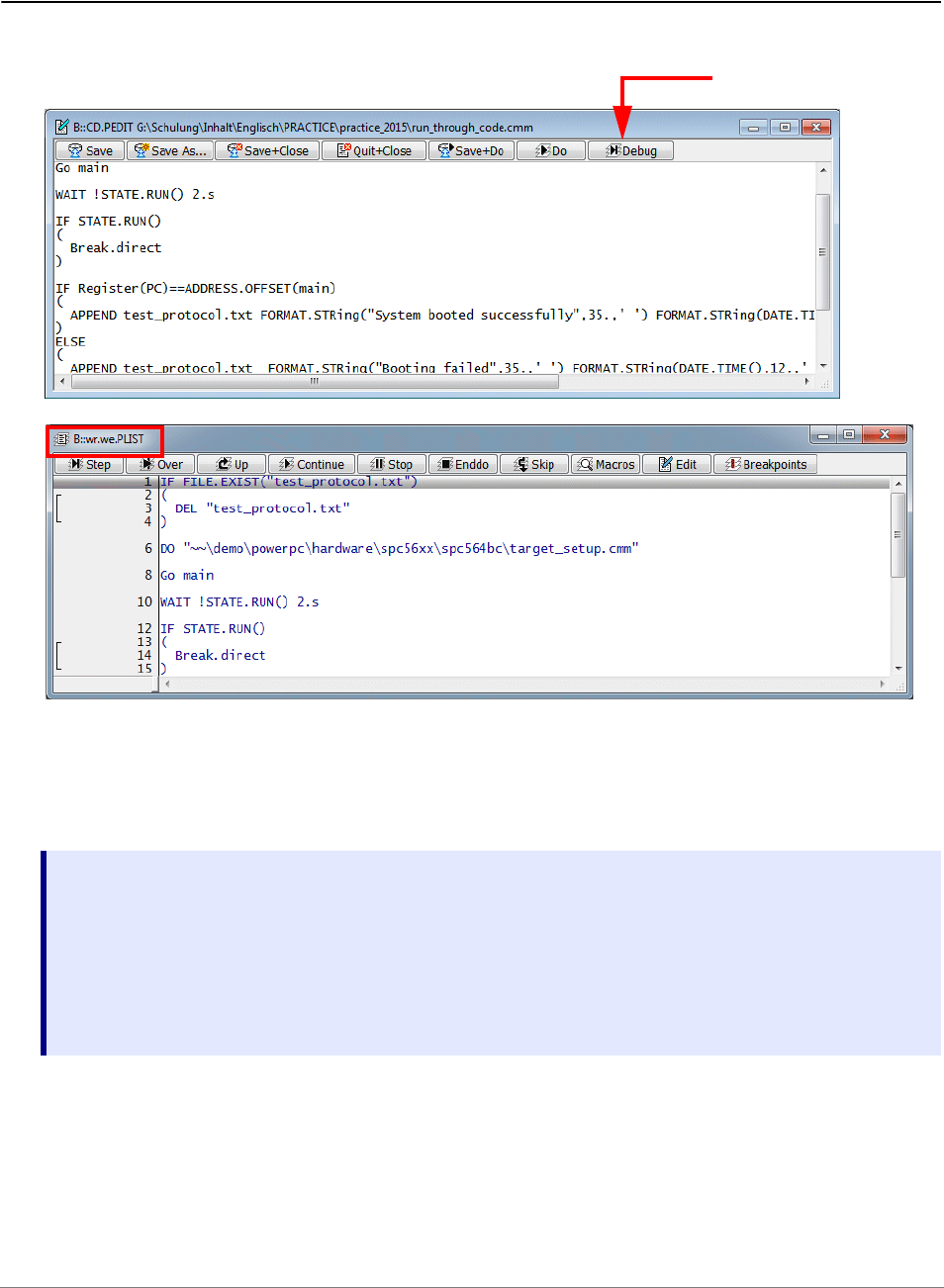
Training Script Language PRACTICE | 20
©
1989-2024 Lauterbach
Debug Environment
Explanation of the window header:
WinResist.WinExt.PLIST Display the currently loaded PRACTICE script.
WinResist: PEDIT window is not deleted by
command WinCLEAR.
WinExt: Detach PEDIT window from the
TRACE32 main window - even if TRACE32 is
operating in MDI window mode.
Use Debug to start the
debugger for the
PRACTICE script

Training Script Language PRACTICE | 21
©
1989-2024 Lauterbach
Command line commands:
PSTEP <filename> Start script in PRACTICE debugger.
ChDir.PSTEP <filename> TRACE32 first changes to the directory where
the script is located and then starts the script in
the PRACTICE debugger.
WinResist.WinExt.ChDir.PSTEP <filename>

Training Script Language PRACTICE | 22
©
1989-2024 Lauterbach
Local buttons in PLIST/PSTEP window
Step Single step PRACTICE script (command PSTEP).
Over Run called PRACTICE script or PRACTICE subroutine as a whole
(command PSTEPOVER).
Up End current PRACTICE script or subroutine and return to the caller
(command PSTEPOUT).
Continue Continue the execution of PRACTICE script (command
CONTinue).
Stop Stop the execution of the PRACTICE script (command STOP).
Enddo End the current PRACTICE script. Execution is continued in the
calling PRACTICE script. If no calling script exists, the PRACTICE
script execution is ended (command ENDDO).
Skip Skips the current command or block (command PSKIP)
Macros Display the PRACTICE stack (command PMACRO.list).
Edit Open PRACTICE editor PEDIT to edit the PRACTICE script
(command WinResist.WinExt.PEDIT).
Breakpoints Open a PBREAK.List window to display all PRACTICE
breakpoints.
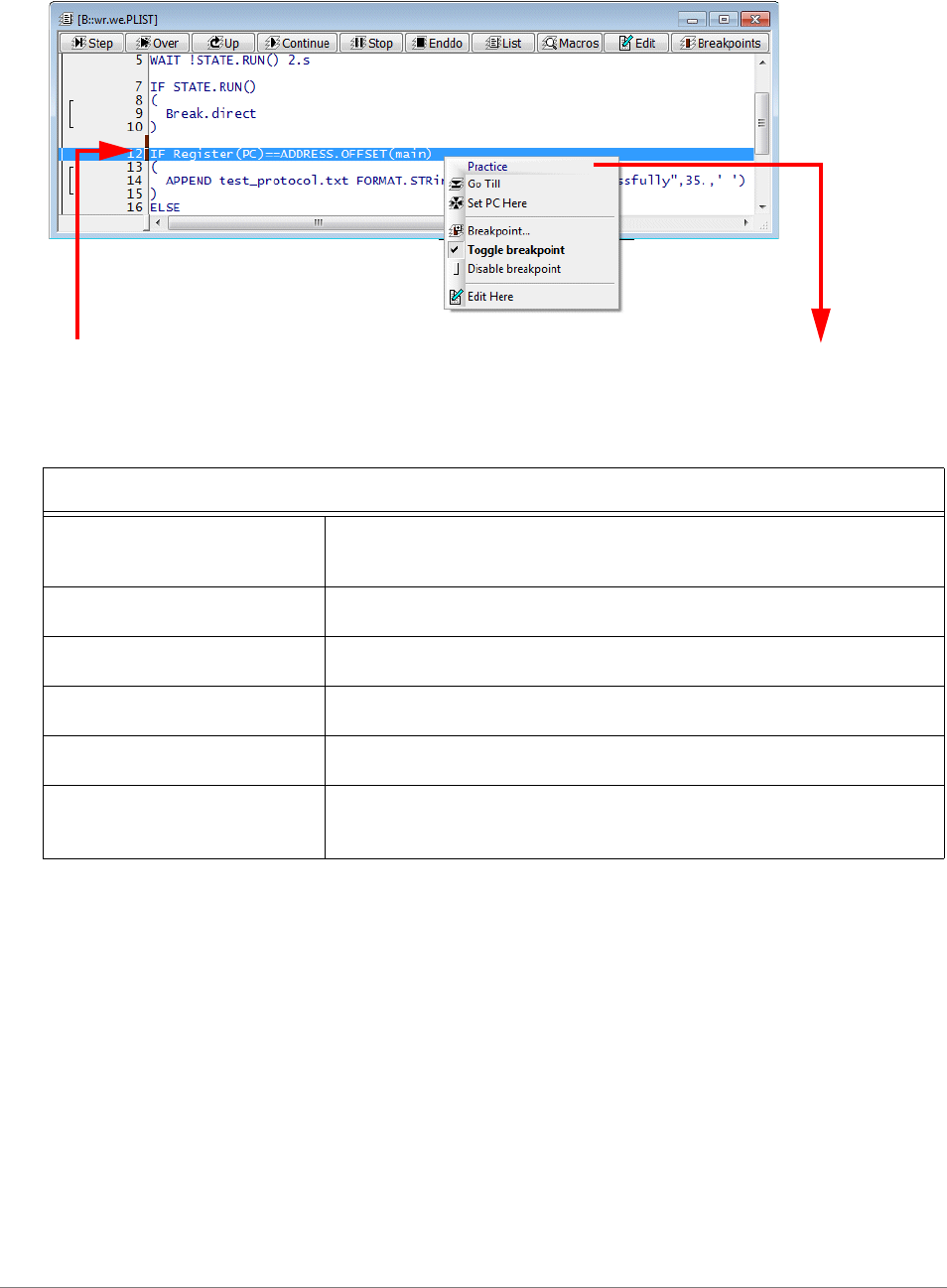
Training Script Language PRACTICE | 23
©
1989-2024 Lauterbach
PRACTICE debug-pull-down
Goto Till Run PRACTICE script until the selected line (command CONTinue
<line_number>).
Set PC Here Set PRACTICE PC to the selected line.
Breakpoint … Open PBREAK.Set dialog to configure PRACTICE breakpoint.
Toggle breakpoint Toggle PRACTICE breakpoint.
Disable breakpoint Disable PRACTICE breakpoint (command PBREAK.DISable).
Edit Here Open PRACTICE editor to edit the PRACTICE script. The cursor is
automatically set to the selected line.
PRACTICE breakpoint
Right-click for PRACTICE
in this line
debug-pull-down

Training Script Language PRACTICE | 24
©
1989-2024 Lauterbach
PRACTICE breakpoints can be set:
• to a specific line of a specified script
• to a specific line in any script (*)
Display the PRACTICE Stack
The PRACTICE stack displays the program nesting and the PRACTICE macros.
Display the PRACTICE-Stack

Training Script Language PRACTICE | 25
©
1989-2024 Lauterbach
PRACTICE Language
So far, we have seen that simple scripts can be created that can restore various settings to the current
debug session. PRACTICE provides a lot more capability than this; it is a fully featured language with its own
syntax and advanced features. This section will cover the language syntax, program elements, features and
functions. Examples of PRACTICE scripts can be found in ~~/demo/practice or at
https://www.lauterbach.com/scripts.html
Program Elements
Comments
Comments start with // or ; and end with the next line break.
Since the TRACE32 hll expression grammar allows ; to end an hll expression, ; has a special meaning for
the Var command group. Here a few examples.
So to be safe it is recommended to use // to start a comment.
Commands
There are three types of commands that can be used in PRACTICE scripts:
• All TRACE32 commands which are also used interactively in the command line
• Commands for flow control and conditional execution of PRACTICE scripts.
• I/O commands
Functions
Functions are used to retrieve information about the state of the target system or the state of the
development tool(s).
Var.View flags[3];ast.count;i
Var.Break.Set flags[3]; /Write /VarCONDition (flags[12]==0)
Register(<register_name>) Get the content of the specified CPU register.
Var.VALUE(<hll_expression>) Get the contents of an HLL expression.
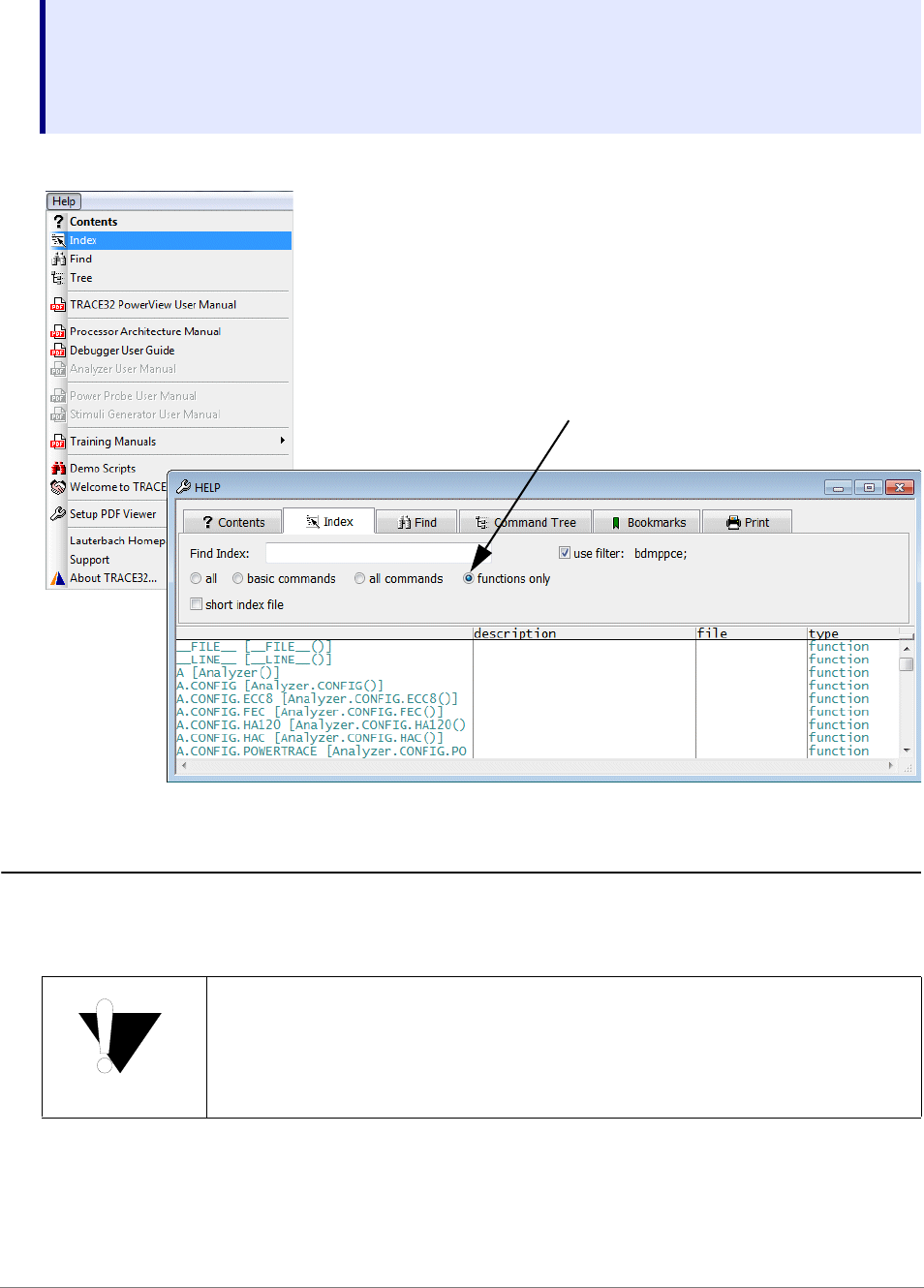
Training Script Language PRACTICE | 26
©
1989-2024 Lauterbach
A list of all available functions can be found in the online help:
Labels
Labels have to be entered in the first column and they end with “:”. For more information on labels please
refer to the section on subroutines.
STATE.RUN() Returns true if program is running on the target, returns false
if program execution is stopped.
OS.PresentWorkingDirectory() Returns the name of the current working directory as a string.
CONVert.CHAR(<value>) Converts an integer value to an ASCII character.
It is recommended to avoid unnecessary blanks. Unnecessary blanks can lead
to a misinterpretation of PRACTICE commands.
Select functions only
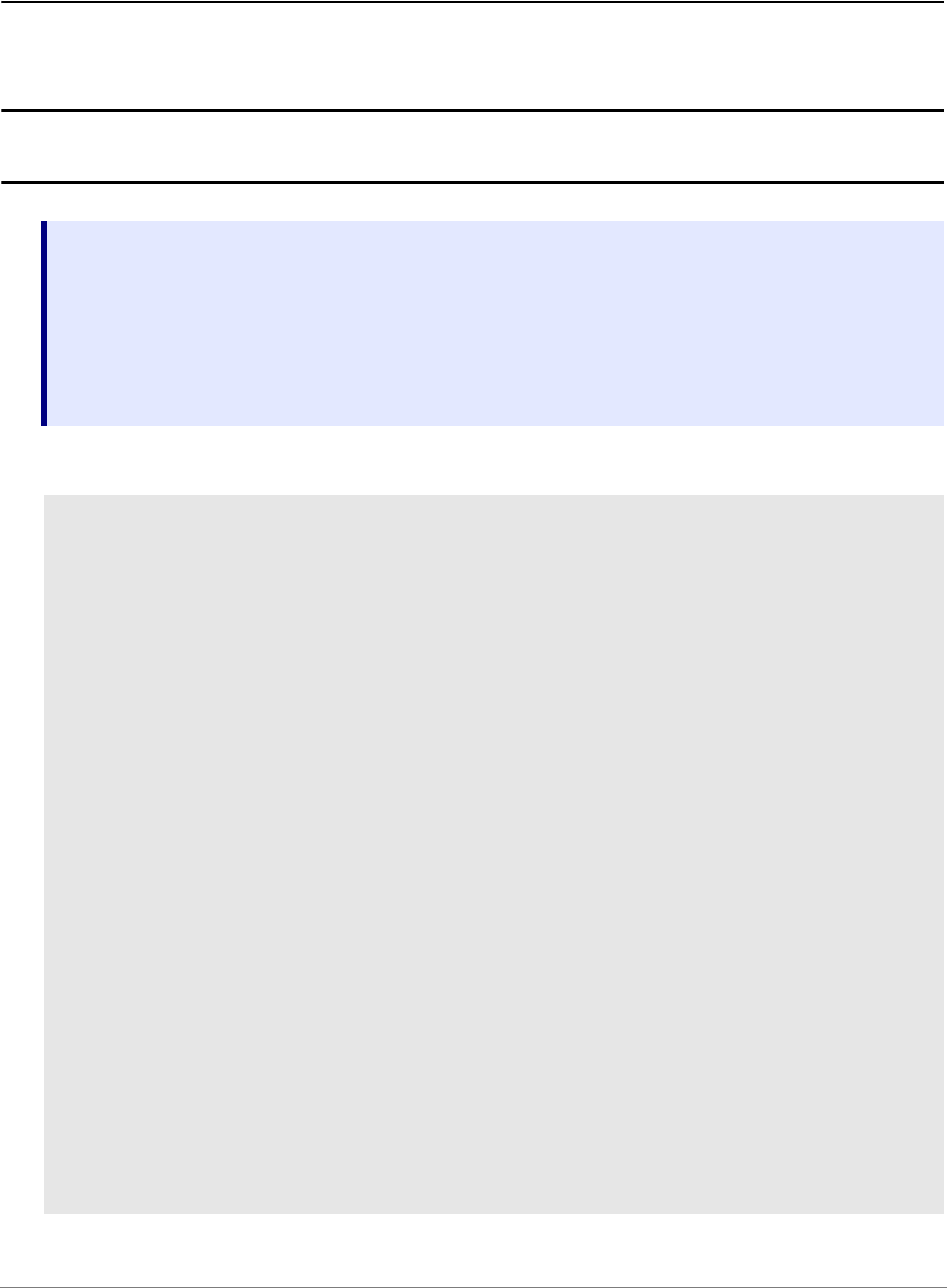
Training Script Language PRACTICE | 27
©
1989-2024 Lauterbach
PRACTICE Flow Control
Conditional Program Execution
Command List
IF <condition>
(
<if_block>
)
ELSE
(
<else_block>
)
Execute <if_block> if <condition> is true. Execute <else_block>
otherwise.
<condition> has to be specified in TRACE32 syntax.
// Script double_if.cmm
PRIVATE &testfunc &correct_result
OPEN #1 "func_test.txt" /READ
WHILE TRUE()
(
READ #1 &testfunc &correct_result
IF "&testfunc"!=""
(
IF Var.VALUE(&testfunc)==&correct_result
(
APPEND "test_protocol.txt"\
FORMAT.STRing("&testfunc=&correct_result",50.,' ')\
FORMAT.UnixTime("c",DATE.UnixTime(),DATE.utcOffSet())
)
ELSE
(
PRIVATE &result
&result=CONVert.HEXTOINT(Var.VALUE(&testfunc))
APPEND "test_protocol.txt"\
FORMAT.STRing("&testfunc failed with &result (&correct_result)",50.,' ')\
FORMAT.UnixTime("c",DATE.UnixTime(),DATE.utcOffSet())
)
)
ELSE
(
CLOSE #1
ENDDO
)
)
ENDDO
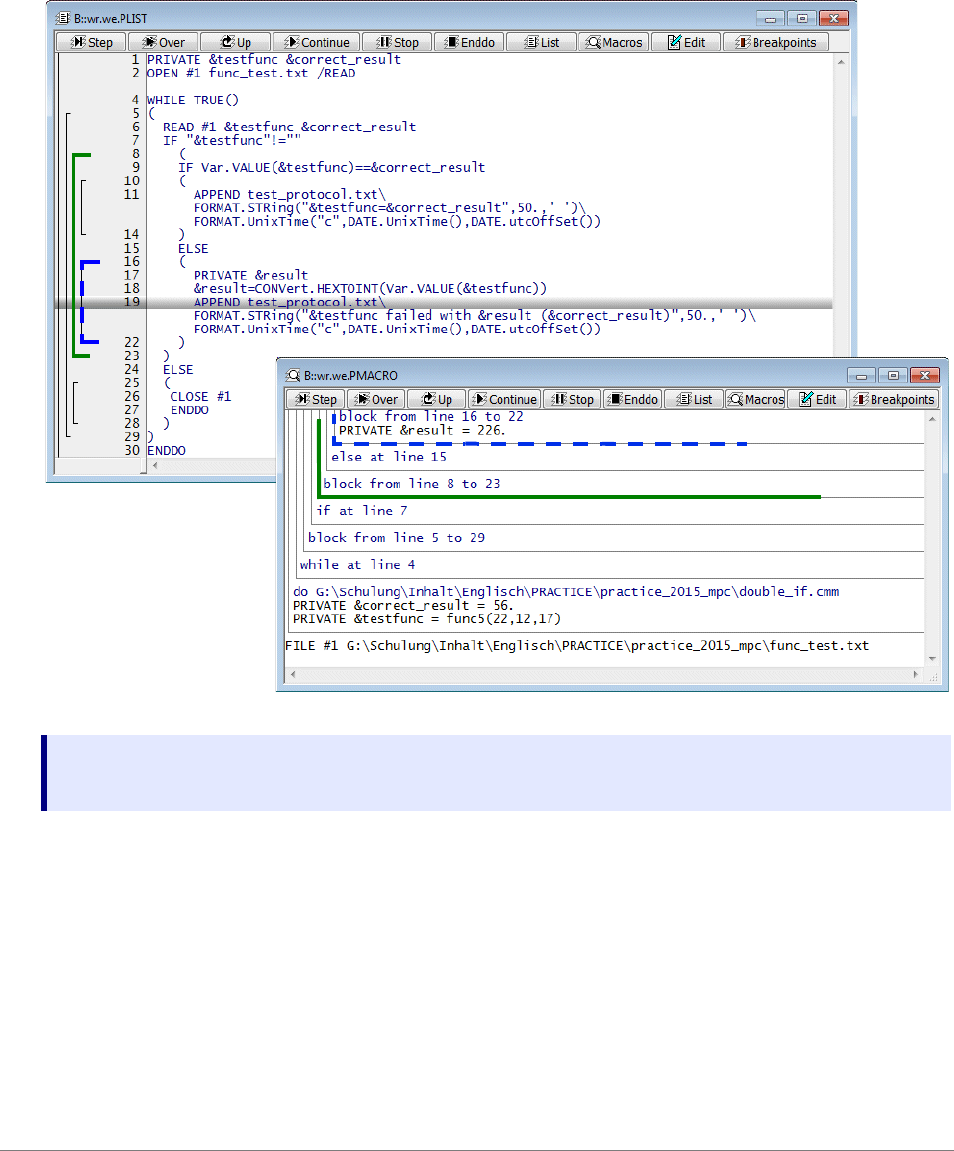
Training Script Language PRACTICE | 28
©
1989-2024 Lauterbach
If script lines are too long they can be split by adding a space and the ’\’ character at the end.
To better understand the scope of PRACTICE macros given later in this training, it is important to know how
TRACE32 maintains information on the PRACTICE stack.
TRACE32 adds a new block-frame to the PRACTICE stack, whenever instructions are blocked by round
brackets.
PLIST List PRACTICE script that is currently being executed.
PMACRO.list List PRACTICE stack.

Training Script Language PRACTICE | 29
©
1989-2024 Lauterbach
Var.IF <hll_condition>
(
<if_block>
)
ELSE
(
<if_block>
)
Execute <if_block> if <hll_condition> is true. Execute <else_block>
otherwise.
<hll_condition> has to be written in the syntax of the programming
language used.
; Var.IF example
Var.IF (flags[0]==flags[5])
PRINT "Values are equal."
ELSE
PRINT "Values do not match."
ENDDO
WHILE <condition>
(
<block>
)
Execute <block> while <condition> is true.
<condition> has to be specified in TRACE32 syntax.
Var.WHILE <hll_condition>
(
<block>
)
Execute <block> while <hll_condition> is true.
<hll_condition> has to be written in the syntax of the programming
language used.
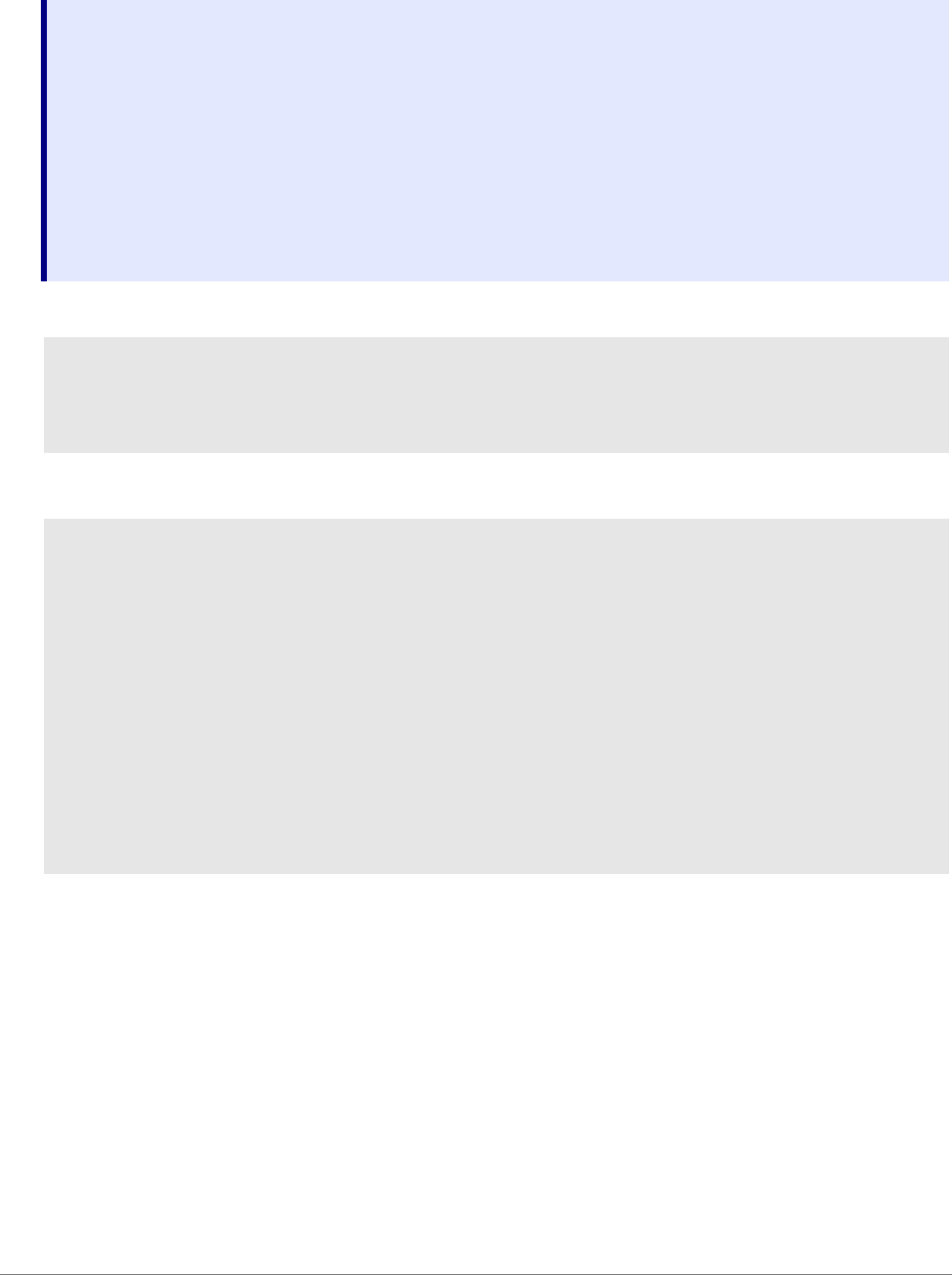
Training Script Language PRACTICE | 30
©
1989-2024 Lauterbach
RePeaT <count> <command> Repeat <command> <count>-times.
RePeaT <count>
(
<block>
)
Repeat <block> <count>-times.
RePeaT
(
<block>
)
WHILE <condition>
Repeat the <block> whilst the <condition> evaluates to a
boolean TRUE.
;Example 1
;Print the character X 100 times
AREA.view
RePeaT 100. PRINT "X"
;Example 2
Var.Break.Set flags /Write //Set a Write breakpoint to array
//flags
;Repeat the following 10 times
;Start the program and wait until the target halts at the breakpoint.
;Then export the contents of array flags to file flags_export.csv in CSV
;format.
RePeaT 10.
(
Go
WAIT !STATE.RUN()
Var.EXPORT "flags_export.csv" flags /Append
)

Training Script Language PRACTICE | 31
©
1989-2024 Lauterbach
;Example 3
;Read a line from my_strings.txt
;Write not-empty lines to file my_strings_noempty.txt
PRIVATE &CurrentLine &RightLine
OPEN #1 my_strings.txt /Read
OPEN #2 my_strings_noempty.txt /Create
AREA.view
RePeaT
(
READ #1 %LINE &CurrentLine
IF (!FILE.EOFLASTREAD()&&("&CurrentLine"!=””))
WRITE #2 "&CurrentLine"
)
WHILE !FILE.EOFLASTREAD()
CLOSE #1
CLOSE #2
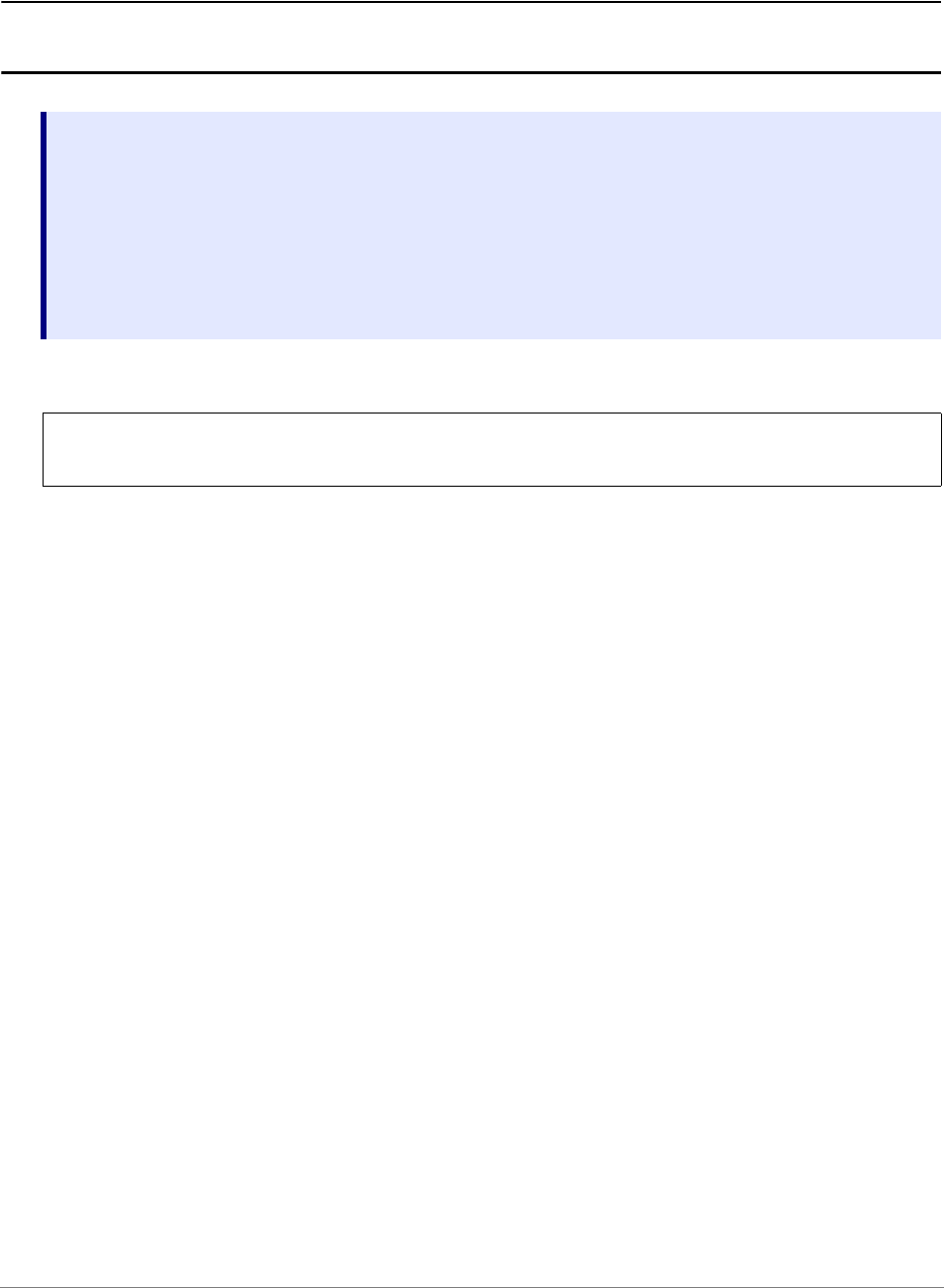
Training Script Language PRACTICE | 32
©
1989-2024 Lauterbach
Subroutine Calls
Command List
GOSUB <label> [<parameter_list>]
…
ENDDO
<label>
(
<block>
RETURN
)
Call subroutine specified by <label> with an
optional set of paramters..
Execute <block> and RETURN to caller.
NOTE: Labels must start in the first column of a line and end with a colon. No
preceding white space allowed.

Training Script Language PRACTICE | 33
©
1989-2024 Lauterbach
Example
// Script test_func_param.cmm
LOCAL &testfunc &correct_result
OPEN #1 func_test.txt /READ
WHILE TRUE()
(
READ #1 &testfunc &correct_result
IF "&testfunc"!=""
(
GOSUB perform_test
)
ELSE
(
CLOSE #1
ENDDO
)
)
ENDDO
perform_test:
(
IF Var.VALUE(&testfunc)==&correct_result
(
APPEND test_protocol.txt\
FORMAT.STRing("&testfunc=&correct_result",50.,' ')\
FORMAT.UnixTime("c",DATE.UnixTime(),DATE.utcOffSet())
)
ELSE
(
PRIVATE &result
&result=CONVert.HEXTOINT(Var.VALUE(&testfunc))
APPEND test_protocol.txt\
FORMAT.STRing("&testfunc failed with &result (&correct_result)",50.,' ')\
FORMAT.UnixTime("c",DATE.UnixTime(),DATE.utcOffSet())
)
RETURN
)
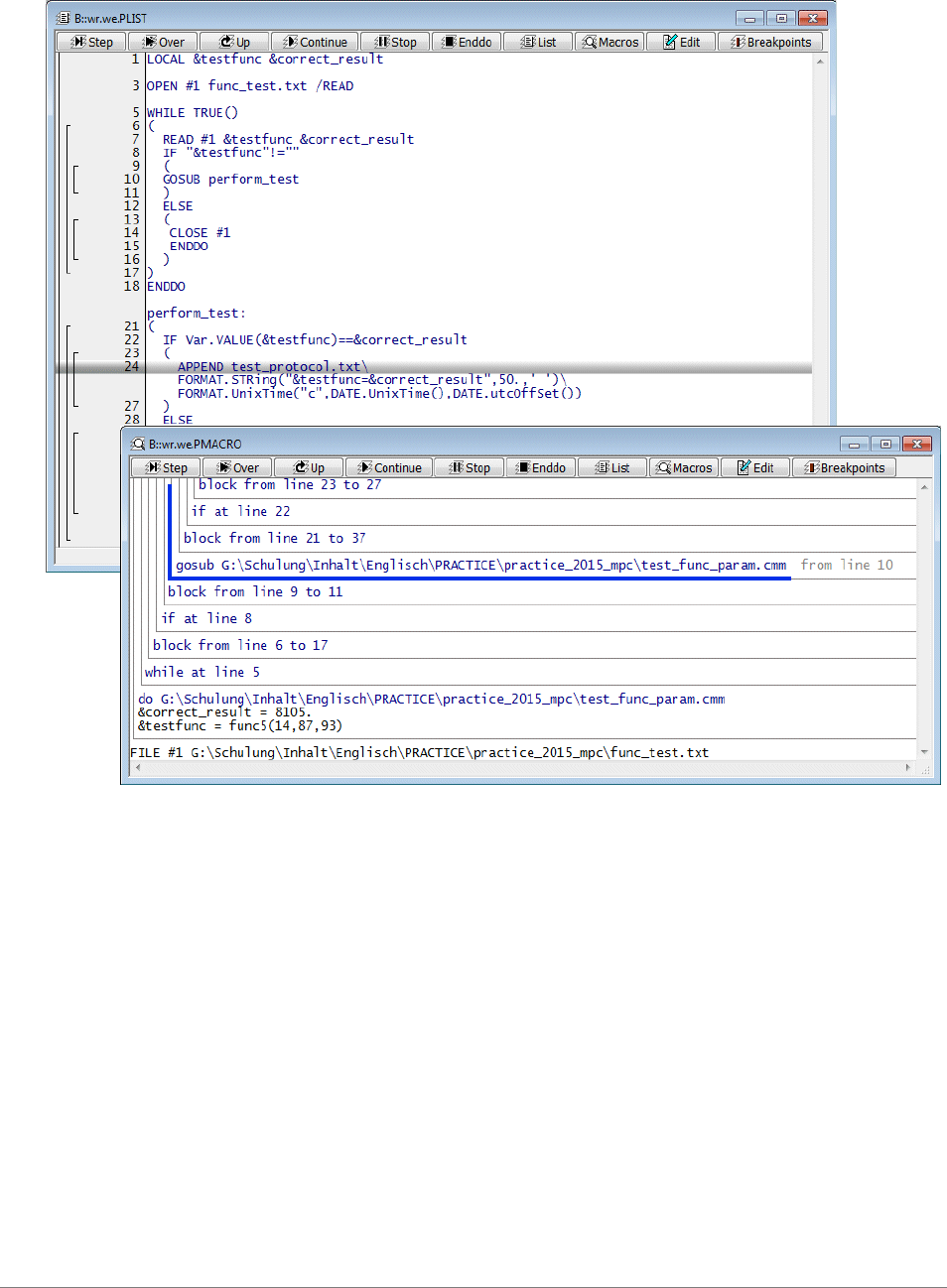
Training Script Language PRACTICE | 34
©
1989-2024 Lauterbach
TRACE32 adds a new gosub-frame to the PRACTICE stack whenever a subroutine is called.
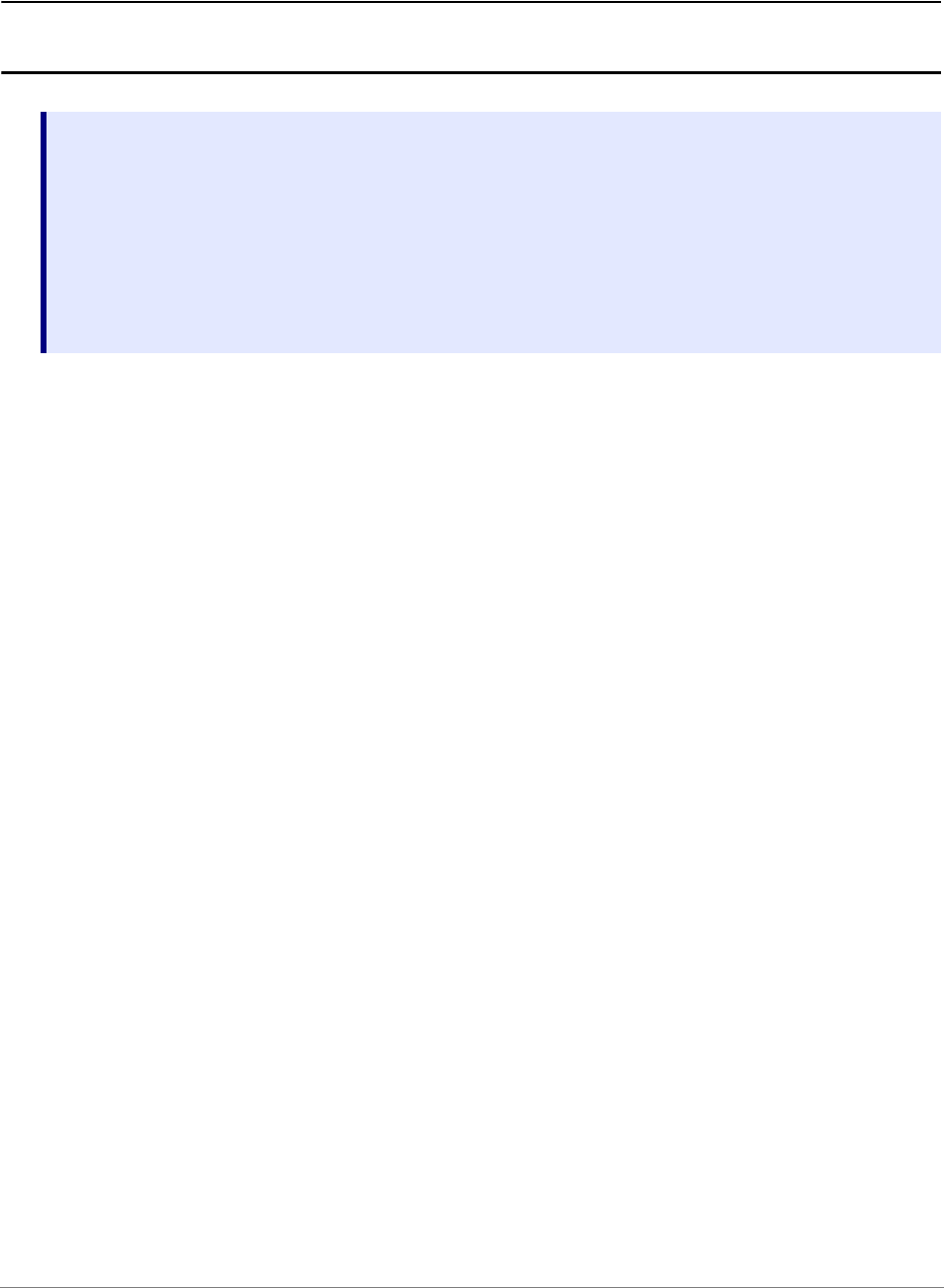
Training Script Language PRACTICE | 35
©
1989-2024 Lauterbach
GOTO/JUMPTO
Command List
GOTO <label> Continue PRACTICE script at <label>.
<label> must be part of the currently executing script.
JUMPTO <label> Continue PRACTICE script at <label>.
<label> must be part of a script that is currently located on the
PRACTICE stack. <label> must not be located in a block.
The PRACTICE stack is cleaned up accordingly.
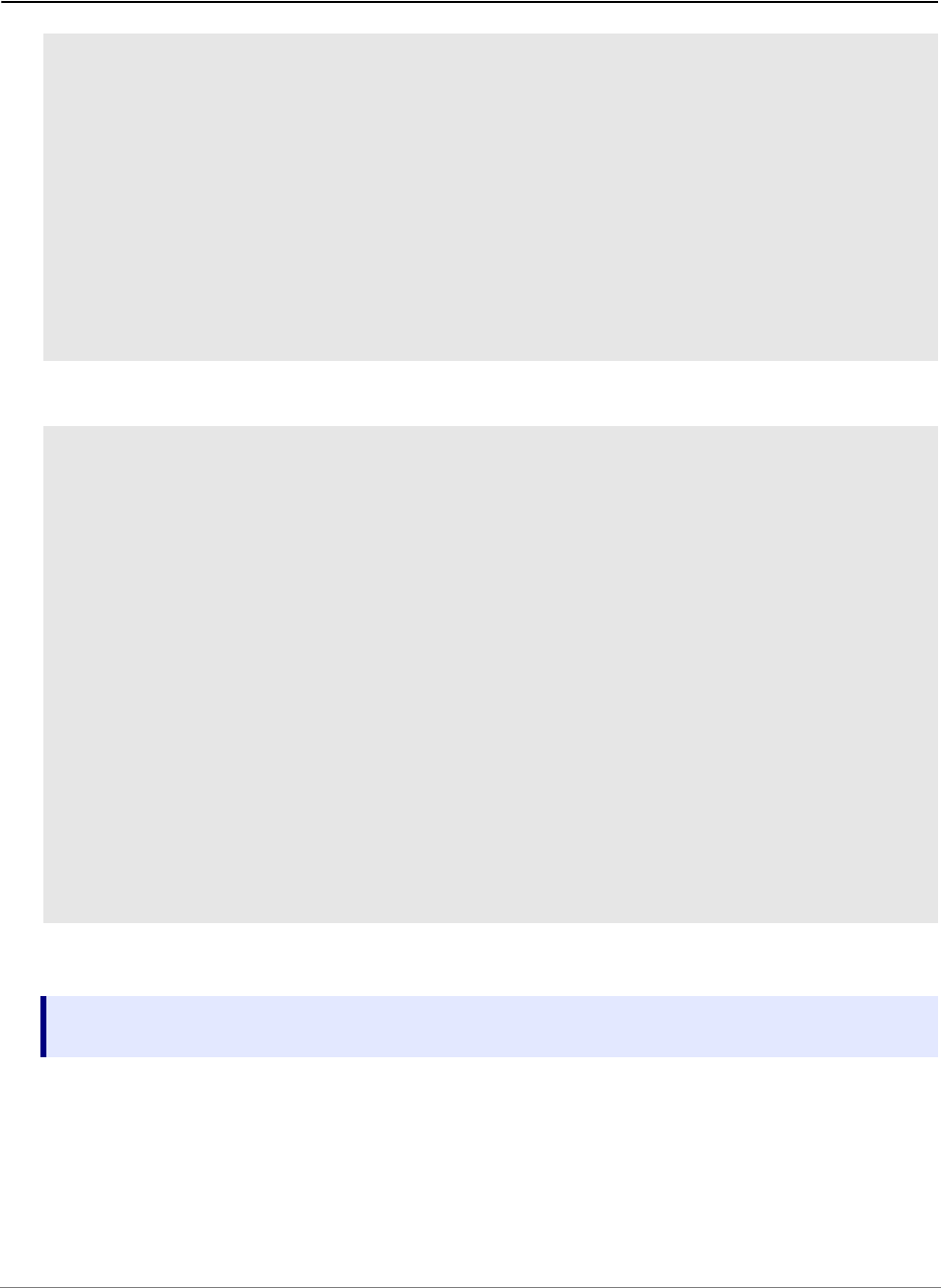
Training Script Language PRACTICE | 36
©
1989-2024 Lauterbach
Example
// Script test_sequence.cmm
DO target_setup.cmm
DO check_boot.cmm
ENDDO
terminate_script:
(
DIALOG.OK "Script terminated by test failure"
ENDDO
)
// Script check_boot.cmm
Go main
WAIT !STATE.RUN() 2.s
IF STATE.RUN()
(
Break.direct
)
IF Register(PC)==ADDRESS.OFFSET(main)
(
APPEND test_protocol.txt FORMAT.STRing("System booted successfully",70.,' ') \
FORMAT.UnixTime("c",DATE.UnixTime(),DATE.utcOffSet())
)
ELSE
(
APPEND test_protocol.txt FORMAT.STRing("Booting failed",70.,' ') \
FORMAT.UnixTime("c",DATE.UnixTime(),DATE.utcOffSet())
JUMPTO terminate_script
)
DIALOG.OK <text> Create a dialog that provides a <text>-message to the user. The script
execution is stopped until the user pushes the OK button in the dialog.
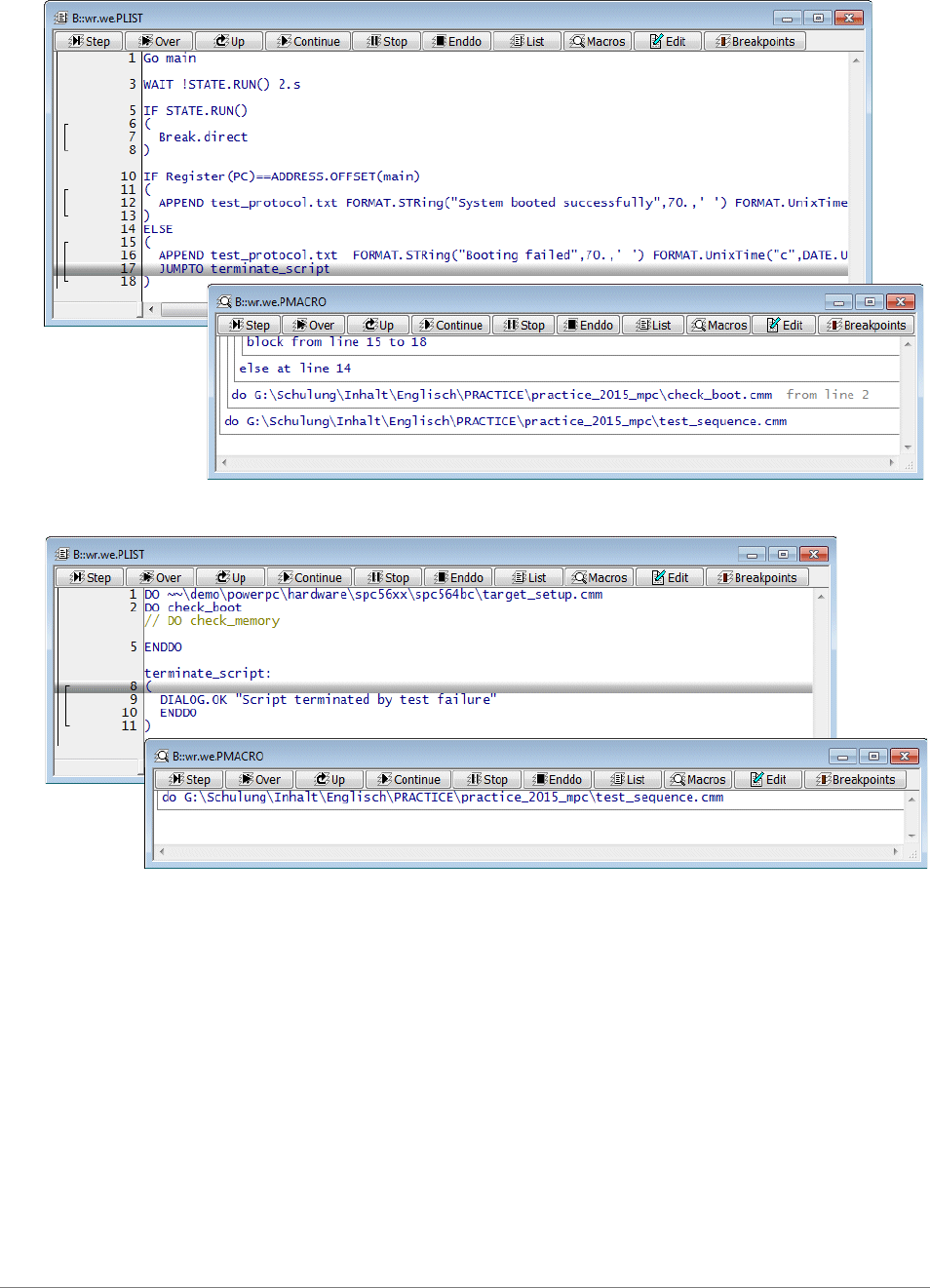
Training Script Language PRACTICE | 37
©
1989-2024 Lauterbach
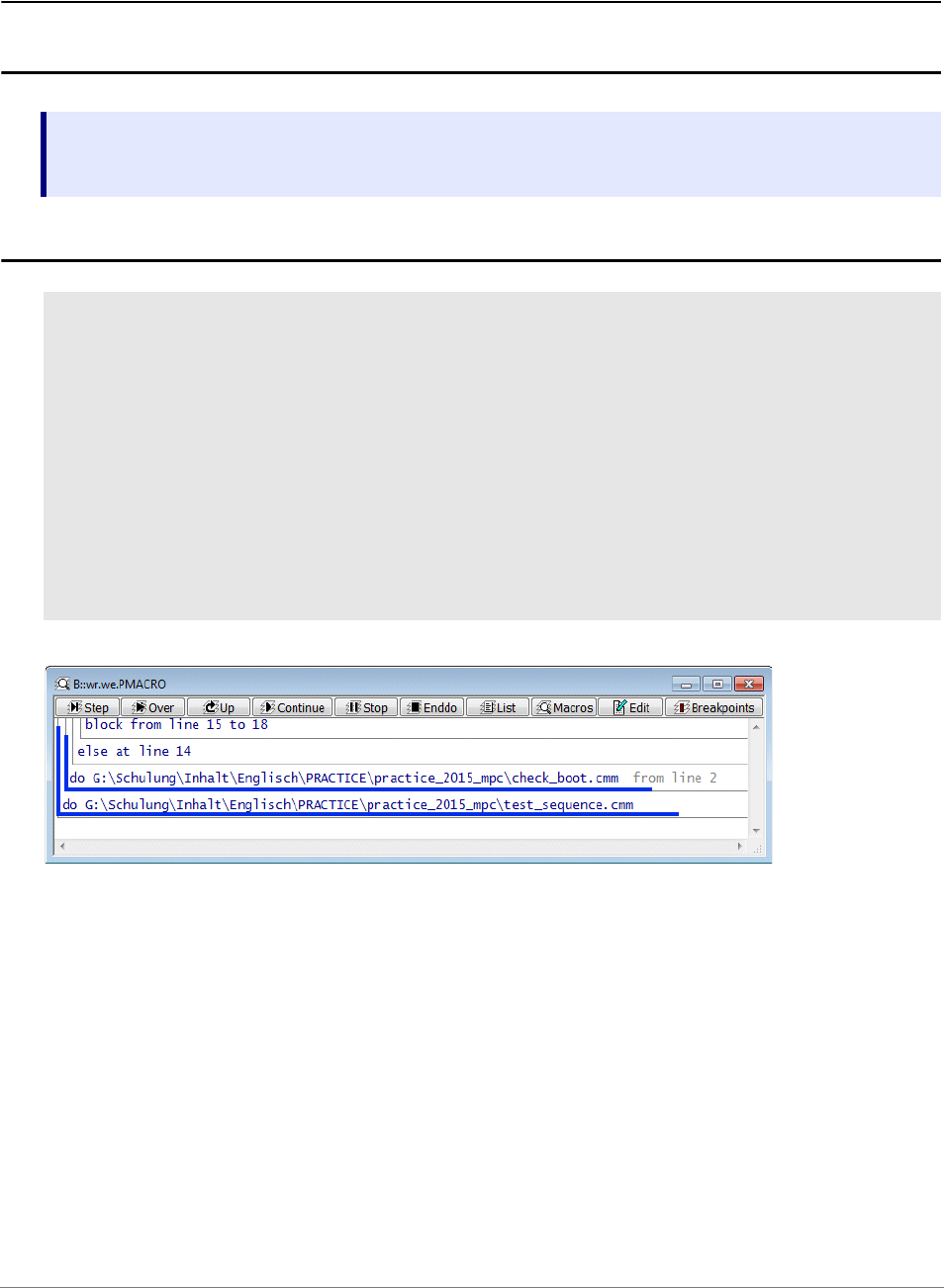
Training Script Language PRACTICE | 38
©
1989-2024 Lauterbach
Script Calls
Command List
Example
TRACE32 adds a new do-frame to the PRACTICE stack whenever a script is started
DO <script> [<parameter_list>] A script can be started from the command line or
called within a script.
Optional parameters can be passed to the script.
// Script test_sequence.cmm
DO target_setup.cmm
DO check_boot.cmm
ENDDO
terminate_script:
(
DIALOG.OK "Script terminated by test failure"
ENDDO
)
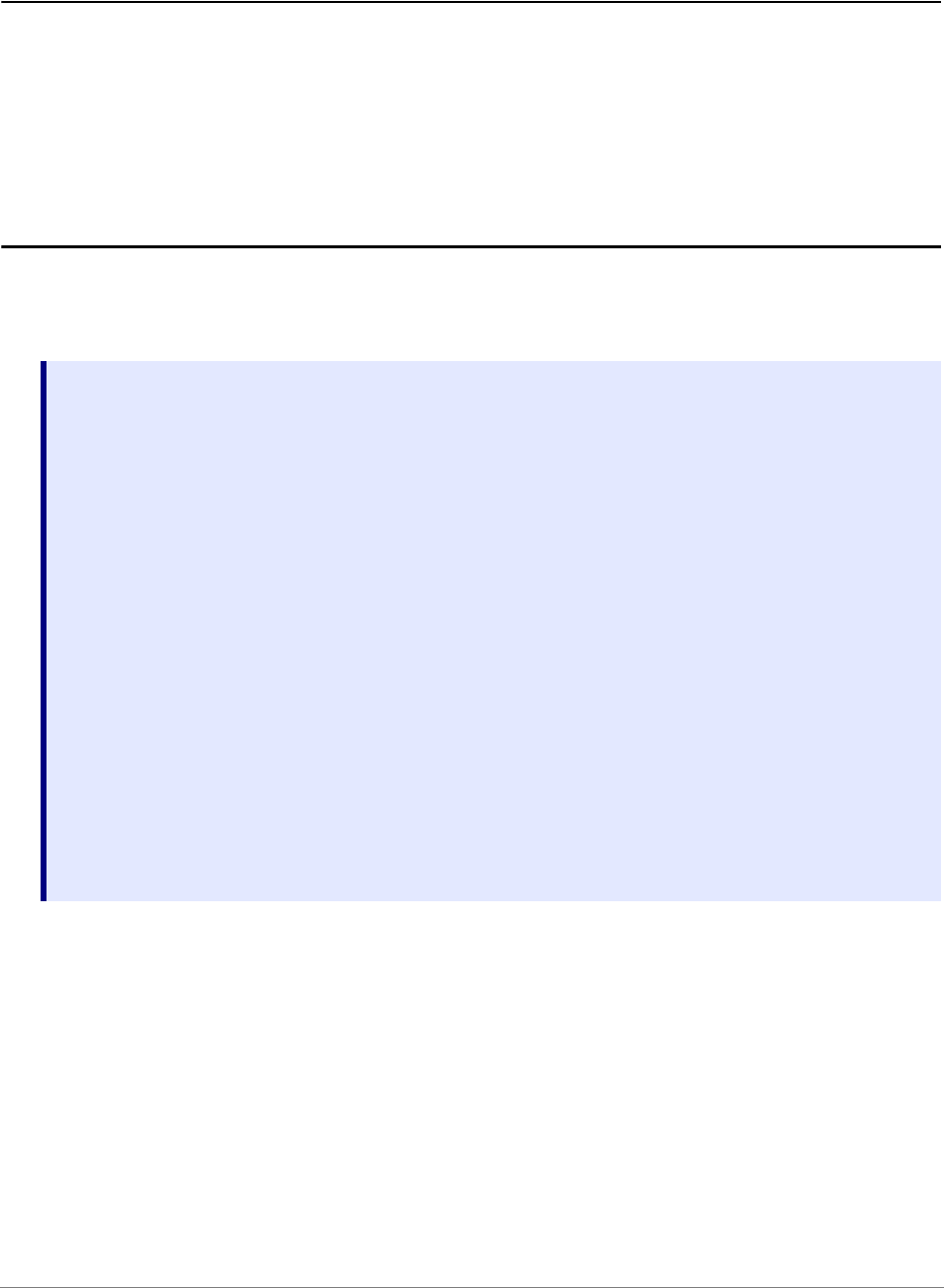
Training Script Language PRACTICE | 39
©
1989-2024 Lauterbach
PRACTICE Macros
Macros are the variables of the script language PRACTICE. They work as placeholders for a sequence of
characters.
Macro names in PRACTICE always start with an ampersand sign (‘&’), followed by a sequence of letters (a-
z, A-Z), numbers (0-9) and the underscore sign (’_’). The first character after the & sign must not be a
number. Macro names are case sensitive, so &a is different from &A.
Declare a Macro
Empty PRACTICE macros can be declared along with their scope by using one of the following PRACTICE
commands:
PRIVATE {<macro>} Create PRIVATE macros.
PRIVATE macros are visible in the script, subroutine or block in which
they are created. And they are removed when the script, subroutine or
block ends.
They are visible in nested blocks, but not in called subroutines and
called scripts.
LOCAL {<macro>} Create LOCAL macros.
LOCAL macros are visible in the script, subroutine or block in which
they are created. And they are removed when the script, subroutine or
block ends.
They are visible in nested blocks, in called subroutines and called
scripts.
GLOBAL {<macro>} Create GLOBAL macros.
GLOBAL macros are visible to all scripts, subroutines and blocks until
they are explicitly removed by the command PMACRO.RESet. They
can only be removed if no script is running.

Training Script Language PRACTICE | 40
©
1989-2024 Lauterbach
What happens if a PRACTICE macro is used, but not declared?
The PRACTICE interpreter will implicitly declare a new LOCAL macro when an assignment is done and
cannot find a macro of that name in the current scope.
The command PMACRO.EXPLICIT advises the PRACTICE interpreter to generate an error if a PRACTICE
macro is used in an assignment, but was not declared in advance. It also advises the PRACTICE interpreter
to generate an error if the same macro was intentionally created a second time within its scope.
// Script test_func_param.cmm
LOCAL &testfunc &correct_result
OPEN #1 "func_test.txt" /READ
WHILE TRUE()
(
READ #1 &testfunc &correct_result
IF "&testfunc"!=""
(
GOSUB perform_test
)
ELSE
(
CLOSE #1
ENDDO
)
)
ENDDO
perform_test:
(
IF Var.VALUE(&testfunc)==&correct_result
(
APPEND "test_protocol.txt"\
FORMAT.STRing("&testfunc=&correct_result",50.,' ')\
FORMAT.UnixTime("c",DATE.UnixTime(),DATE.utcOffSet())
)
ELSE
(
PRIVATE &result
&result=CONVert.HEXTOINT(Var.VALUE(&testfunc))
APPEND "test_protocol.txt"\
FORMAT.STRing("&testfunc failed with &result (&correct_result)",50.,' ')\
FORMAT.UnixTime("c",DATE.UnixTime(),DATE.utcOffSet())
)
RETURN
)
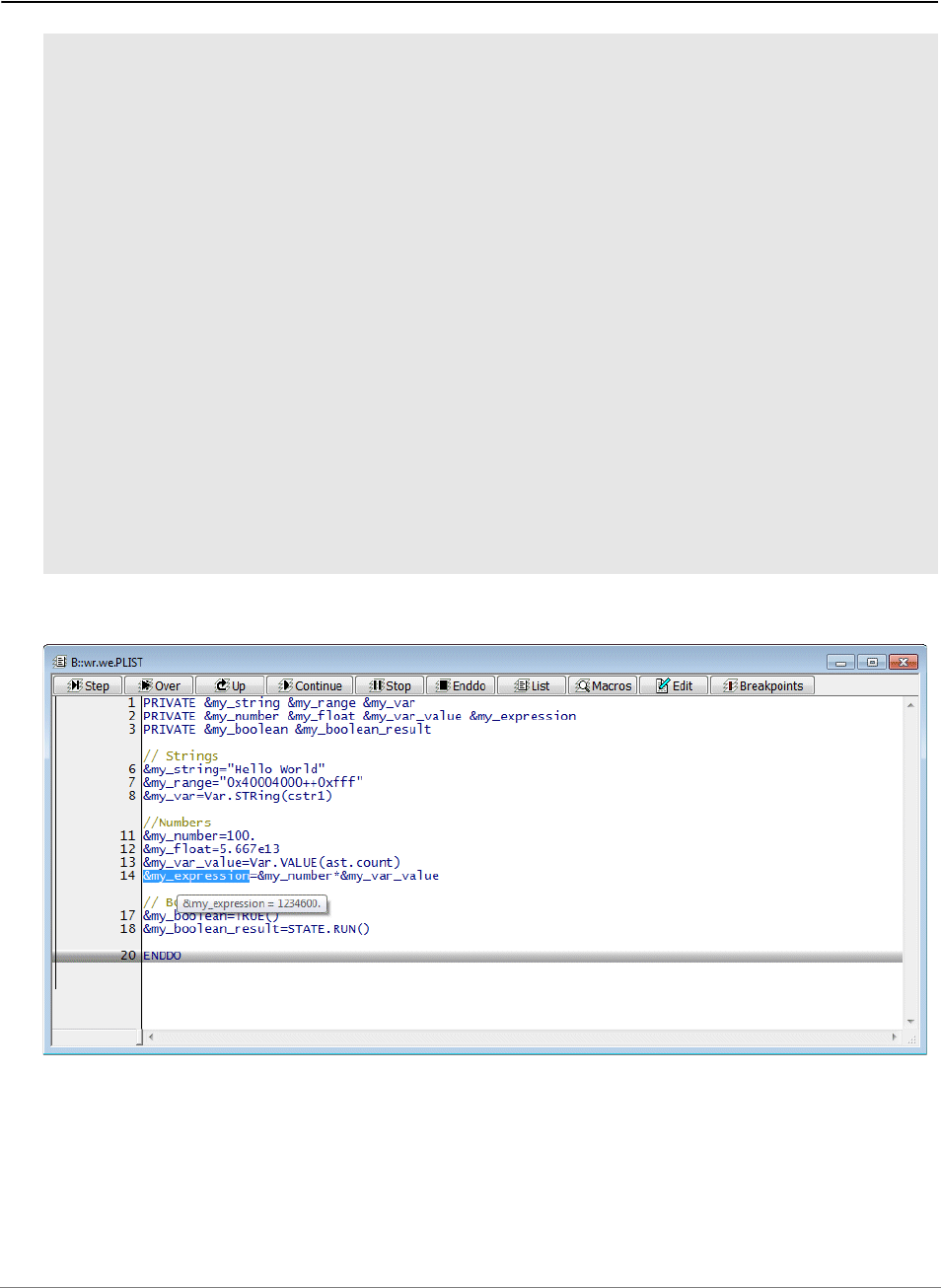
Training Script Language PRACTICE | 41
©
1989-2024 Lauterbach
Assign Content to a Macro
After a content is assigned to a macro, tooltips allows to inspect its current content.
// Script
PRIVATE &my_string &my_range &my_var
PRIVATE &my_number &my_float &my_var_value &my_expression
PRIVATE &my_boolean &my_boolean_result
// Assign a string
&my_string="Hello World"
&my_range="0x40004000++0xfff"
&my_var=Var.STRing(cstr1)
// Assign a numbers
&my_number=100.
&my_float=5.667e13
&my_var_value=Var.VALUE(ast.count)
&my_expression=&my_number*&my_var_value
// Assign a boolean
&my_boolean=TRUE()
&my_boolean_result=STATE.RUN()
ENDDO
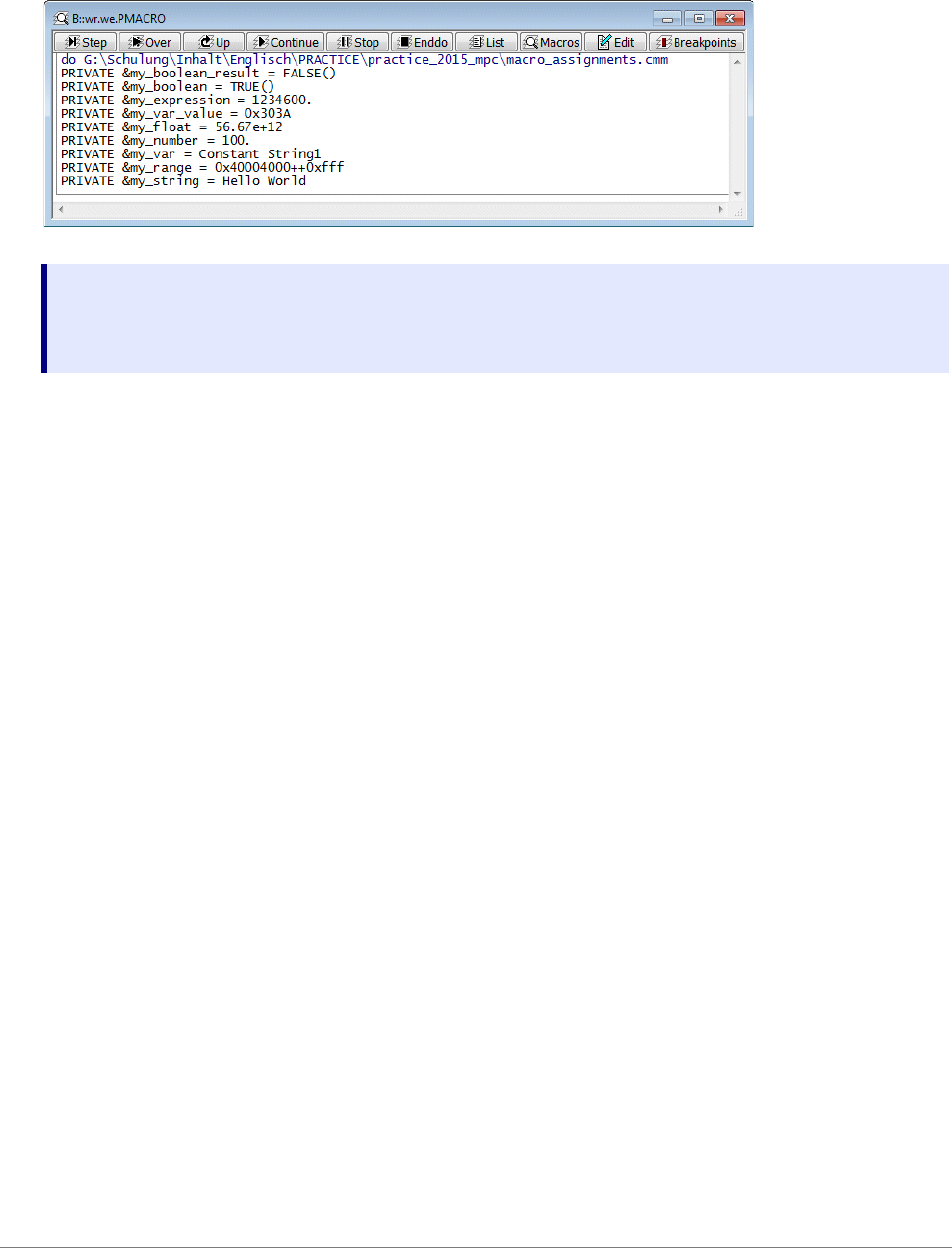
Training Script Language PRACTICE | 42
©
1989-2024 Lauterbach
The PRACTICE stack provide an overview for all macros.
The keyword PRIVATE is used to identify PRIVATE macros.
Var.STRING(<hll_expression>) Returns a zero-terminated string, if <hll_expression> is a
pointer to character or an array of characters.
Returns a string that represents the variable contents
otherwise.
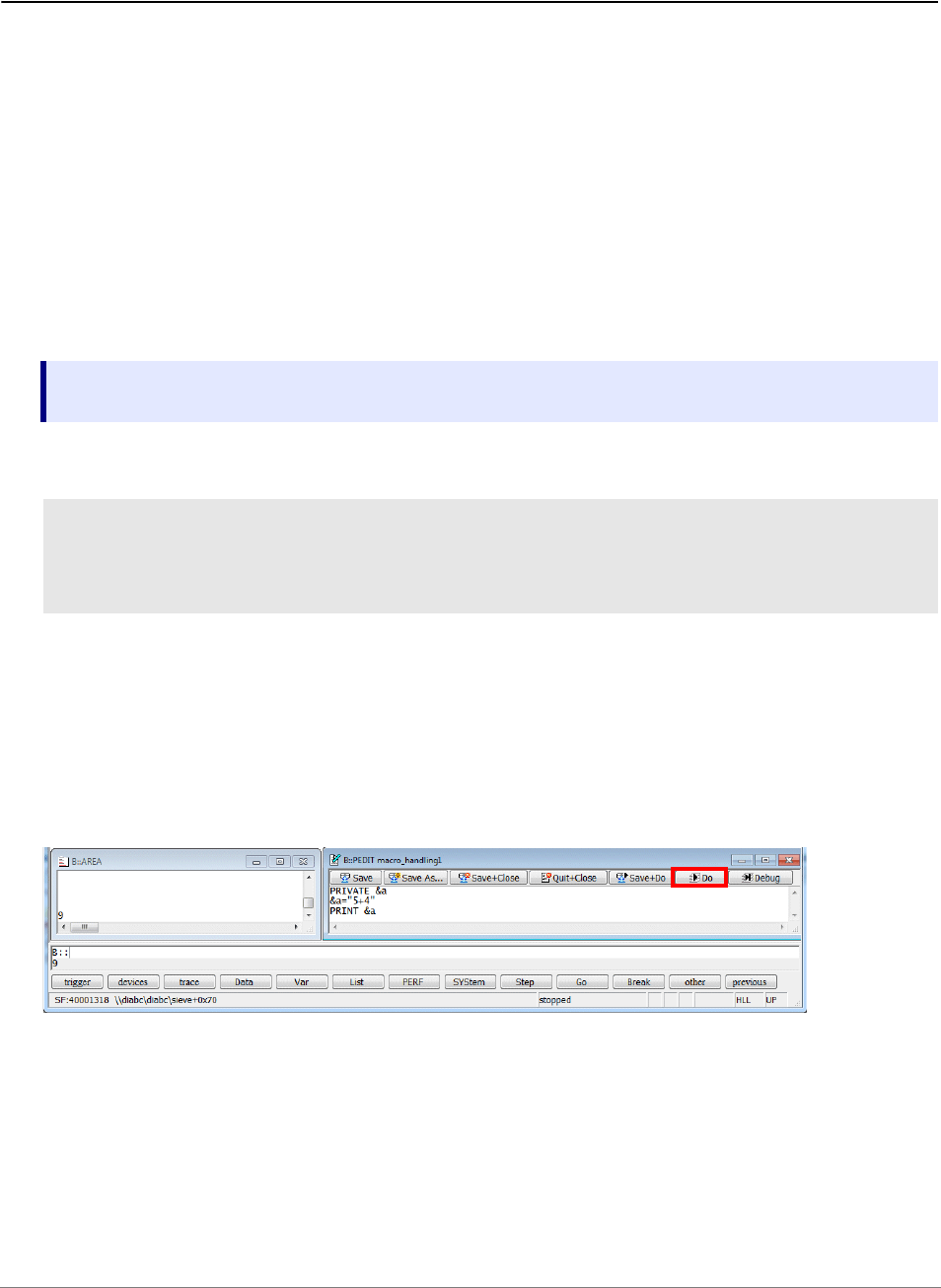
Training Script Language PRACTICE | 43
©
1989-2024 Lauterbach
Macro Handling
To better understand the usage of macros, it is the best to look at the way the PRACTICE interpreter
executes a script line.
The PRACTICE interpreter executes a script line by line. Each line is (conceptually) processed in three
steps:
1. All macros are replaced by their corresponding character sequence.
2. All expressions are evaluated.
3. The resulting command is executed.
For the following examples the command PRINT is used.
Example 1
We look at the PRINT &a line. To execute this line, the interpreter will first:
1. Replace all macros with their corresponding character sequences. So:
PRINT &a -> PRINT 5+4
2. Evaluate all expressions
PRINT 5+4 -> PRINT 9
3. Execute the resulting command. So it will execute PRINT 9.
PRINT {<data>} PRINT specified <data> to TRACE32 message line and to TRACE32
message area.
PRIVATE &a
&a="5+4"
PRINT &a
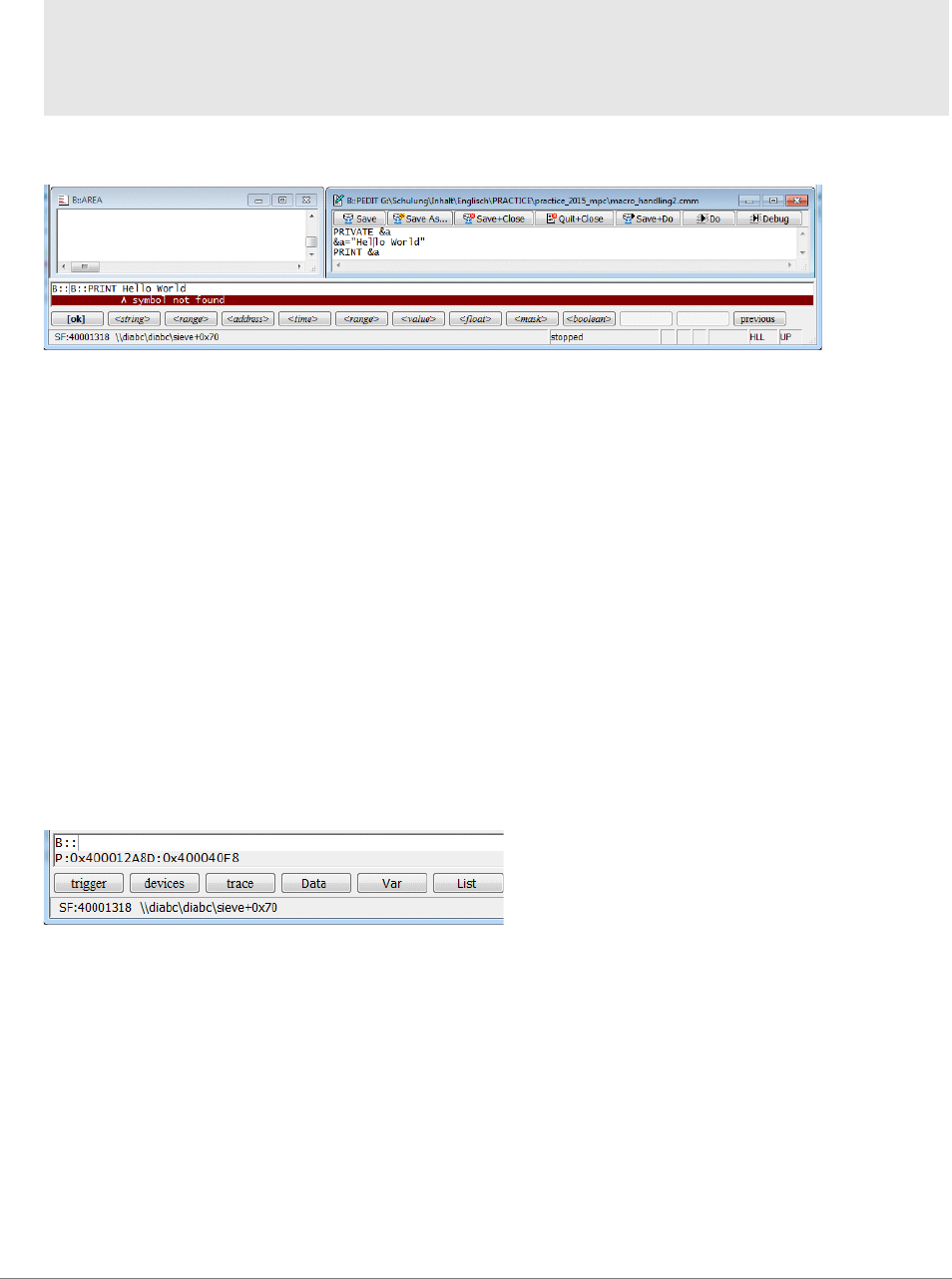
Training Script Language PRACTICE | 44
©
1989-2024 Lauterbach
Example 2
This example will generate an error.
Let’s look at the three steps the interpreter will take to execute the PRINT &a command:
1. Replace all macros with their corresponding character sequences
PRINT &a -> PRINT Hello World
2. Evaluate expressions
PRINT Hello World -> error
3. Execute command, which will not happen because of the error in the second step.
The second step fails because in PRACTICE a single word like Hello (which is not enclosed in double
quotes) refers to a debug symbol, loaded, for example, from an ELF file.
When the PRACTICE interpreter encounters such a debug symbol, the expression evaluation will try to
replace the debug symbol by the address to which the symbol refers. If there is no debug symbol called
Hello (which is likely), the PRACTICE interpreter will output the error message symbol not found.
If by pure accident there are debug symbols called Hello and World the addresses of these symbols will
be printed.
This example demonstrates how the pure macro replacement step will basically always work, since you
always can replace a macro by its character sequence; but the result might not make sense.
PRIVATE &a
&a="Hello World"
PRINT &a
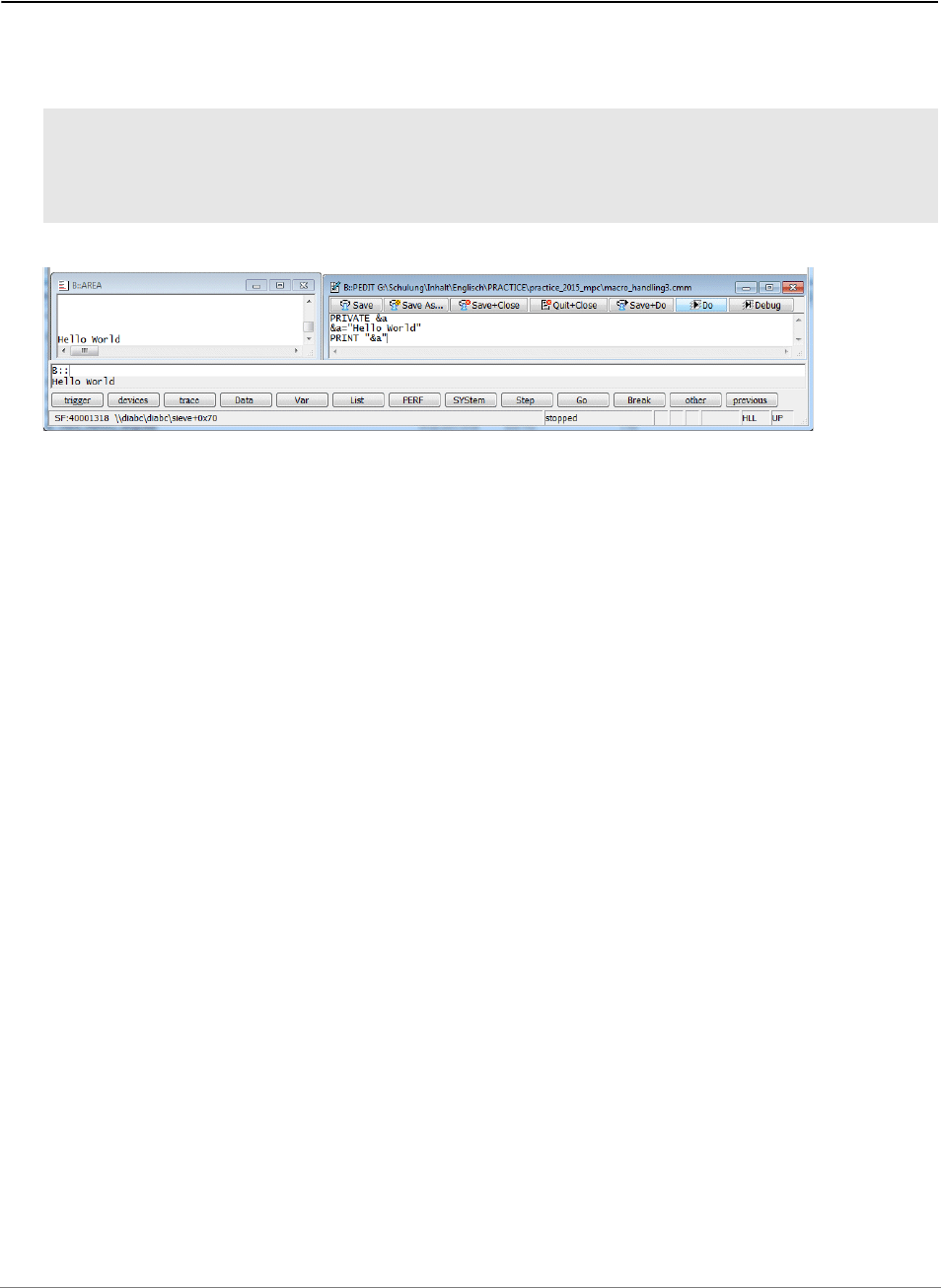
Training Script Language PRACTICE | 45
©
1989-2024 Lauterbach
Macros as Strings
Macros are replaced by their character sequence. If you want to explicitly use this character sequence as a
string, then you should enclose the macro in double quotes, for example:
To understand what happens it is again best to look at the three steps which are taken to execute the
PRINT "&a" command.
1. Replace the macro by its character sequences
PRINT "&a" -> PRINT "Hello World"
2. Evaluate expressions.
Nothing to do for this example.
3. Execute command.
PRIVATE &a
&a="Hello World"
PRINT "&a"
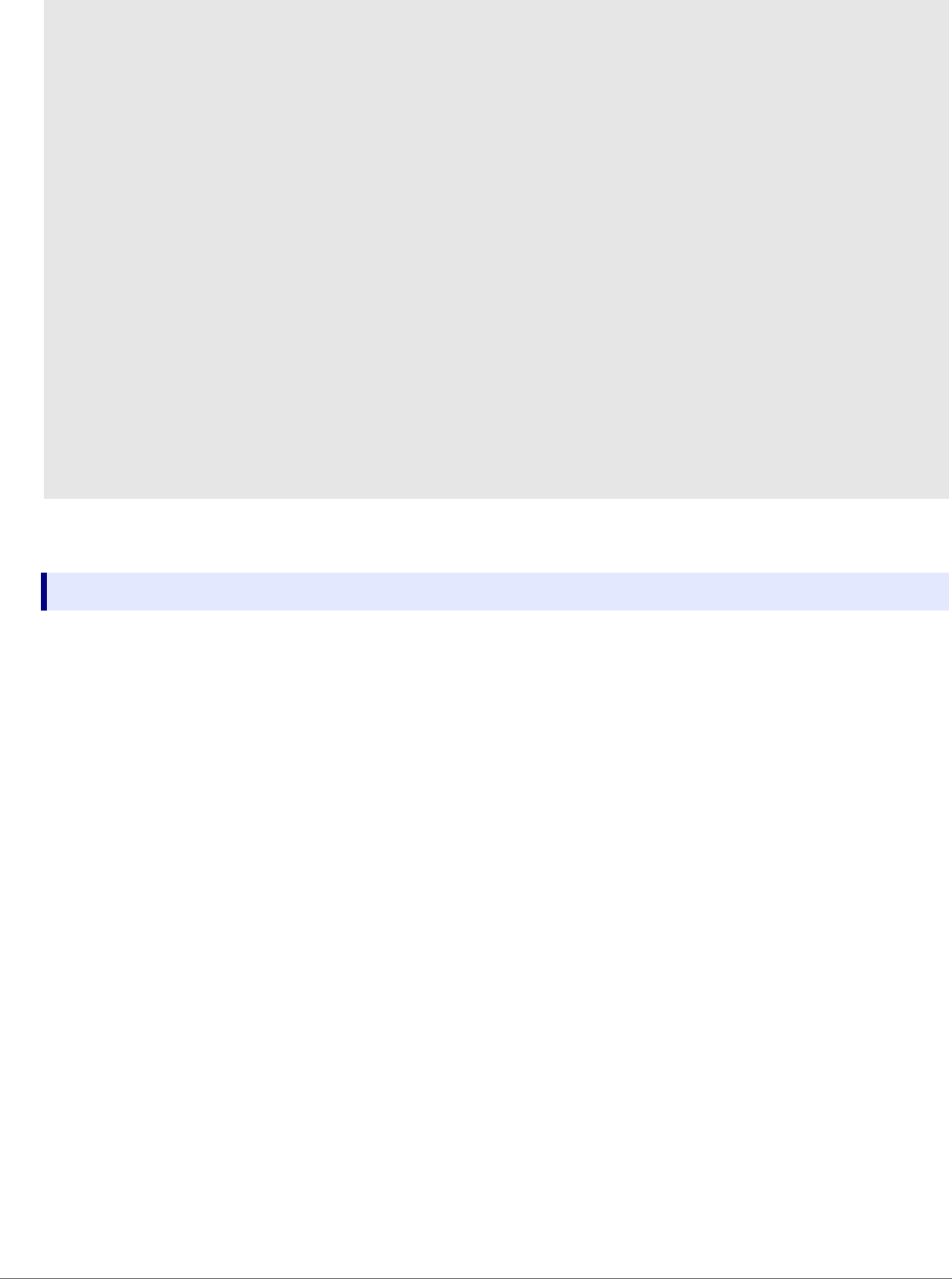
Training Script Language PRACTICE | 46
©
1989-2024 Lauterbach
String composing example:
// Script string_example.cmm
PRIVATE &drive &architecture &demo_directory
&drive="C:"
&architecture="MPC"
// PRINT command
PRINT "Directory " "&drive" "\T32_" "&architecture" "\demo"
PRINT "Directory "+"&drive"+"\T32_"+"&architecture"+"\demo"
PRINT "Directory &(drive)\T32_&(architecture)\demo"
// Macro assignment
&demo_directory="&drive"+"\T32_"+"&architecture"+"\demo"
DIR &demo_directory
&demo_directory="&(drive)\T32_&(architecture)\demo"
DIR &demo_directory
// Command parameter
DIR "&(drive)\T32_&(architecture)\demo"
DIR <directory> Display a list of files and folders for the specified directory.

Training Script Language PRACTICE | 47
©
1989-2024 Lauterbach
Macros as Numbers
The PRACTICE stack shows the macro values and their radix.
// Script numbers.cmm
PRIVATE &my_hex &my_dec &my_bin
PRIVATE &my_stringlength &my_sizeof
PRIVATE &add1 &add2
PRIVATE &convert1 &convert2
// Hex, decimal, binary by TRACE32 syntax
&my_hex=0x7
&my_dec=22.
&my_bin=0y1110
// Hex, decimal, binary as expression result
&add1=&my_bin+&my_hex
&add2=&my_hex+&my_dec
// Hex, decimal, binary as return value
&my_stringlength=STRing.LENgth("0123456789012345")
&my_sizeof=sYmbol.SIZEOF(sieve)
// Hex, decimal, binary by CONVERT function
&convert1=CONVERT.HEXTOINT(&my_bin)
&convert2=CONVERT.HEXTOINT(&my_hex)
…
STRing.LENgth(<string>) Returns the length of the <string> as a decimal number.
sYmbol.SIZEOF(<symbol>) Returns the size occupied by the specified debug <symbol> (e.g.
function, variable, module) as a hex. number.
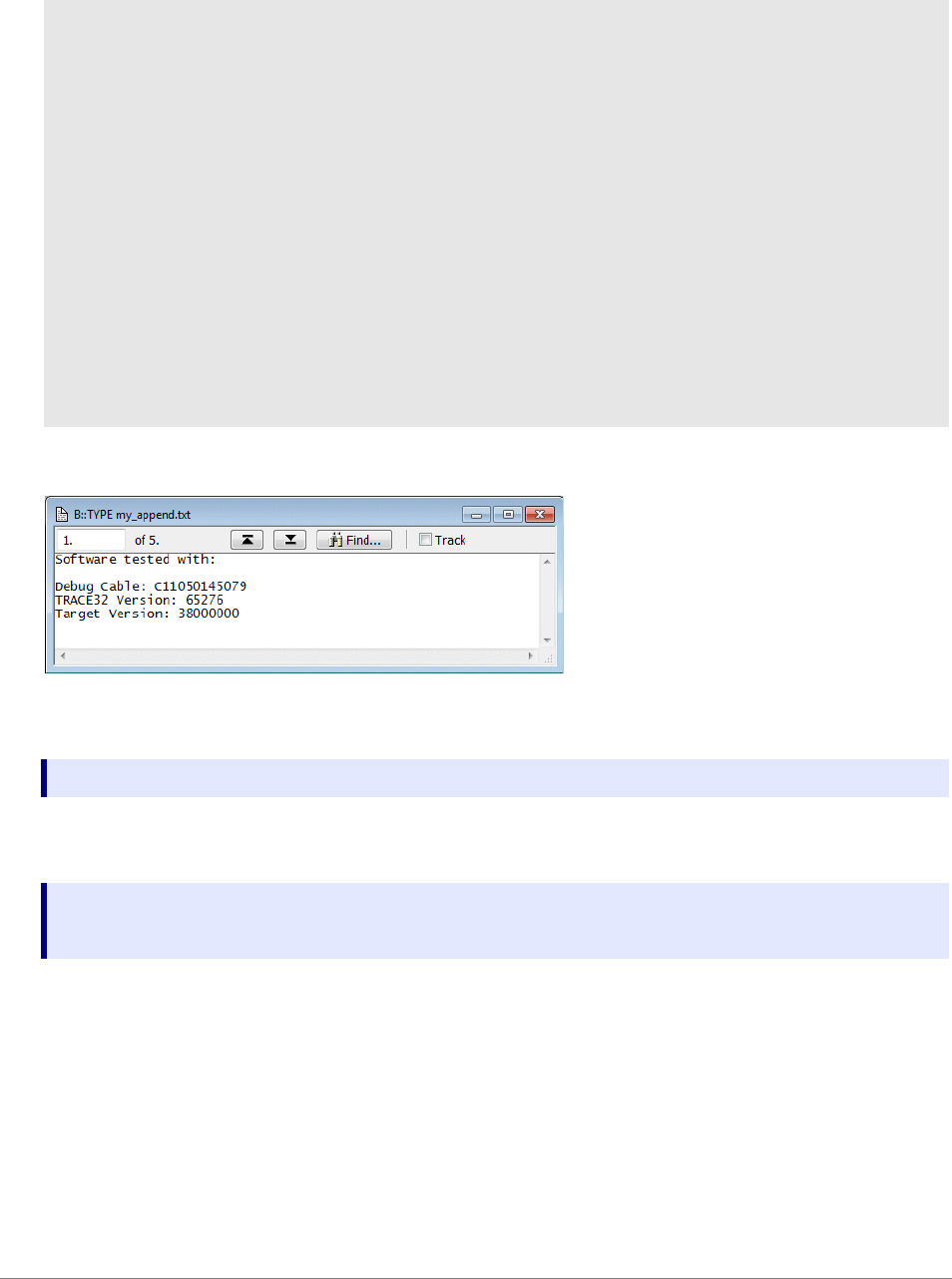
Training Script Language PRACTICE | 48
©
1989-2024 Lauterbach
But if you use a PRACTICE output command, the radix information is removed.
Results for example in:
TRACE32 command
TRACE32 functions
// Script append_example.cmm
PRIVATE &target_id
&target_id="D:0x40004000"
DEL "my_append.txt"
APPEND "my_append.txt" "Software tested with:"
APPEND "my_append.txt" " "
APPEND "my_append.txt" "Debug Cable: " CABLE.SERIAL()
APPEND "my_append.txt" "TRACE32 Version: " VERSION.BUILD()
APPEND "my_append.txt" "Target Version: " Data.Long(&target_id)
//...
DEL <filename> Delete file specified by <filename>
CABLE.SERIAL() Returns the first serial number of the plugged debug cable.
VERSION.BUILD() Returns build number of TRACE32 software as a decimal number.
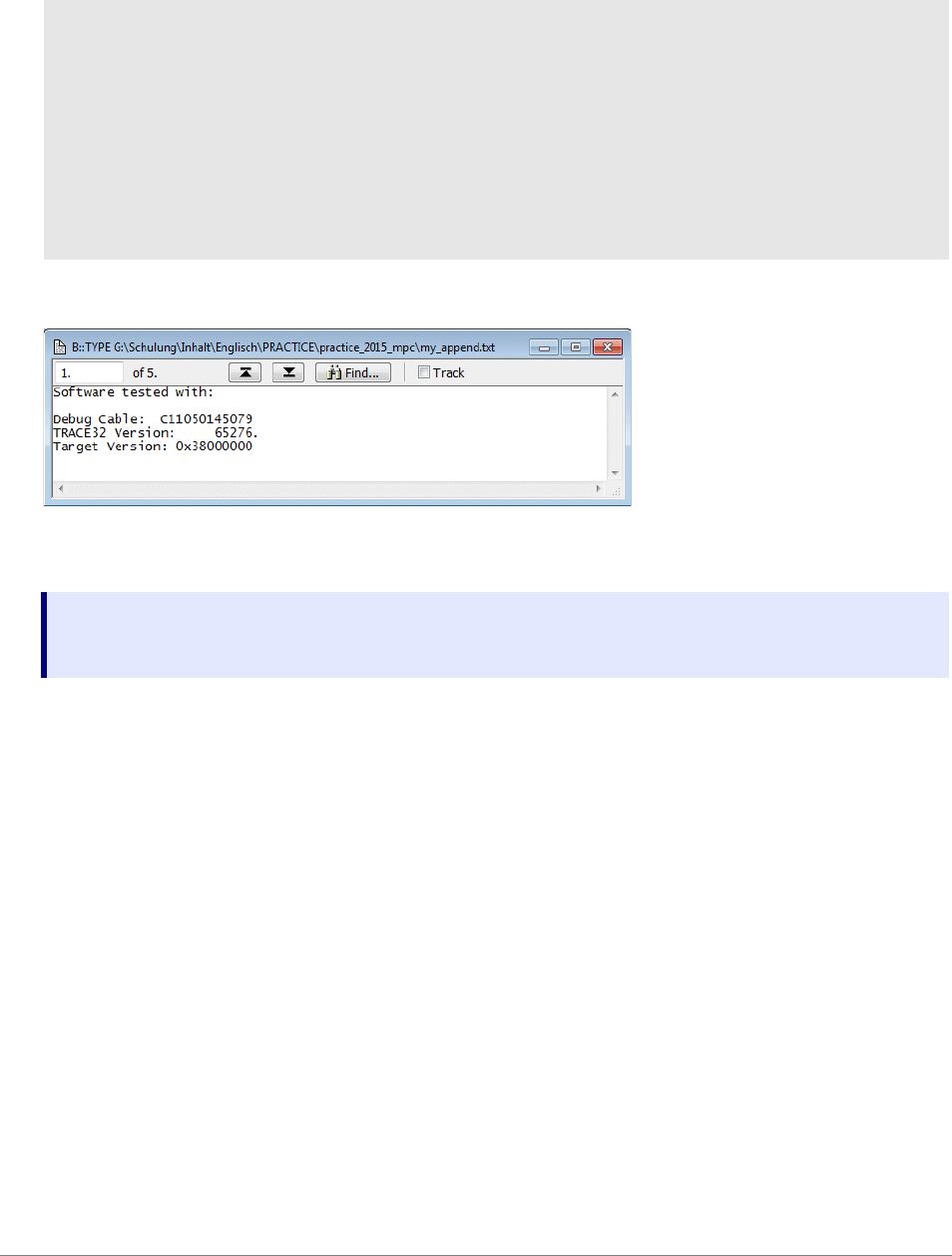
Training Script Language PRACTICE | 49
©
1989-2024 Lauterbach
Since it might be confusing for the reader not to know if a number is decimal or hex, you can proceed as
follows:
May result for example in:
TRACE32 function
// Script append_example_format.cmm
PRIVATE &target_id
&target_id="D:0x40004000"
DEL "my_append.txt"
APPEND "my_append.txt" "Software tested with:"
APPEND "my_append.txt" " "
APPEND "my_append.txt" "Debug Cable: " FORMAT.STRING(CABLE.SERIAL(),15.,' ')
APPEND "my_append.txt" "TRACE32 Version: " FORMAT.Decimal(8.,VERSION.BUILD())+"."
APPEND "my_append.txt" "Target Version: 0x"+FORMAT.HEX(8.,Data.Long(&target_id))
FORMAT.HEX(<width>,<number>) Formats a numeric expression to a hexadecimal number and
generates an output string with a fixed length of <width> with
leading zeros.
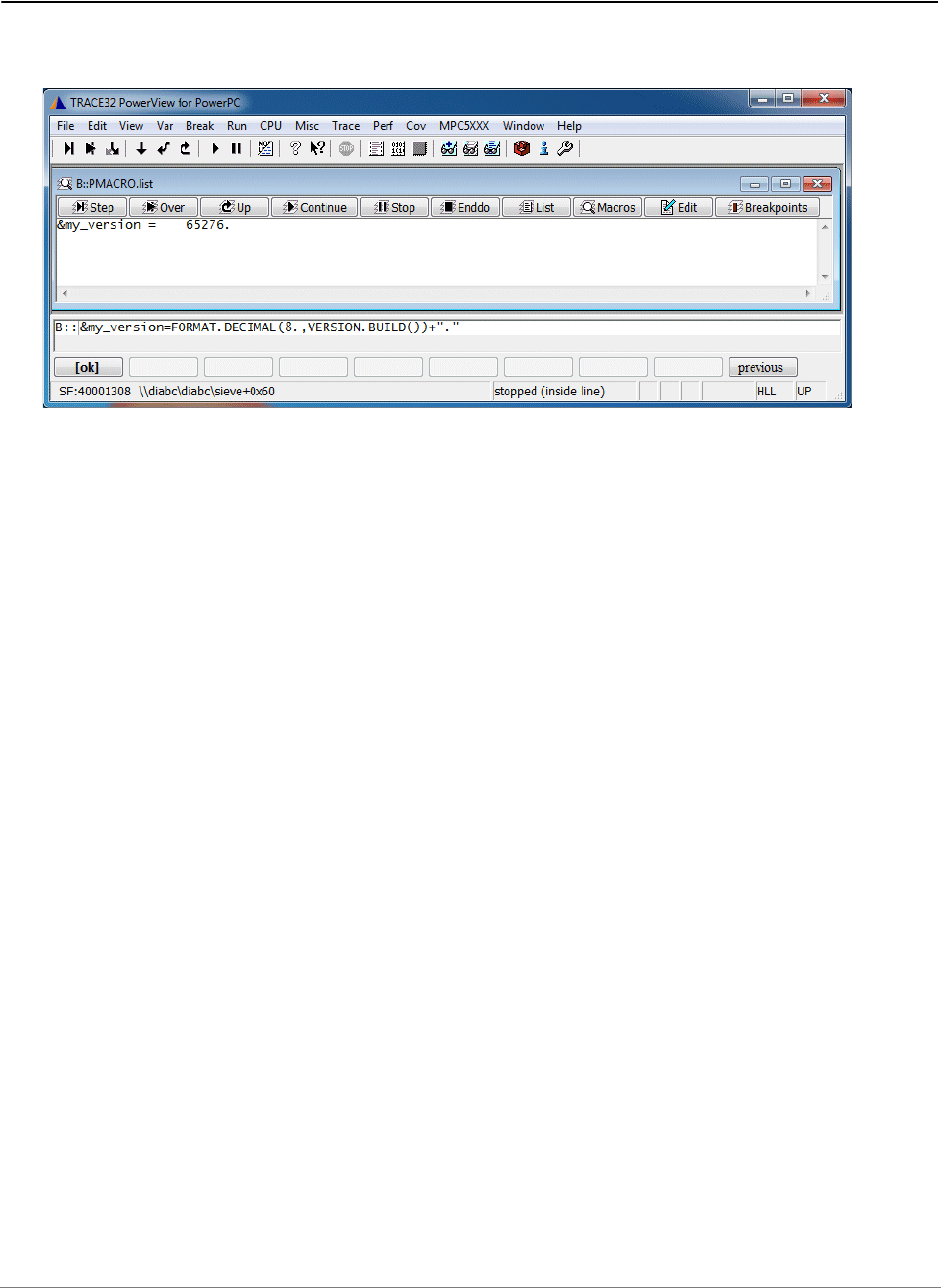
Training Script Language PRACTICE | 50
©
1989-2024 Lauterbach
Note for Testing
PRACTICE macros are not available in the command line. They are only available when running a script.
But you can proceed as follows to test a macro assignment:
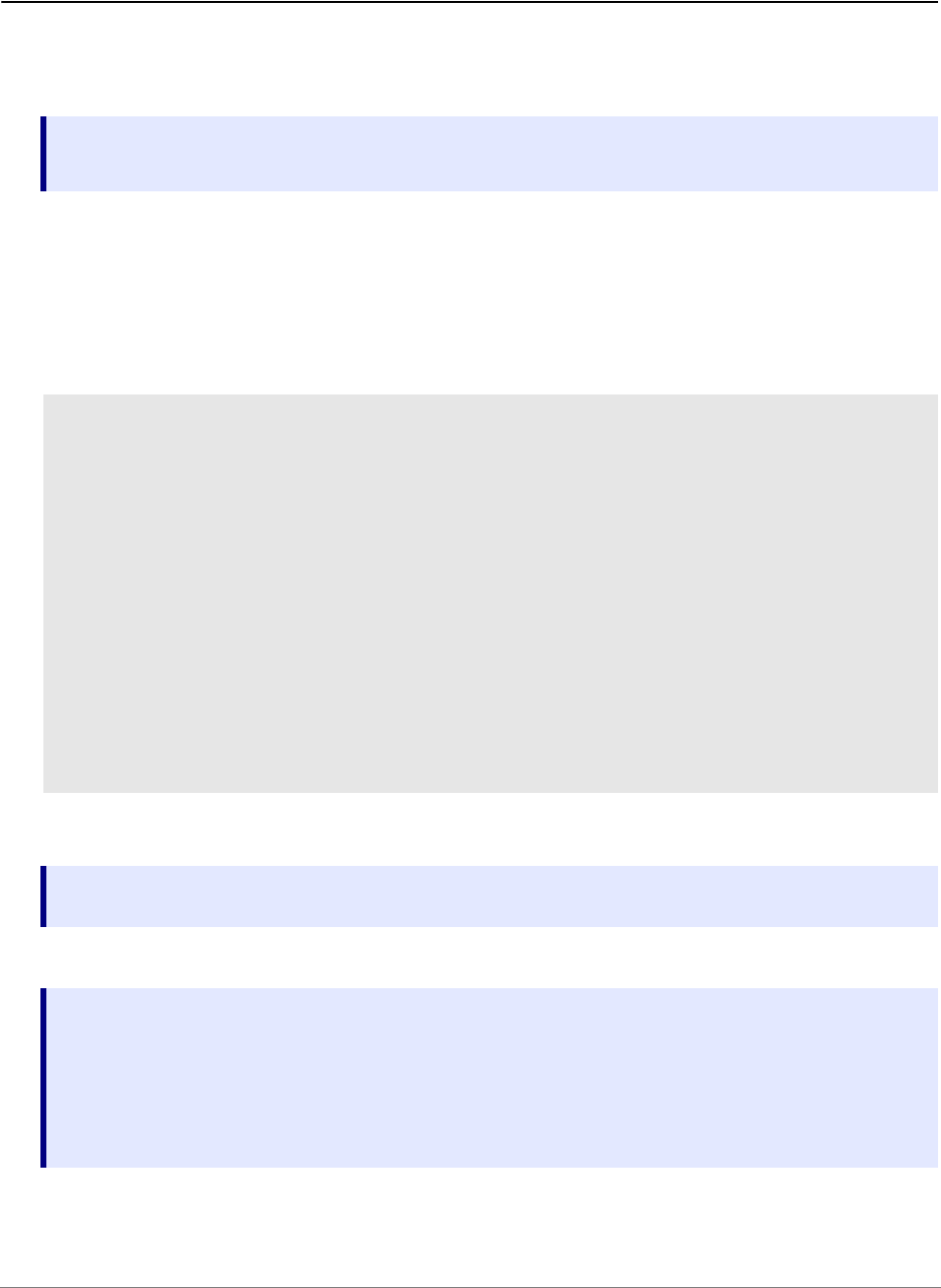
Training Script Language PRACTICE | 51
©
1989-2024 Lauterbach
More Complex Data Structures
For all complex data structures TRACE32-internal variables can be used. The following two commands can
be used to declare a TRACE32-internal variable.
TRACE32-internal variables require that a program is loaded via the Data.LOAD command. All data types
provided by this program can then be used (sYmbol.List.Type).
• TRACE32-internal variables have the same scope as PRACTICE macros (e.g. they are on the
PRACTICE stack).
• TRACE32-internal variables are displayed and modified via the Var command group.
Var.NEWGLOBAL <type> \<name> Create a global TRACE32-internal variable
Var.NEWLOCAL <type> \<name> Create a local TRACE32-internal variable
; script newlocal.cmm
LOCAL &my_symbol
ENTRY &my_symbol
Var.NEWLOCAL char[5][40] \typeresult
Var.Assign \typeresult[0]="Symbol does not exist"
Var.Assign \typeresult[1]="Symbol is label"
Var.Assign \typeresult[2]="Symbol is function"
Var.Assign \typeresult[3]="Symbol is variable"
Var.Assign \typeresult[4]="Undefined"
&n=sYmbol.TYPE(&my_symbol)
Var.PRINT %String \typeresult[&n]
ENDDO
Var.Assign %<format> <variable> Modify variable, no log is generated in the message line or in the
AREA window.
sYmbol.TYPE(<symbol>) Returns the basic type of the symbol as a numerical value.
0 = symbol does not exist
1 = plain label without type information
2 = HLL function
3 = HLL variable
other values may be defined in the future
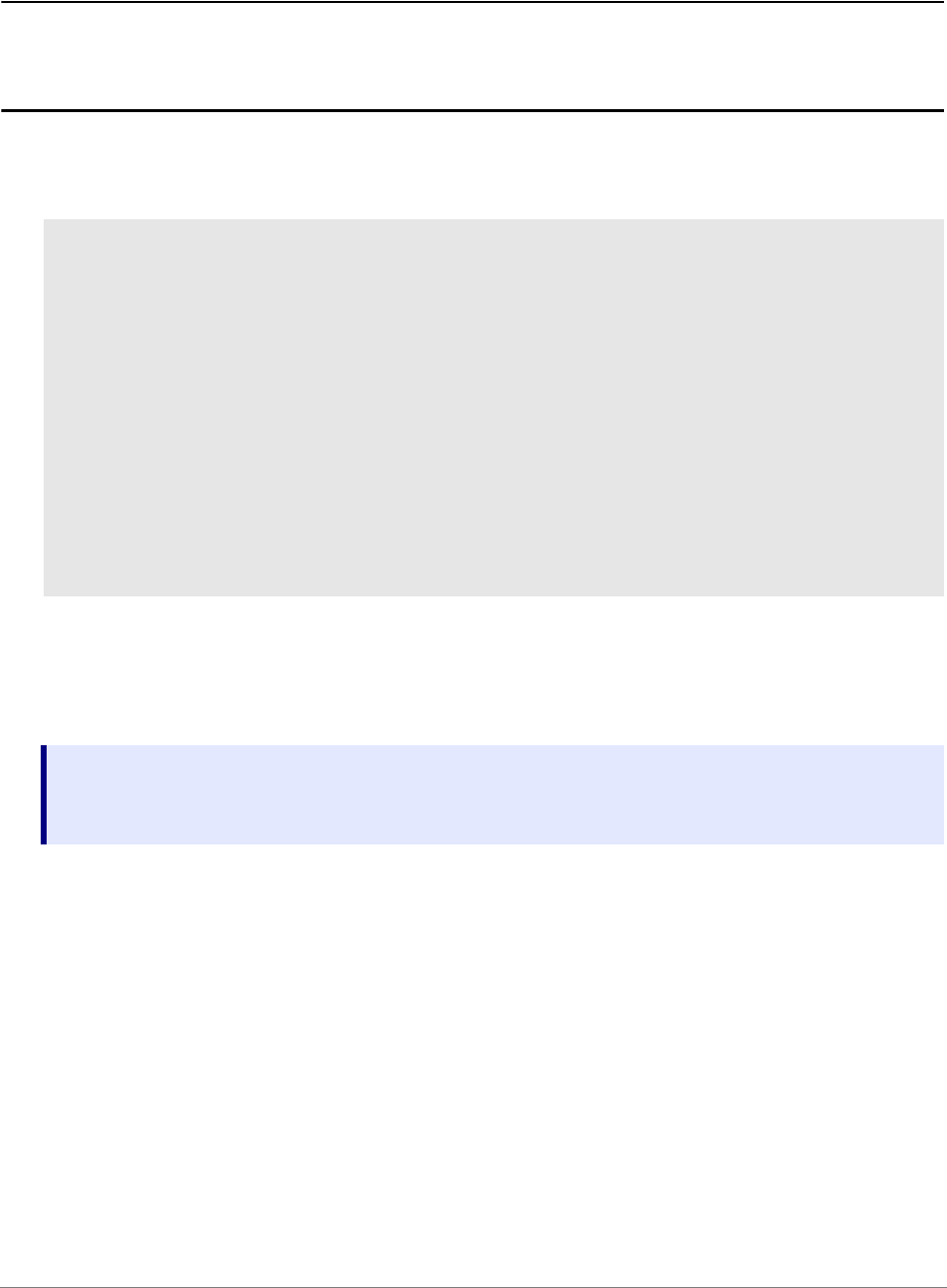
Training Script Language PRACTICE | 52
©
1989-2024 Lauterbach
Script Examples
Run Through Program and Generate a Test Report
Task of part 1 of the script: Start the target program execution and wait until the program execution is
stopped at the entry of the function main.
The script consists of:
TRACE32 commands
// Script run_through_code.cmm
// Part 1
// Prepare debugging
DO "target_setup.cmm"
Go main
WAIT !STATE.RUN() 2.s
IF STATE.RUN()
(
Break
)
…
Go <address> Start the program execution.
Program execution should stop when <address> is reached.
Break Stop the program execution.

Training Script Language PRACTICE | 53
©
1989-2024 Lauterbach
PRACTICE commands
TRACE32 function
DO <filename> Call PRACTICE script <filename>
WAIT <condition> <time_period> Wait until <condition> becomes true or <time_period>
has expired.
IF <condition>
(
<if_block>
)
ELSE
(
<else_block>
)
Execute <if_block> when <condition> is true.
Execute <else_block> when <condition> is false.
PRACTICE is whitespace sensitive. There must be at least
one space after a PRACTICE command word.
<block> has to be set in round brackets. PRACTICE requires
that round brackets are typed in a separate line.
STATE.RUN() Returns TRUE when the program execution is running.
Returns FALSE when the program execution is stopped.

Training Script Language PRACTICE | 54
©
1989-2024 Lauterbach
Task of part 2 of the script: Check if program execution stopped at entry to function main and generate a
test report.
The backslash \ in conjunction with at least one space serves as a line continuation character.
TRACE32 function
Addresses in TRACE32
Why is the following function needed?
// Part 2
…
IF Register(PC)==ADDRESS.OFFSET(main)
(
APPEND "test_protocol.txt" FORMAT.STRing("System booted successfully",70.,' ')\
FORMAT.UnixTime("c",DATE.UnixTime(),0)
)
ELSE
(
APPEND "test_protocol.txt" FORMAT.STRing("Booting failed",70.,' ')\
FORMAT.UnixTime("c",DATE.UnixTime(),0)
ENDDO
)
Register(<register_name>) Returns the contents of the specified core register as a hex.
number.
ADDRESS.OFFSET(main)
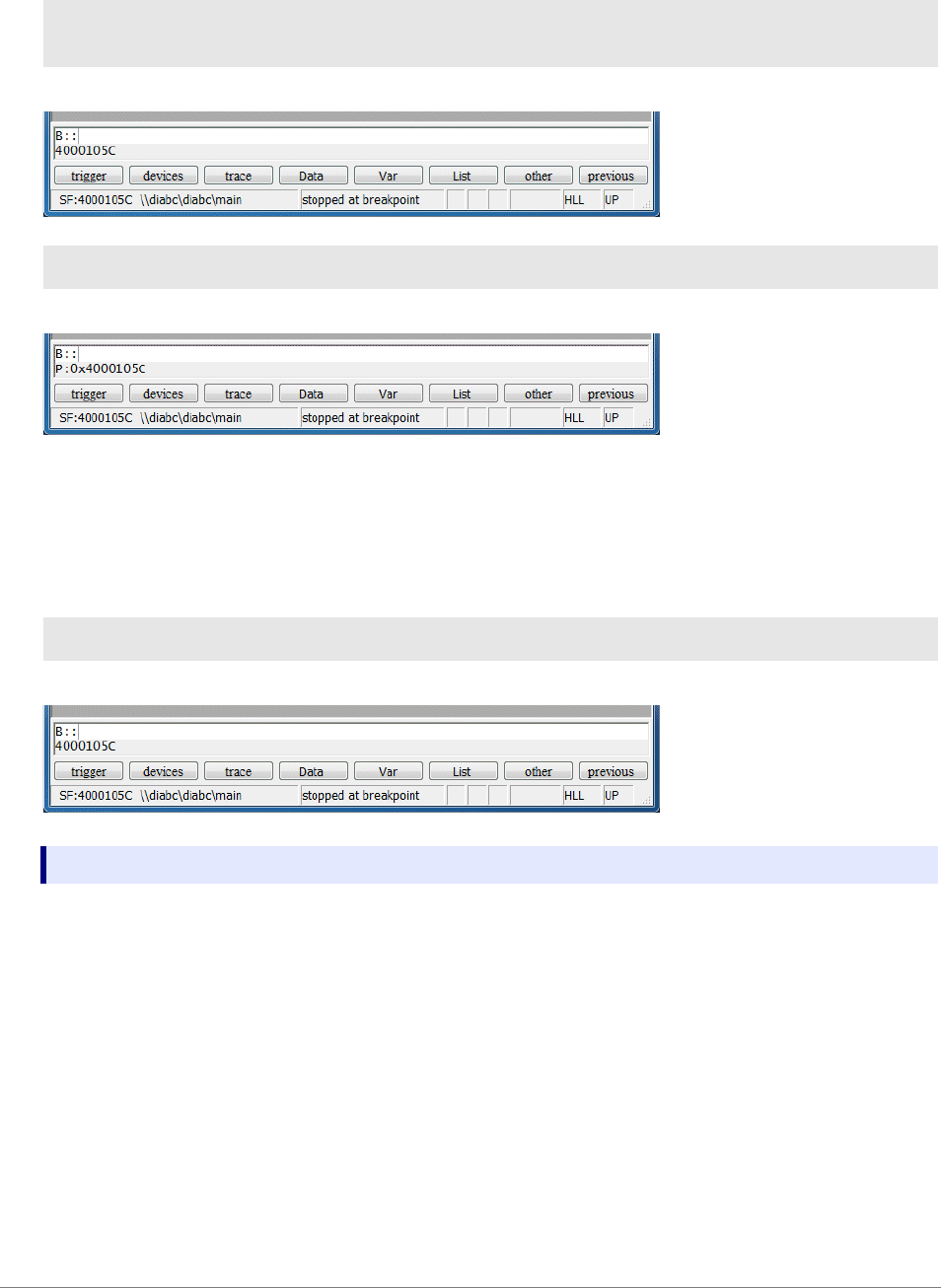
Training Script Language PRACTICE | 55
©
1989-2024 Lauterbach
main is an address and addresses in TRACE32 PowerView consist of:
•An access class (here P:) which consists of one or more letters/numbers followed by a colon (:)
• A hex. number (here 0x4000105C) that determines the actual address
PRINT Register(PC) // print the content of the program
// counter as a hex. number
PRINT main // print the address of main
PRINT ADDRESS.OFFSET(main)
ADDRESS.OFFSET(<symbol>) Returns the hex. number part of an address.

Training Script Language PRACTICE | 56
©
1989-2024 Lauterbach
PRACTICE commands:
TRACE32 functions:
// Part 2
…
IF Register(PC)==ADDRESS.OFFSET(main)
(
APPEND "test_protocol.txt" FORMAT.STRing("System booted successfully",70.,' ')\
FORMAT.UnixTime("c",DATE.UnixTime(),0)
)
ELSE
(
APPEND "test_protocol.txt" FORMAT.STRing("Booting failed",70.,' ')\
FORMAT.UnixTime("c",DATE.UnixTime(),0)
ENDDO
)
APPEND <filename> {<data>} Append data to content of file <filename>.
ENDDO A script ends with its last command or with the ENDDO
command.
FORMAT.STRing(<string>,<width>,<filling_character>) Formats <string> to the specified
<width>.
If the length of <string> is shorter
the <width>, the <filling_character>
is appended.
DATE.UnixTime() Returns the time in UNIX format
and that is seconds passed since
Jan 1st 1970.
FORMAT.UnixTime("c",DATE.UnixTime(),DATE.utcOffset()) Format Unix time according to ISO
8601
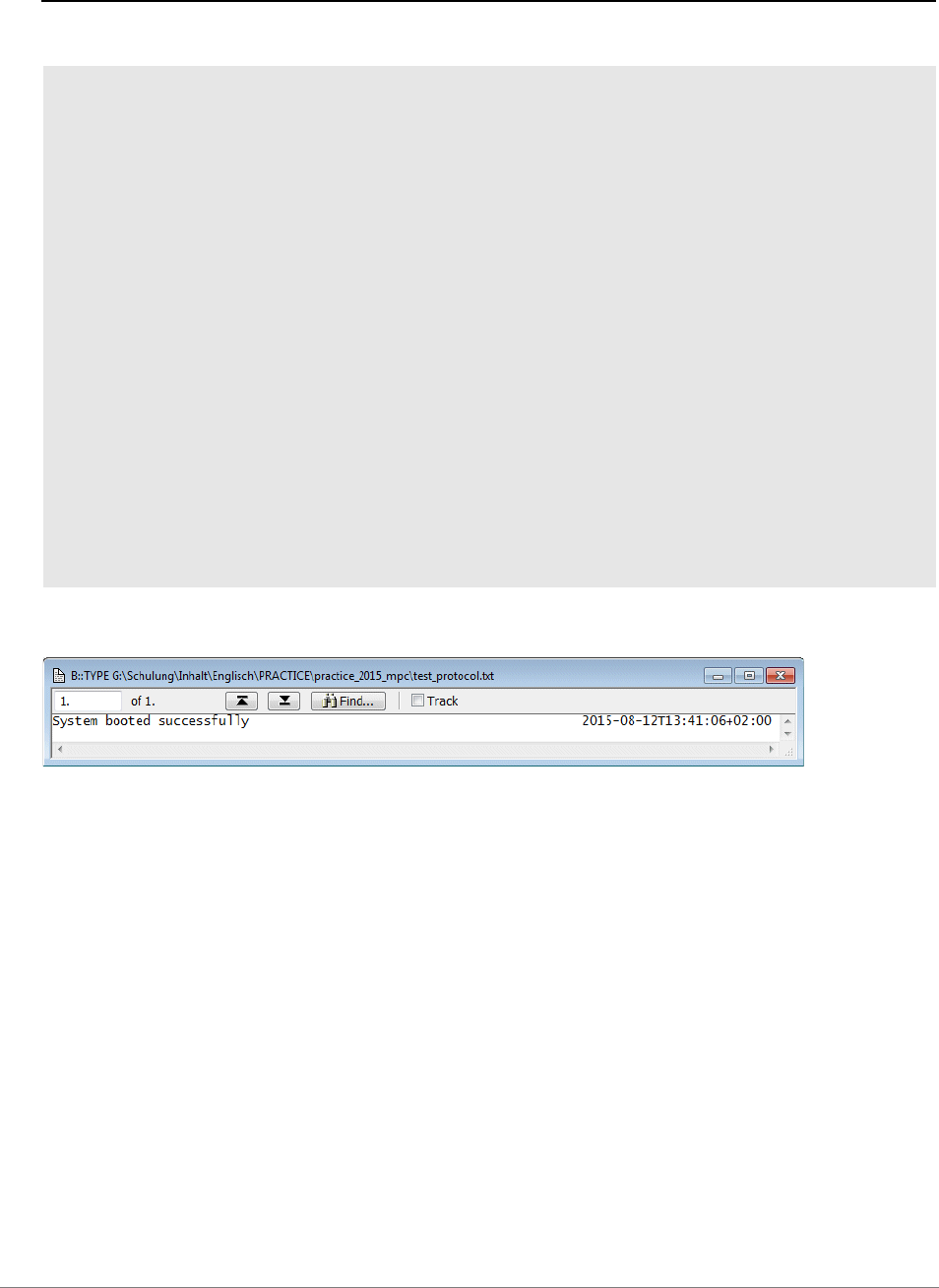
Training Script Language PRACTICE | 57
©
1989-2024 Lauterbach
Summary
Results for example in:
// Prepare debugging
DO "target_setup.cmm"
Go main
WAIT !STATE.RUN() 2.s
IF STATE.RUN()
(
Break.direct
)
IF Register(PC)==ADDRESS.OFFSET(main)
(
APPEND "test_protocol.txt" FORMAT.STRing("System booted successfully",70.,' ')\
FORMAT.UnixTime("c",DATE.UnixTime(),DATE.utcOffSet())
)
ELSE
(
APPEND "test_protocol.txt" FORMAT.STRing("Booting failed",70.,' ')\
FORMAT.UnixTime("c",DATE.UnixTime(),DATE.utcOffSet())
ENDDO
)
…
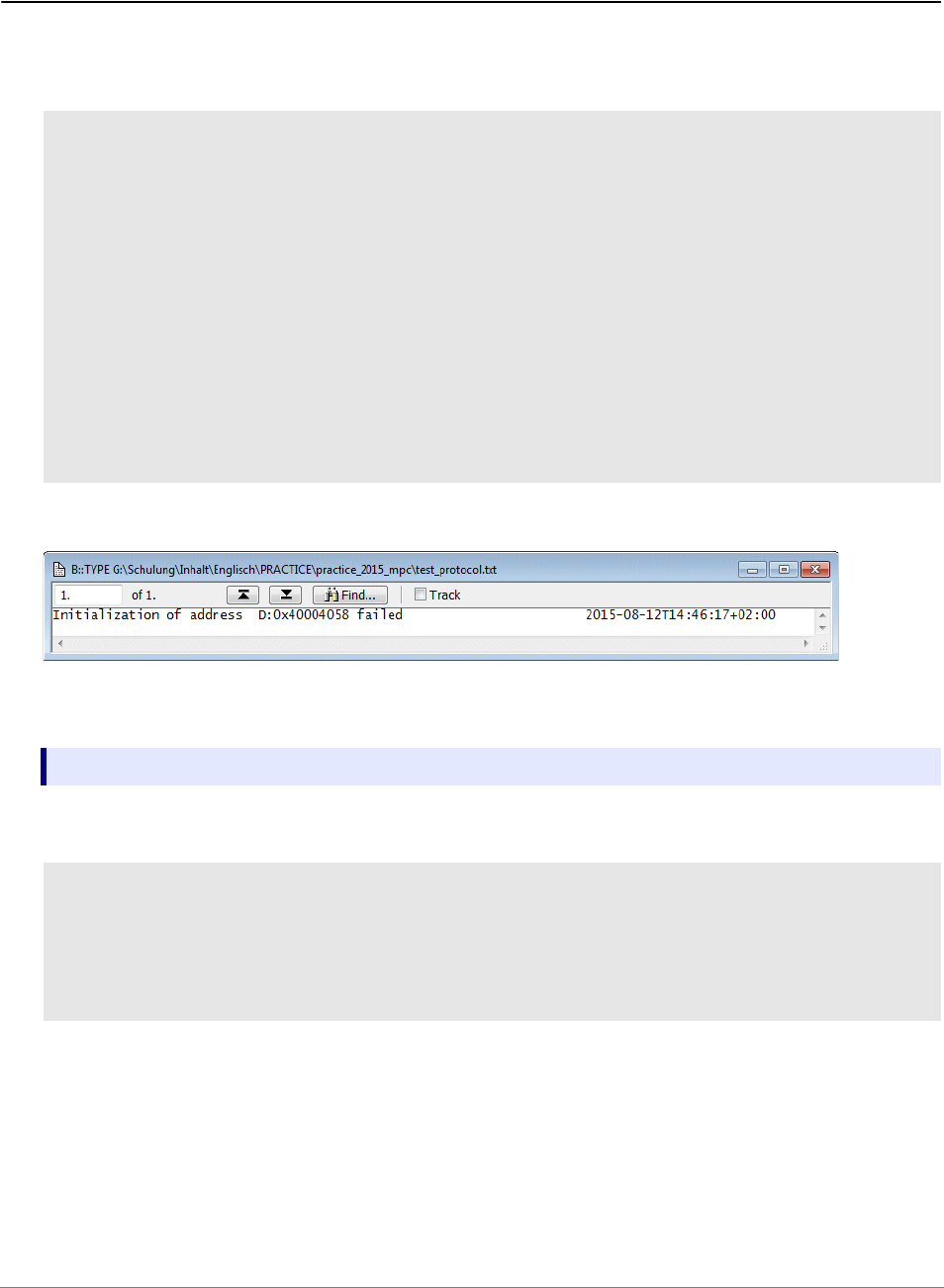
Training Script Language PRACTICE | 58
©
1989-2024 Lauterbach
Check Contents of Addresses
Task of the script: After an appropriate program address e.g. main is reached, you can check if certain
memory addresses are initialized with their correct value.
Results for example in:
TRACE32 function
<address> requires an access class.
// Script check_memory_locations.cmm
…
IF Data.Long(D:0x40004058)!=0x0
(
APPEND "test_protocol.txt"\
FORMAT.STRing("Initialization of address D:0x40004058 failed",70.,' ')\
FORMAT.UnixTime("c",DATE.UnixTime(),DATE.utcOffSet())
)
IF Data.Long(ANC:0xC3FDC0C4)!=0x0
(
APPEND "test_protocol.txt"\
FORMAT.STRing("Initialization of Global Status Register failed",70.,' ')\
FORMAT.UnixTime("c",DATE.UnixTime(),DATE.utcOffSet())
)
…
Data.Long(<address>) Returns the contents of the specified address as a 32-bit hex. value.
Data.Long(D:0x40004058) // D: indicates the generic access
// class Data
Data.LONG(ANC:0xC3FDC0C4) // ANC: indicates
// physical address (A)
// No Cache (NC)

Training Script Language PRACTICE | 59
©
1989-2024 Lauterbach
Check Contents of Address Range
Task of the script: After an appropriate program address e.g. main is reached, you can check if a certain
memory range is initialized with their correct values. An easy way to provide the correct values is a binary
file.
Results for example in:
TRACE32 command
TRACE32 functions
// Script check_memory_range.cmm
…
Data.LOAD.Binary "range_correct" 0x40004000 /DIFF
IF FOUND()
(
PRIVATE &s
APPEND "test_protocol.txt"\
FORMAT.STRing("Initialization of 0x40004000--0x4000401F failed ",70.,' ')\
FORMAT.UnixTime("c",DATE.UnixTime(),DATE.utcOffSet())
&s=TRACK.ADDRESS()
APPEND "test_protocol.txt"\
FORMAT.STRing("First difference found at: &s",70.,' ')
)
…
Data.LOAD.Binary <filename> <address> /DIFF Compare memory content at <address>
with contents of <filename> and provide
the result by the following TRACE32
functions:
FOUND()
TRACK.ADDRESS()
FOUND() Returns TRUE if a difference was found.
TRACK.ADDRESS() Returns the address of the first difference.
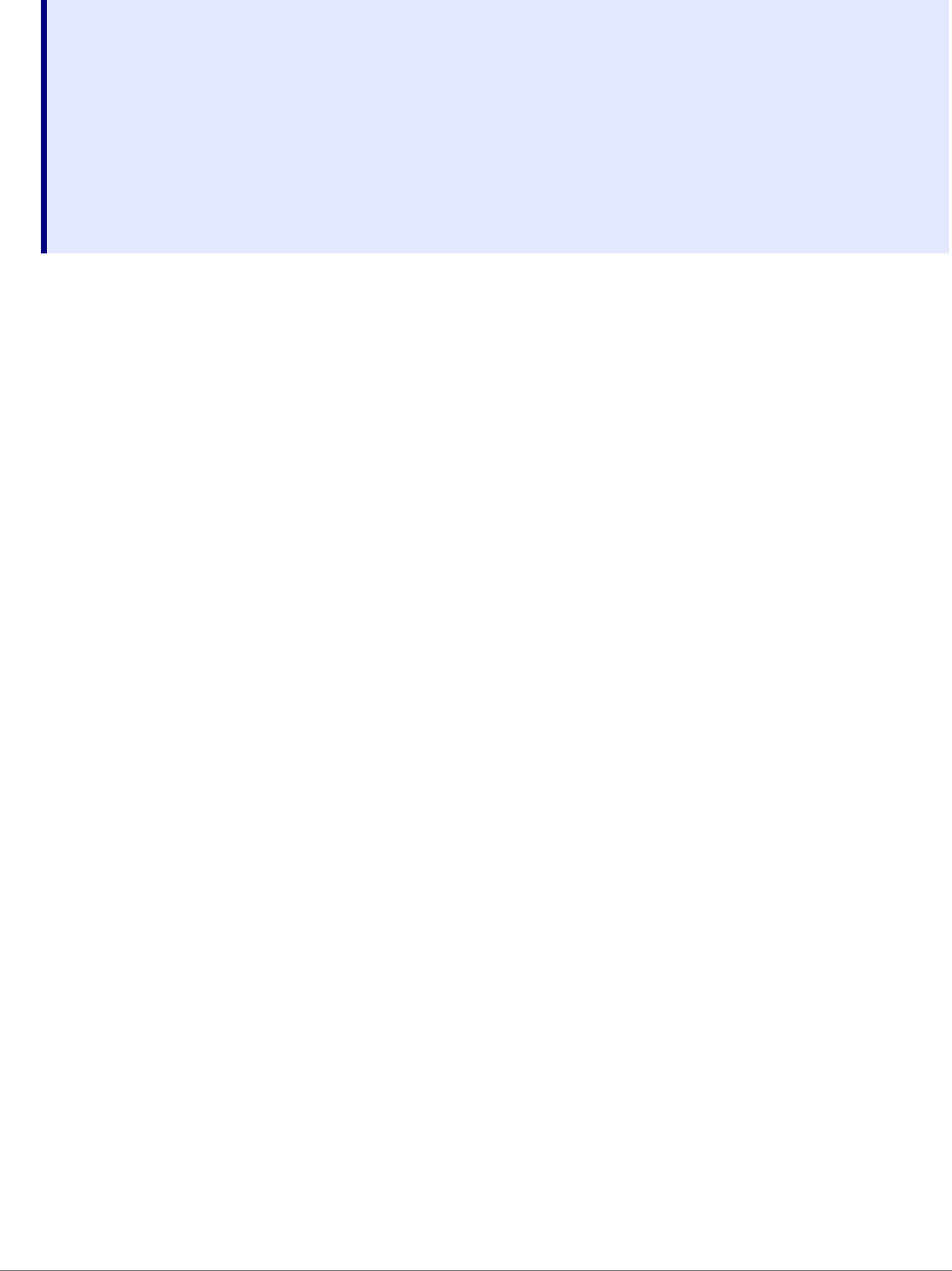
Training Script Language PRACTICE | 60
©
1989-2024 Lauterbach
PRACTICE command
PRIVATE {<macro>} Creates a private PRACTICE macro.
PRACTICE macros start with & to make them different from variables
from the program under debug.
Private PRACTICE macros are only visible inside the declaring block
and are erased when the block ends.
In this example, the declaring block contains the instructions between
the round brackets.

Training Script Language PRACTICE | 61
©
1989-2024 Lauterbach
To inspect all differences in detail the following script can be helpful.
Results for example in:
TRACE32 commands
PRACTICE commands
If PRACTICE scripts are executed, the screen is only updated after a PRINT command.
// Script check_memory_range_details.cmm
Data.LOAD.Binary "range_correct" VM:0x40004000
Data.Dump VM:0x40004000++0x1f /SpotLight
SCREEN.display
Data.COPY 0x40004000++0x1f VM:0x40004000
Data.LOAD.Binary <filename> VM:<address> Load the contents of <filename> to <address> in
the TRACE32 virtual memory. The TRACE32
Virtual Memory is memory on the host computer
which can be displayed and modified with the same
commands as real target memory.
Data.dump VM:<address_range> /SpotLight Display the contents of the TRACE32 Virtual
Memory for the specified <address_range>.
The option SpotLight advises TRACE32 to mark
changed memory locations if the window is
displayed in TRACE32 PowerView.
Data.COPY <address_range> VM:<address> Copy the content of <address_range> to the
TRACE32 Virtual Memory.
SCREEN.display Advise TRACE32 to update the screen now.
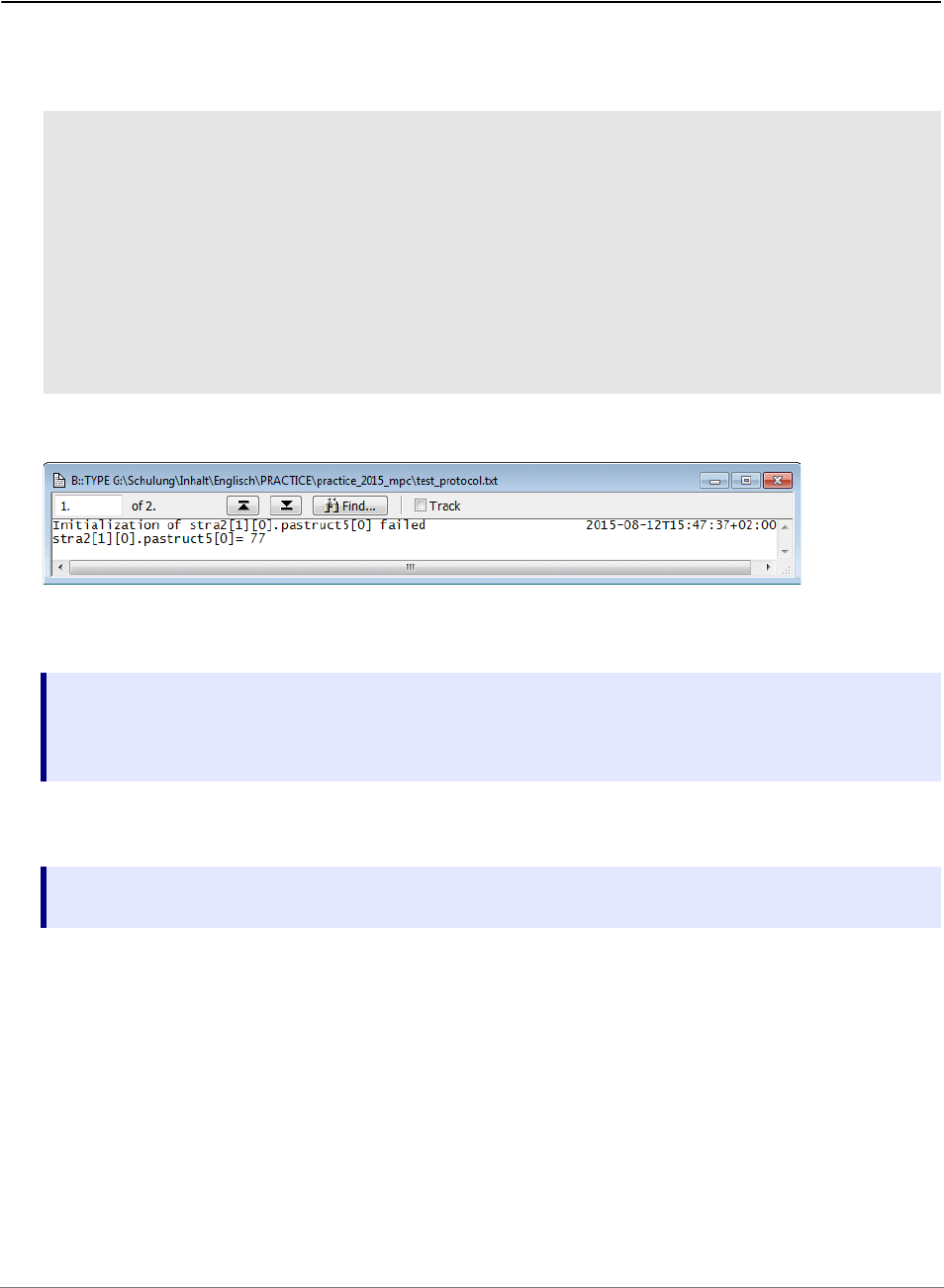
Training Script Language PRACTICE | 62
©
1989-2024 Lauterbach
Check the Contents of Variables
Task of the script: After an appropriate program address e.g. main is reached, you can check if certain
variables are initialized with their correct value.
My result for example in:
PRACTICE command
PRACTICE function
// Script check_var.cmm
…
Var.IF stra2[1][0].pastruct5[0]!=0.
(
APPEND "test_protocol.txt"\
FORMAT.STRing("Initialization of stra2[1][0].pastruct5[0] failed",70.,' ')\
FORMAT.UnixTime("c",DATE.UnixTime(),DATE.utcOffSet())
APPEND "test_protocol.txt" "stra2[1][0].pastruct5[0]= "\
%Decimal Var.Value(stra2[1][0].pastruct5[0])
)
…
Var.IF <hll_condition>
(
<block>
)
Execute <block> when the condition written in the
programming language used is true (C, C++, …)
Var.VALUE(<hll_expression>) Returns the contents of the variable/variable component
specified by <hll_expression> as a hex. number.
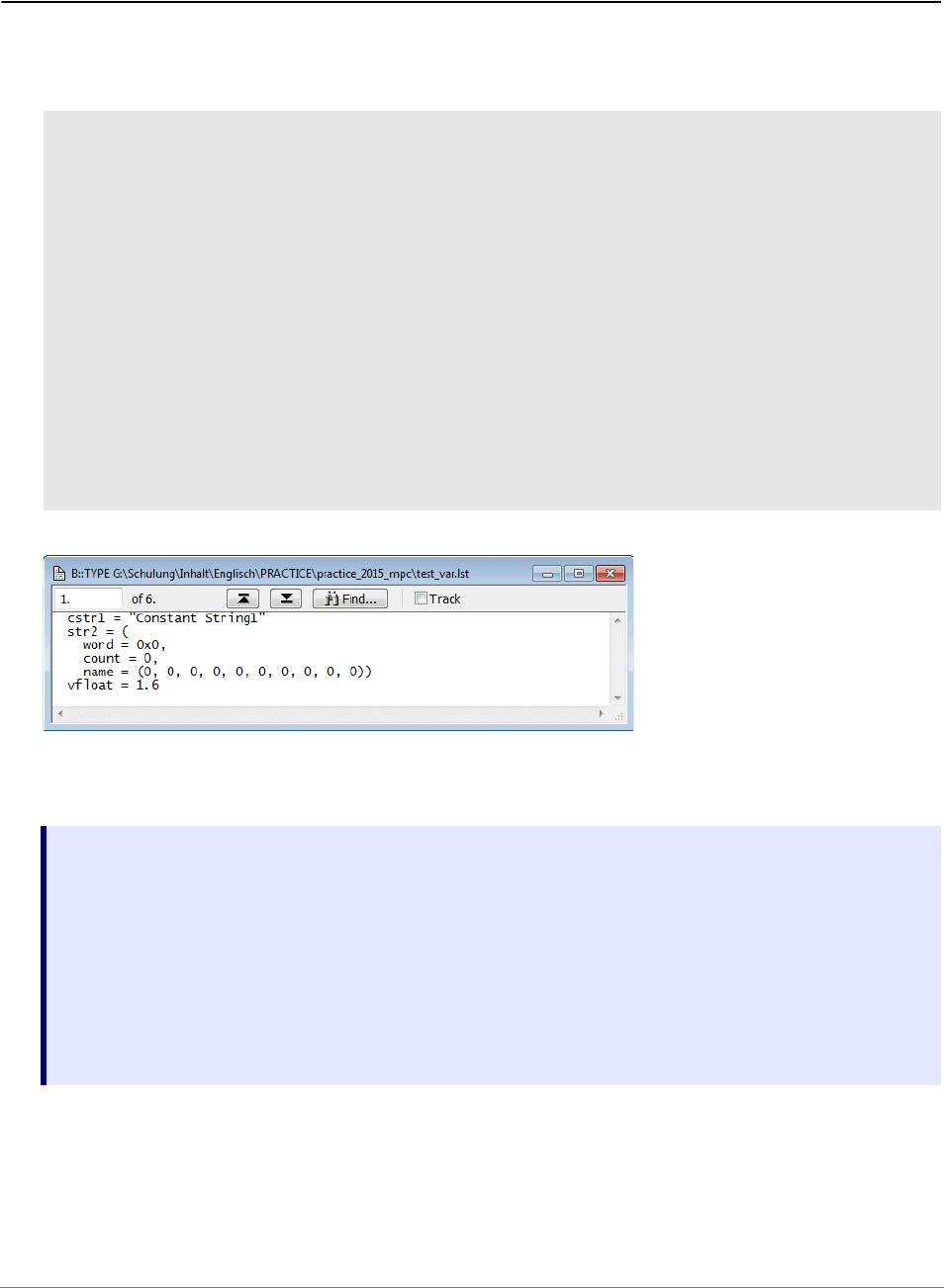
Training Script Language PRACTICE | 63
©
1989-2024 Lauterbach
Record Formatted Variables
Task of script: Write the content of various variables to a file. Use the same formatting as Var.View
command.
TRACE32 commands
// Script record_var.cmm
…
PRinTer.FileType ASCIIE
PRinTer.OPEN "test_var.lst"
WinPos ,,,,,0
WinPrint.Var.View %String cstr1
WinPos ,,,,,0
WinPrint.Var.View %Open str2
WinPos ,,,,,0
WinPrint.Var.View vfloat
PRinTer.CLOSE
…
PRinTer.FileType <format> Specify output <format> for output file.
PRinTer.Open <filename> Open file <filename> for outputs.
PRinTer.CLOSE Close open output file.
WinPrint.<command> Redirect the <command> output to the specified file.
WinPos ,,,,,0 By the default the TRACE32 <command> and its output is redirected
to the specified file.
With this special WinPOS command only the <command> output is
redirected to the specified file.

Training Script Language PRACTICE | 64
©
1989-2024 Lauterbach
Record Variable as CSV
Task of the script: Write the contents of the variable vbfield to a file whenever the program execution stops
at the specified breakpoint. Use CSV as output format.
Results for example in:
PRACTICE command
// Script test_var_vbfield.cmm
…
Break.RESet
Var.Break.Set vbfield /Write
REPEAT 10.
(
Go
WAIT !STATE.RUN() 2.s
IF STATE.RUN()
(
Break
ENDDO
)
Var.EXPORT "vbfield_export.csv" vbfield /Append
)
…
// Use expression of your programming language (C, C++, …) to specify write breakpoint
Var.Break.Set <hll_expression> /Write
// Since the number of write breakpoints is limited, it is recommended to reset the current breakpoint
// settings
Break.RESet
// Append content of variables as CSV (Comma-Separated Values) to file <filename>
Var.EXPORT <filename> [{%<format>}] {<variable>} /Append

Training Script Language PRACTICE | 65
©
1989-2024 Lauterbach
;Example 1
RePeaT 100. PRINT "X"
;Example 2
RePeaT 50.
(
PRINT %CONTinue "*"
WAIT 100.ms
)
;Example 3
LOCAL &code
AREA.Create A000 , 2100.
AREA.view A000
OPEN #1 "~~/t32.men" /Read
RePeaT
(
READ #1 %LINE &code
PRINT "&code"
)
WHILE EOF()==FALSE()
CLOSE #1
;Print X 100 times
;Print a * at the end of
;the previous line then
;wait 100 ms. Do this 50
;times.
;Change the number of
;lines in the AREA window
;to 2100
;Read until the end of
;file
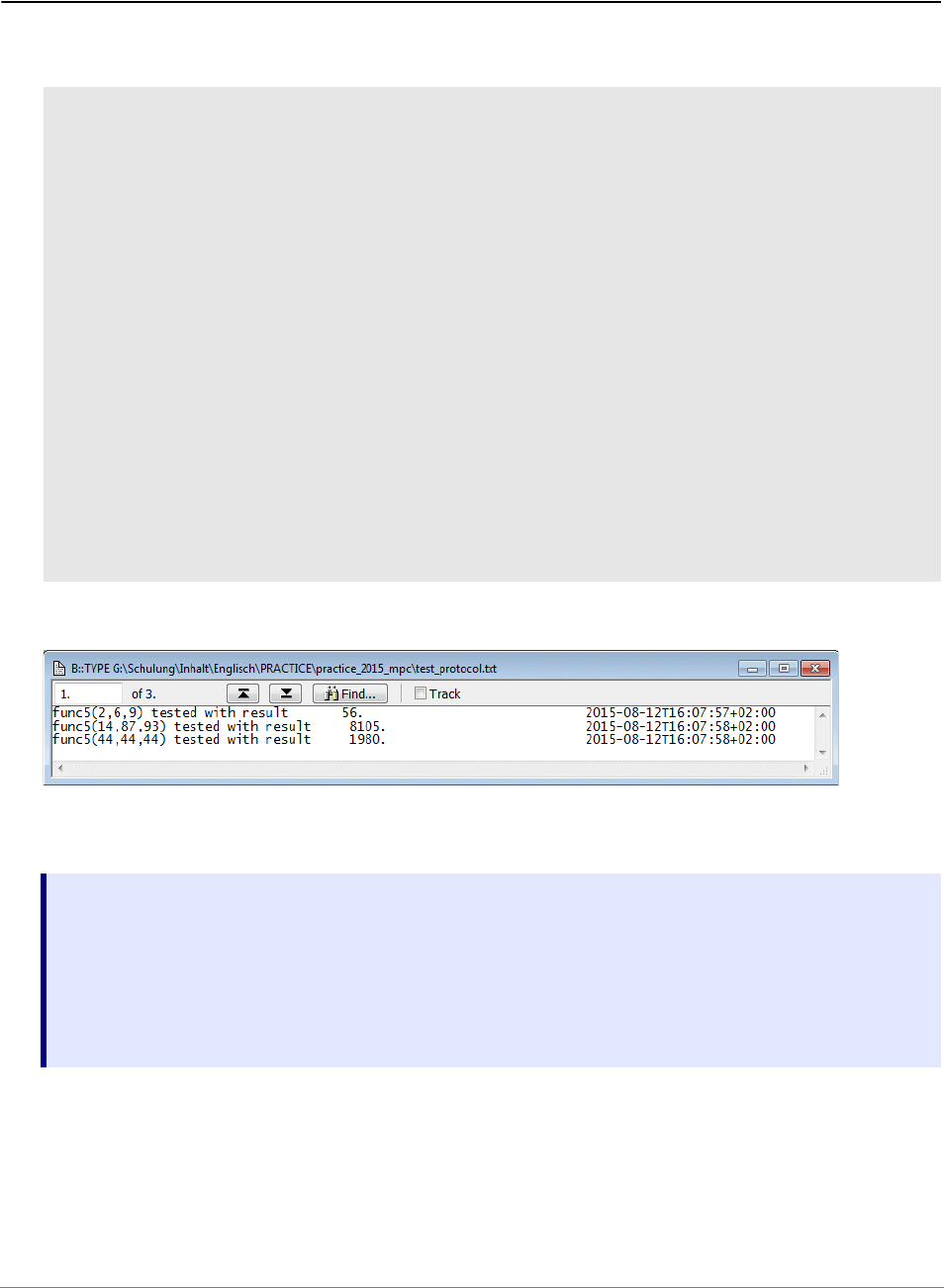
Training Script Language PRACTICE | 66
©
1989-2024 Lauterbach
Test Functions
Task of the script: Test functions with specified parameters and generate a test protocol.
Results for example in:
PRACTICE function
// Script test_function.cmm
...
PRIVATE &result
&result=FORMAT.Decimal(8.,Var.VALUE(func5(2,6,9)))
APPEND "test_protocol.txt" \
FORMAT.STRing("func5(2,6,9) tested with result &result",70.,' ') \
FORMAT.UnixTime("c",DATE.UnixTime(),DATE.utcOffSet())
&result=FORMAT.Decimal(8.,Var.VALUE(func5(14,87,93)))
APPEND "test_protocol.txt" \
FORMAT.STRing("func5(14,87,93) tested with result &result",70.,' ') \
FORMAT.UnixTime("c",DATE.UnixTime(),DATE.utcOffSet())
&result=FORMAT.Decimal(8.,Var.VALUE(func5(44,44,44)))
APPEND "test_protocol.txt" \
FORMAT.STRing("func5(44,44,44) tested with result &result",70.,' ') \
FORMAT.UnixTime("c",DATE.UnixTime(),DATE.utcOffSet())
...
FORMAT.Decimal(<width>,<value>) Formats a numeric expression to a decimal number
and generates an output string with a fixed length of
<width> with leading spaces.
Numeric expressions which need more characters than
<width> for their loss-free representation aren’t cut.
Var.VALUE(<function_call>) Returns the return value of called function as hex.
number.

Training Script Language PRACTICE | 67
©
1989-2024 Lauterbach
Test Function with Parameter File
Task of script: Test functions, but provide function name, parameters and expected result by a parameter
file. Generate a test protocol.
Example for a parameter file.
// Script test_func_param.cmm
LOCAL &testfunc &correct_result
OPEN #1 "func_test.txt" /READ
WHILE TRUE()
(
READ #1 &testfunc &correct_result
IF "&testfunc"!=""
(
GOSUB perform_test
)
ELSE
(
CLOSE #1
ENDDO
)
)
ENDDO
perform_test:
(
IF Var.VALUE(&testfunc)==&correct_result
(
APPEND "test_protocol.txt"\
FORMAT.STRing("&testfunc=&correct_result",50.,' ')\
FORMAT.UnixTime("c",DATE.UnixTime(),DATE.utcOffSet())
)
ELSE
(
PRIVATE &result
&result=CONVert.HEXTOINT(Var.VALUE(&testfunc))
APPEND "test_protocol.txt"\
FORMAT.STRing("&testfunc failed with &result (&correct_result)",50.,' ')\
FORMAT.UnixTime("c",DATE.UnixTime(),DATE.utcOffSet())
)
RETURN
)
func5(22,12,17) 56.
func5(14,87,93) 8105.
func5(44,44,44) 1980.
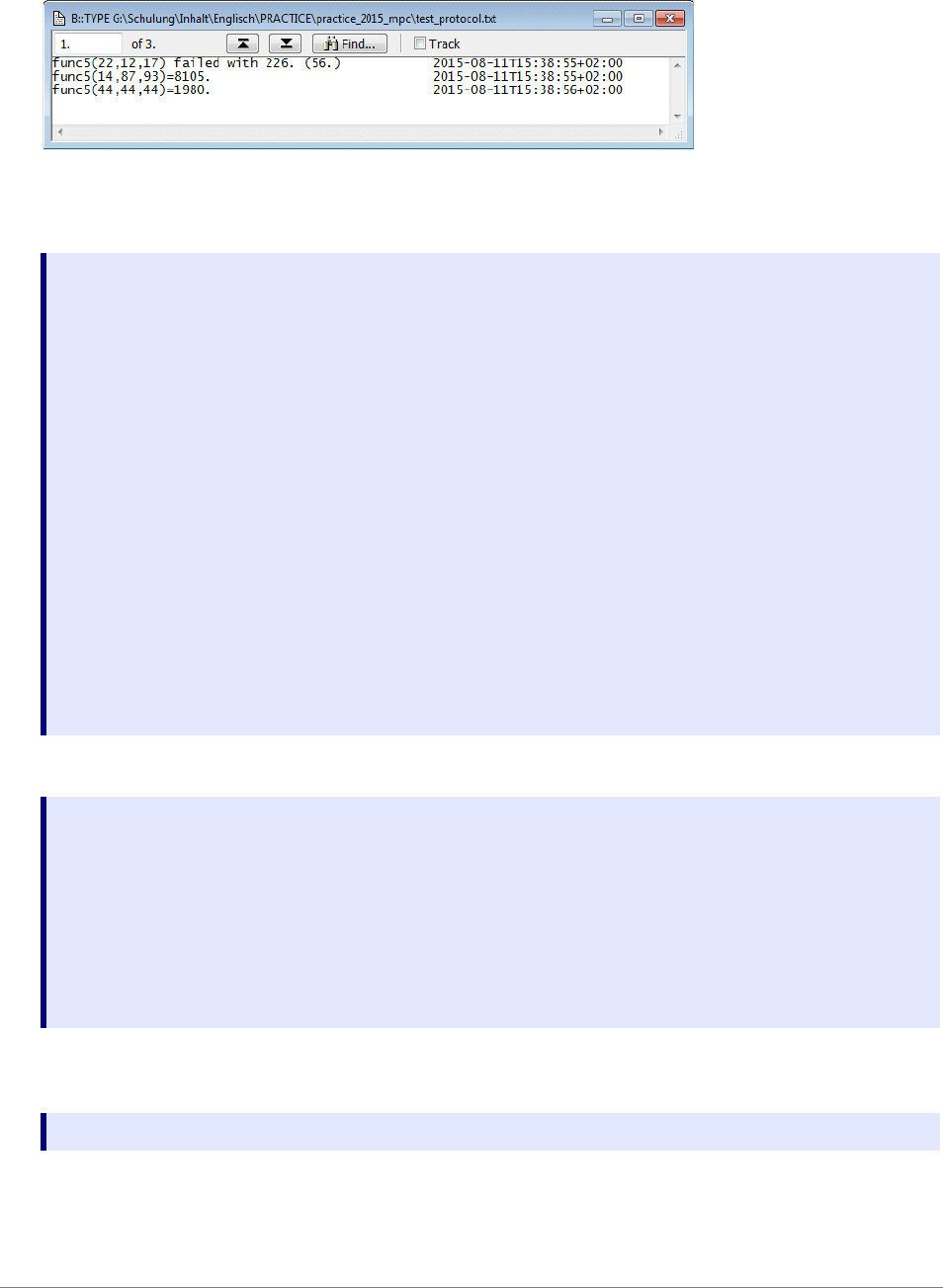
Training Script Language PRACTICE | 68
©
1989-2024 Lauterbach
Results for example in:
PRACTICE command
TRACE32 function
GOSUB <label> Call a subroutine. The start of the subroutine is identified by <label>.
Labels must start in the first column of a line and end with a colon. No
preceding white space allowed.
Subroutines are usually located after the ENDDO statement.
RETURN Return from subroutine.
LOCAL <macro> Creates a local PRACTICE macro.
Local PRACTICE macros are visible inside the declaring block, in all
called scripts and in all called subroutines.
They are erased when the declaring block ends. The declaring block
here is the script itself.
WHILE <condition>
(
<block>
)
Execute <block> as long as <condition> is true.
OPEN #<buffer_number> <filename> /Read Open file <filename> for reading. The file is
referenced by its #<buffer_number> by the
following commands.
READ #<buffer_number> {<macro>} Read next line from file referenced by
#<buffer_number> into PRACTICE macros.
Space serves as parameter separators.
CLOSE #<buffer_number> Close file referenced by #<buffer_number>.
CONVert.HEXTOINT(<number>) Convert <number> to a decimal number.

Training Script Language PRACTICE | 69
©
1989-2024 Lauterbach
Parameter Passing
Pass Parameters to a PRACTICE Script or to a Subroutine
The ENTRY command can be used to
• Pass parameters to a PRACTICE script or to a subroutine
• To return a value from a subroutine
ENTRY <parlist>

Training Script Language PRACTICE | 70
©
1989-2024 Lauterbach
Example 1: Pass parameters to a PRACTICE script
; PRACTICE script patch.cmm
; DO patch.cmm 0x1000++0xff 0x01 0x0a
ENTRY &address_range &data_old &data_new
IF "&address_range"==""
(
PRINT "Address range parameter is missing"
ENDDO
)
IF "&data_old"==""
(
PRINT "Old data parameter is missing"
ENDDO
)
IF "&data_new"==""
(
PRINT "New data parameter is missing"
ENDDO
)
Data.Find &address_range &data_old
IF FOUND()
(
Data.Set TRACK.ADDRESS() &data_new
Data.Print TRACK.ADDRESS()
DIALOG.OK "Patch done"
)
ELSE
DIALOG.OK "Patch failed"
ENDDO
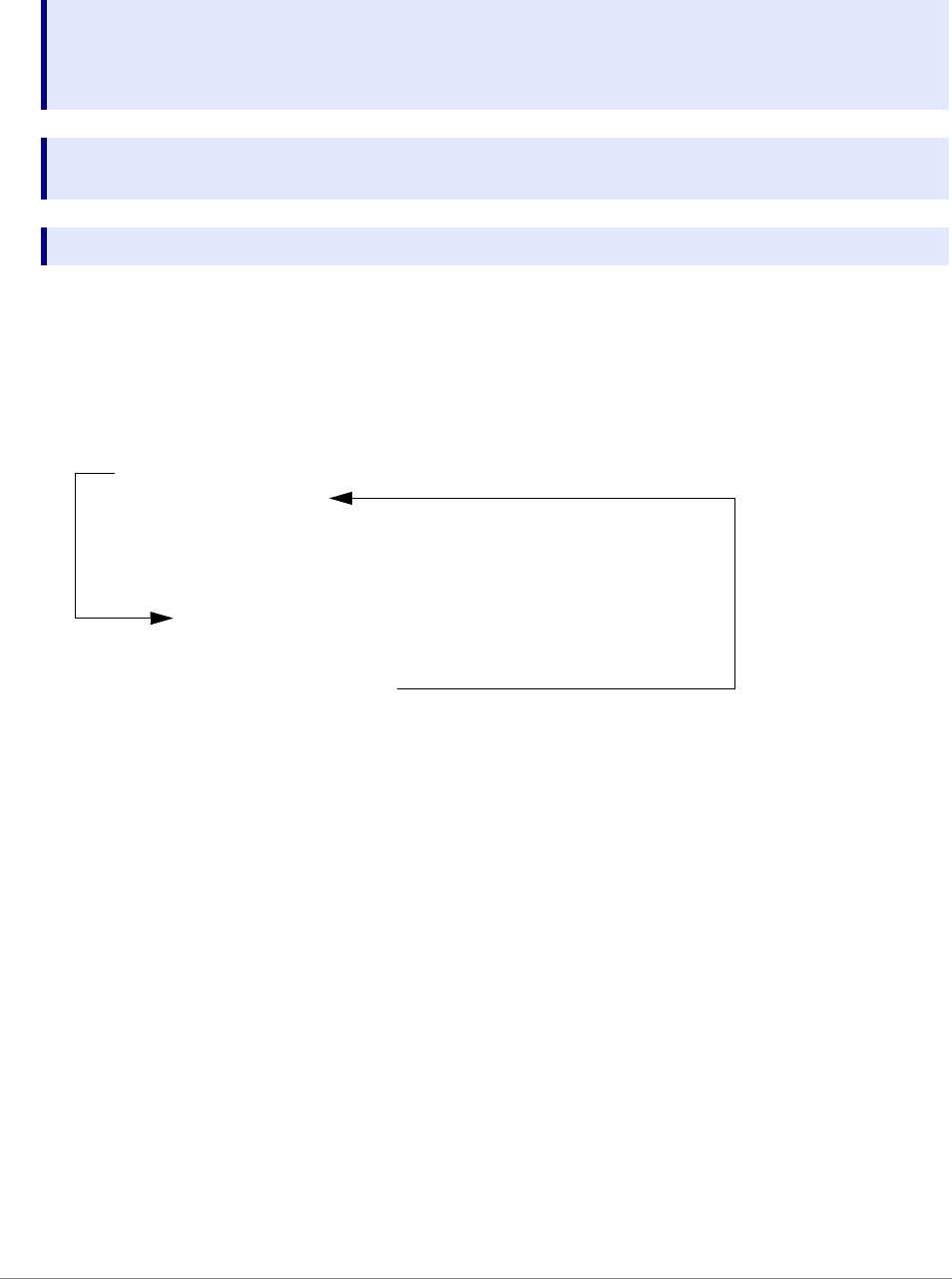
Training Script Language PRACTICE | 71
©
1989-2024 Lauterbach
TRACE32 commands
Example 2: Pass parameters to a subroutine and get back the return value
Data.FIND <address_range> <data> Search for <data> in the specified <address_range>.
TRACE32 functions served:
FOUND()
TRACK.ADDRESS()
FOUND() Returns a boolean value to denote the results of the last
DATA.FIND command.
TRACK.ADDRESS() Returns the address of the last successful search.
; PRACTICE script param.cmm
GOSUB test sieve++0x20 0x01
ENTRY &found
PRINT "Data found at address " &found
ENDDO
test:
ENTRY &address_range &data
Data.Find &address_range &data
&result=ADDRESS.OFFSET(TRACK.ADDRESS())
RETURN &result
Pass parameter to subroutine
Get back the return value
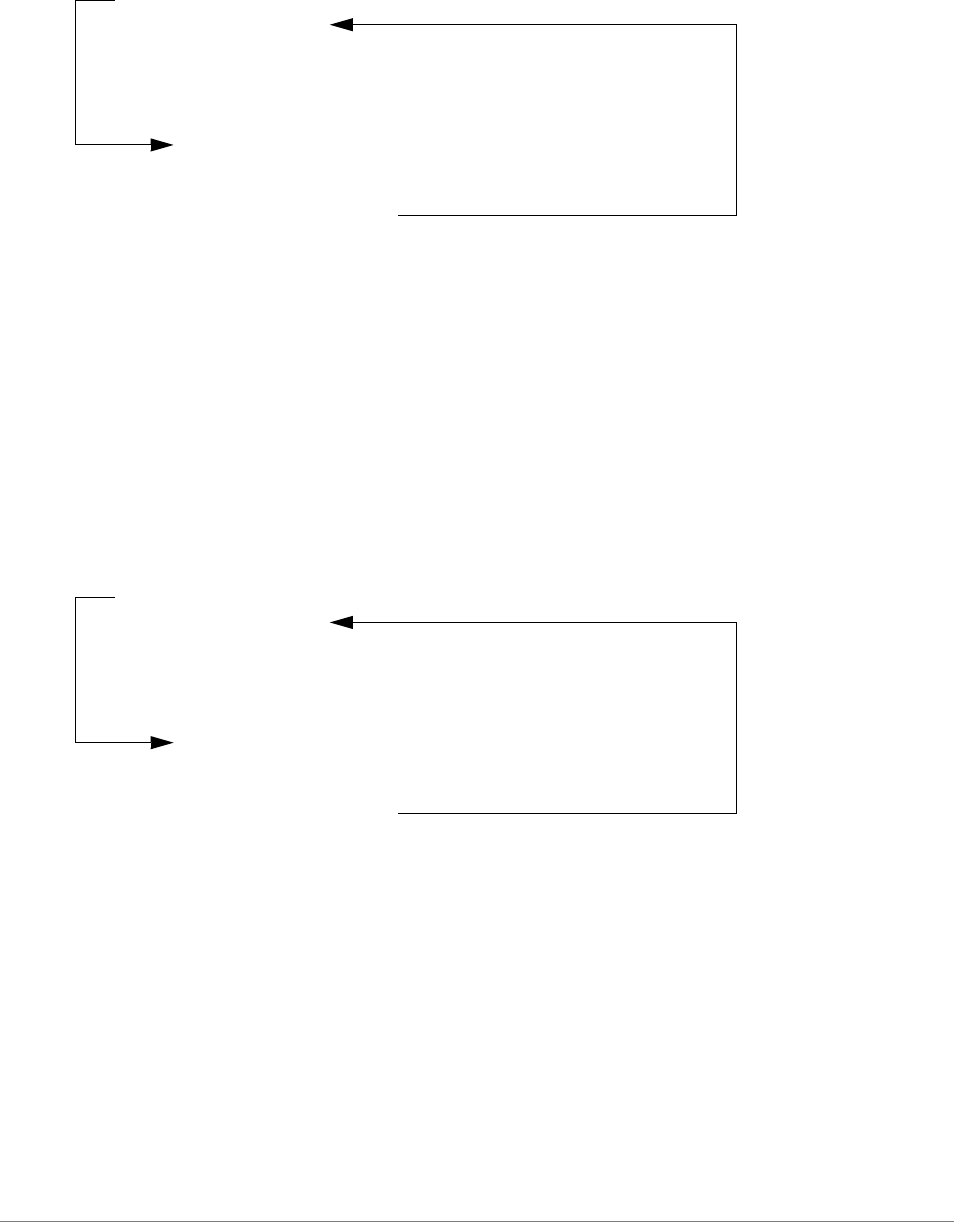
Training Script Language PRACTICE | 72
©
1989-2024 Lauterbach
Example 3: Pass arguments as a single parameter to a subroutine and get back the return value
Alternatively, the function PARAMETERS can be used to read parameters passed to a script or subroutine
and, if the macros do not already exist in the current scope, assign them to automatically created PRIVATE
macros. The parameters must be enclosed in quotation marks (").
Example 4: Pass arguments using PARAMETERS to a subroutine and get back the return value
; PRACTICE script param.cmm
GOSUB test sieve++0x20 0x01
ENTRY &found
PRINT "Data found at address " &found
ENDDO
test:
ENTRY %LINE &values
Data.Find &values
&result=ADDRESS.OFFSET(TRACK.ADDRESS())
RETURN &result
Pass parameter to subroutine
Get back the return value
; PRACTICE script param.cmm
GOSUB test "sieve++0x20" "0x01"
ENTRY &found
PRINT "Data found at address " &found
ENDDO
test:
PARAMETERS &address_range &data
Data.Find &address_range &data
&result=ADDRESS.OFFSET(TRACK.ADDRESS())
RETURN &result
Pass parameters to subroutine
Get back the return value
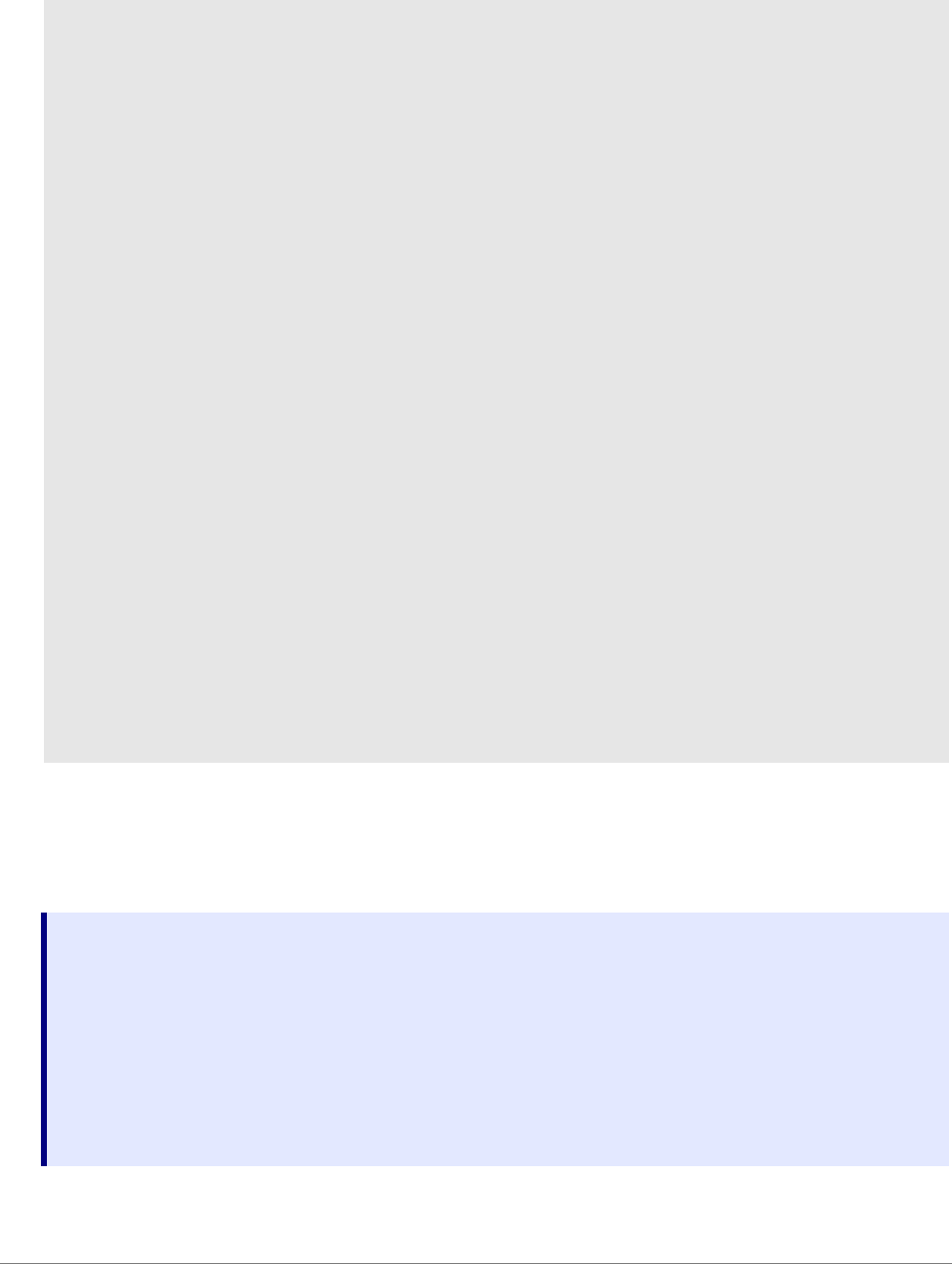
Training Script Language PRACTICE | 73
©
1989-2024 Lauterbach
Example 5: Passing arguments via the command line. If the values for &data_old and &data_new are not
provided default values are assigned.
Passing parameters into scripts like this means that the user must know the order in which each parameter
must be specified. A more flexible approach is to use the function STRing.SCANAndExtract().
; PRACTICE script patch_not_all.cmm
; Call with:
; DO patch_not_all.cmm "<address_range>" "<data_old>" "<data_new>"
PARAMETERS &address_range &data_old &data_new
IF "&data_old"==""
(
&data_old=0x00
)
IF "&data_new"==""
(
&data_new=0xFF
)
DATA.Find &address_range &data_old
IF FOUND()
(
Data.Set TRACK.ADDRESS() &data_new
Data.Print TRACK.ADDRESS()
DIALOG.OK "Patch Done"
)
ELSE
(
DIALOG.OK "Patch Failed."
)
ENDDO
STRing.SCANAndExtract("<source>", "<search>", "<default>") The <source> string is
searched for the pattern
<search> and if it is found the
character sequence after and
up to the next blank space is
assigned to the PRACTICE
macro. If the <search> string
is not found the value
<default> is assigned
instead.

Training Script Language PRACTICE | 74
©
1989-2024 Lauterbach
.
;Call this script with:
; do arg_test.cmm ADDRESS=<address> DATA=<data> COUNT=<count>
;Read all command line arguments as a single line
ENTRY %LINE &p
;Open an AREA window and clear it for displaying the results
AREA.view
AREA.CLEAR
;If the ADDRESS argument is not provided, print a usage message
IF STRing.SCAN("&p","ADDRESS=",0)==-1
(
GOSUB print_args
)
;Extract the arguments into the correct PRACTICE variables, returning the
;default value if the user does not specify something.
&addr=STRing.SCANAndExtract(STRING.UPpeR("&p"), "ADDRESS=", "0x12000")
&dvalue=STRing.SCANAndExtract(STRING.UPpeR("&p"),"DATA=", "0x00")
&count=STRing.SCANAndExtract(STRING.UPpeR("&p"),"COUNT=","5.")
PRINT "Extracted Arguments:"
PRINT "ADDRESS = &addr"
PRINT "DATA = &dvalue"
PRINT "COUNT = &count"
ENDDO
print_args:
PRINT "Usage:"
PRINT
PRINT "do arg_test.cmm ADDRESS=<address> DATA=<data> COUNT=<count>"
PRINT "Where:"
PRINT " <address> is the address to write <data> to."
PRINT " <count> is the number of times to write the <data> value."
PRINT
PRINT "Script will complete using default values."
PRINT
RETURN
STRing.UPpeR(<string>) Returns <string> in upper case.
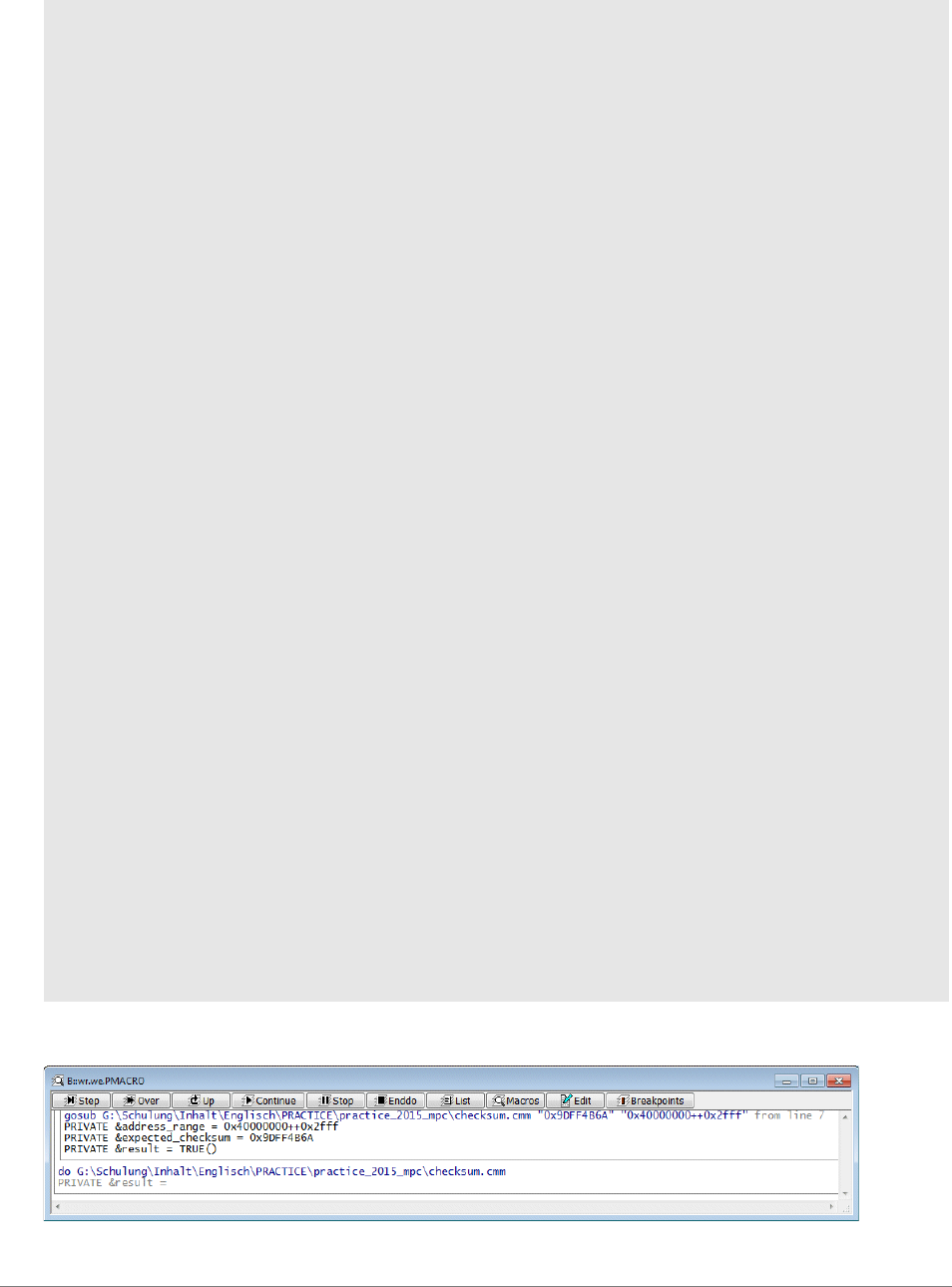
Training Script Language PRACTICE | 75
©
1989-2024 Lauterbach
Example 6: Call a subroutine to verify a checksum for a given range.
PRIVATE macros that are out scope are printed in gray in the PRACTICE stack.
; PRACTICE script checksum.cmm
PRIVATE &result
AREA.view
AREA.CLEAR
DATA.LOAD.BINARY checksum.bin 0x40000000
GOSUB verify_checksum "0x9DFF4B6A" "0x40000000++0x2fff"
RETURNVALUES &result
IF &result
PRINT %COLOR.GREEN "First checksum verification passed"
ELSE
PRINT %COLOR.RED "First checksum verification failed"
WAIT 1.s
; Modify memory
Data.Set 0x40000100 %Long 0x12345678
GOSUB verify_checksum "0x9DFF4B6A" "0x40000000++0x2fff"
RETURNVALUES &result
IF &result
PRINT %COLOR.GREEN "Second checksum verification passed"
ELSE
PRINT %COLOR.RED "Second checksum verification failed"
ENDDO
verify_checksum:
(
PRIVATE &result
PARAMETERS &expected_checksum &address_range
Data.SUM &address_range /CRC32
&result=(Data.SUM()==&expected_checksum)
RETURN "&result"
)
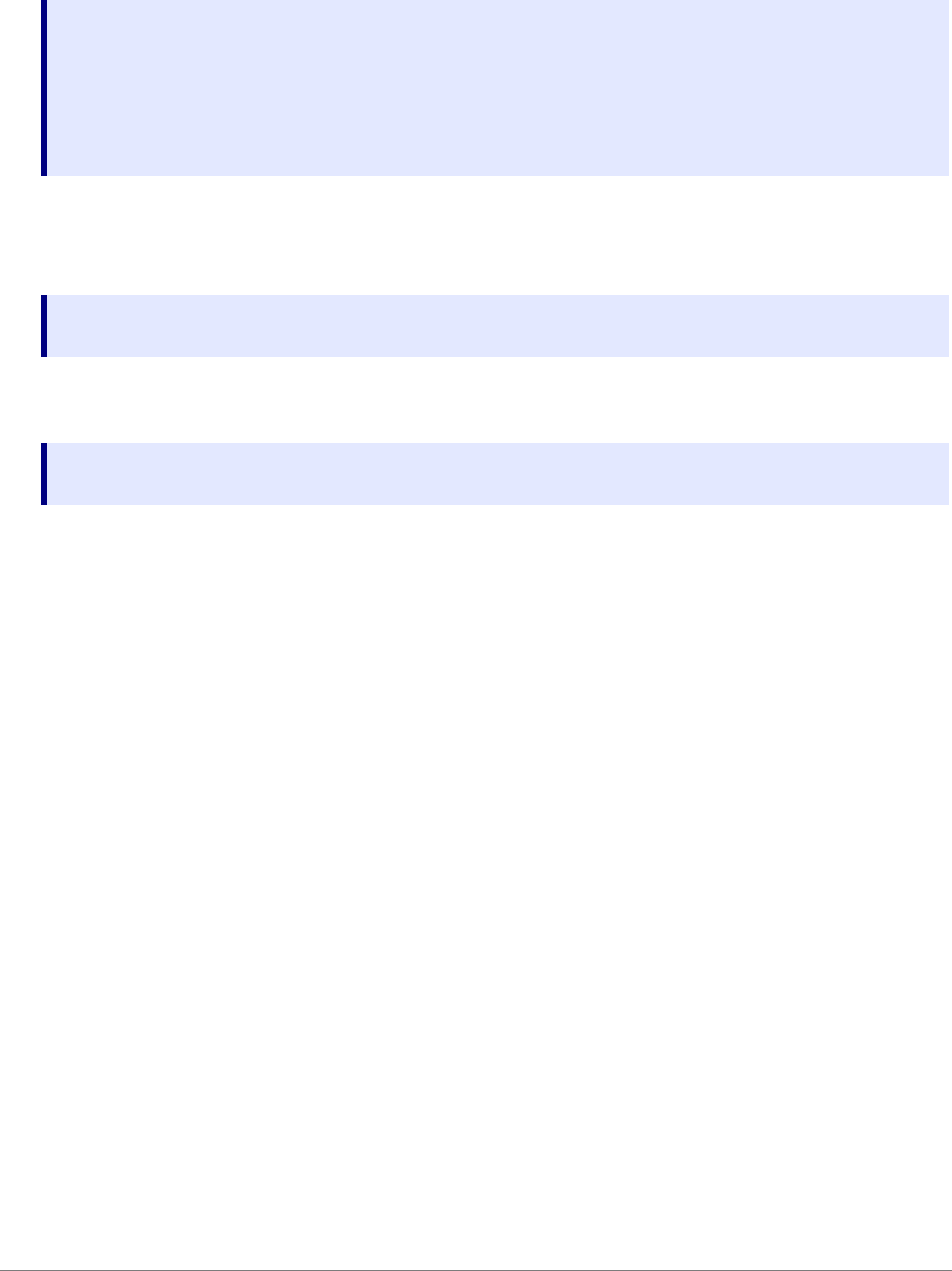
Training Script Language PRACTICE | 76
©
1989-2024 Lauterbach
TRACE32 commands
PRACTICE command
TRACE32 function
AREA.view Display TRACE32 message area.
AREA.CLEAR Clear TRACE32 message area.
Data.Set <address> <value> Write <value> to <address>.
Data.SUM <address_range> /CRC32 Calculate CRC32 checksum for specified
<address_range>.
PRINT %COLOR.<color> {<data>} Print the specified data in the specified color to the
TRACE32 message area.
Data.SUM() Returns checksum calculated by the Data.SUM
command as hex. number.
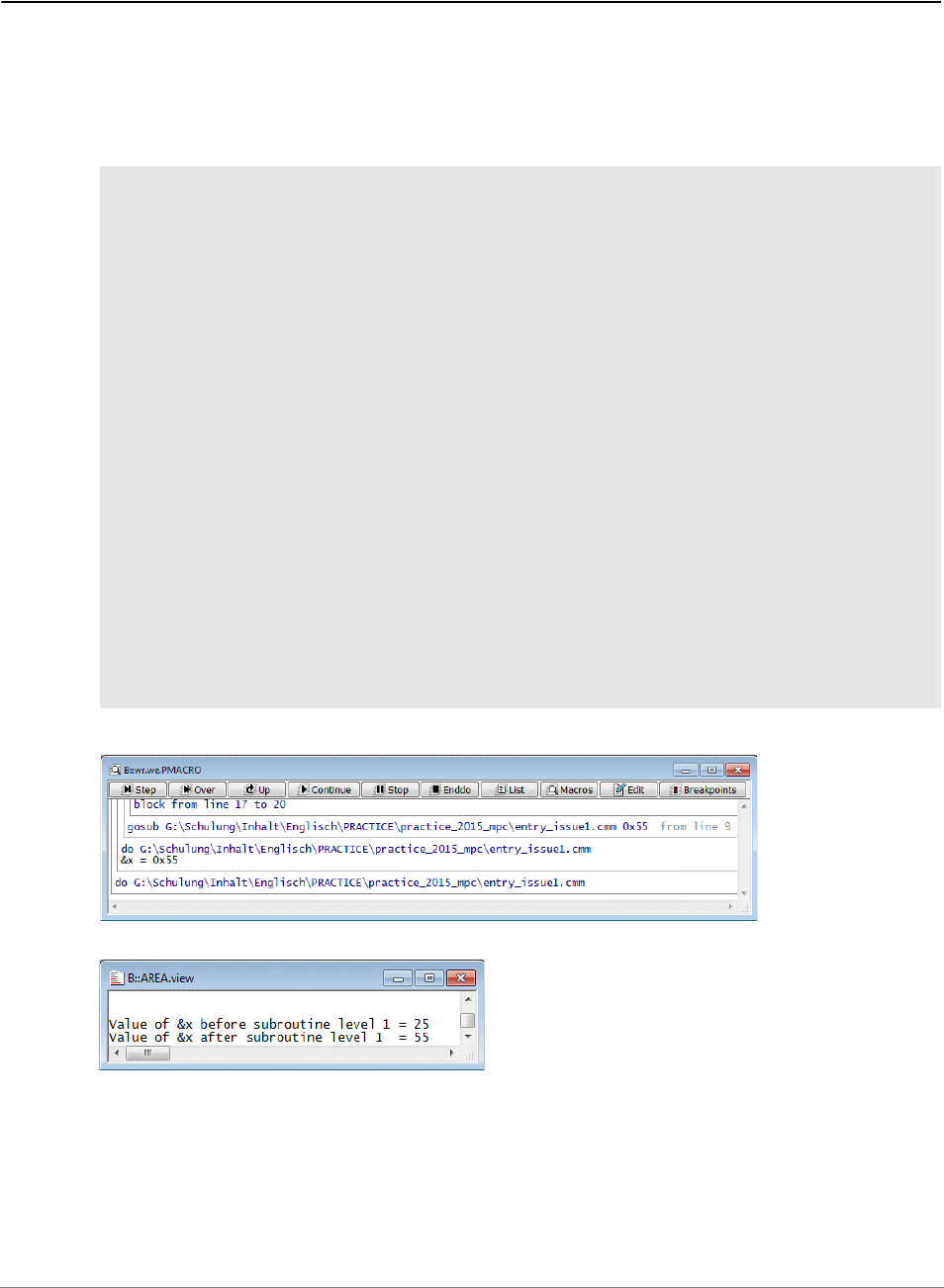
Training Script Language PRACTICE | 77
©
1989-2024 Lauterbach
PARAMETERS/RETURNVALUES vs. ENTRY
Using the PRACTICE commands PARAMETERS/RETURNVALUES solve the following issues known for
the ENTRY command.
1. Called script/subroutine may unintentionally overwrite LOCAL macros of the caller(s), if
the macros used with the ENTRY command are not explicitly created.
// Script entry_issue1.cmm
AREA.view
AREA.CLEAR
LOCAL &x
&x=0x25
PRINT "Value of &"+"x before subroutine level 1 = " &x
GOSUB level1 0x55
PRINT "Value of &"+"x after subroutine level 1 = " &x
ENDDO
level1:
(
ENTRY &x
RETURN
)
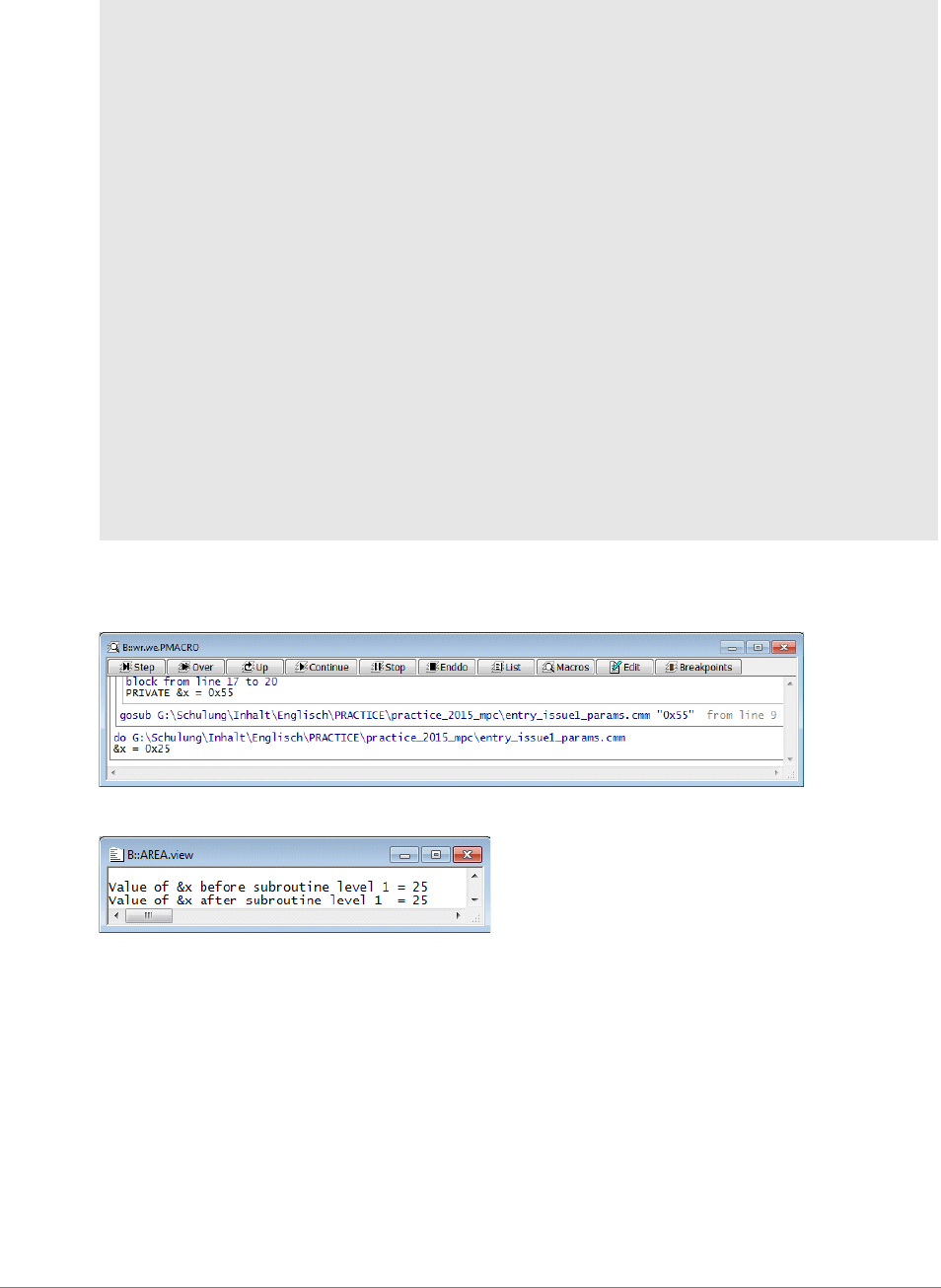
Training Script Language PRACTICE | 78
©
1989-2024 Lauterbach
Notice that the LOCAL macros of the caller(s) are out of scope for the PARAMETERS command. So
a new PRIVATE macro &x is created.
// Script entry_issue1_params.cmm
AREA.view
AREA.CLEAR
LOCAL &x
&x=0x25
PRINT "Value of &"+"x before subroutine level 1 = " &x
GOSUB level1 "0x55"
PRINT "Value of &"+"x after subroutine level 1 = " &x
ENDDO
level1:
(
PARAMETERS &x
RETURN
)
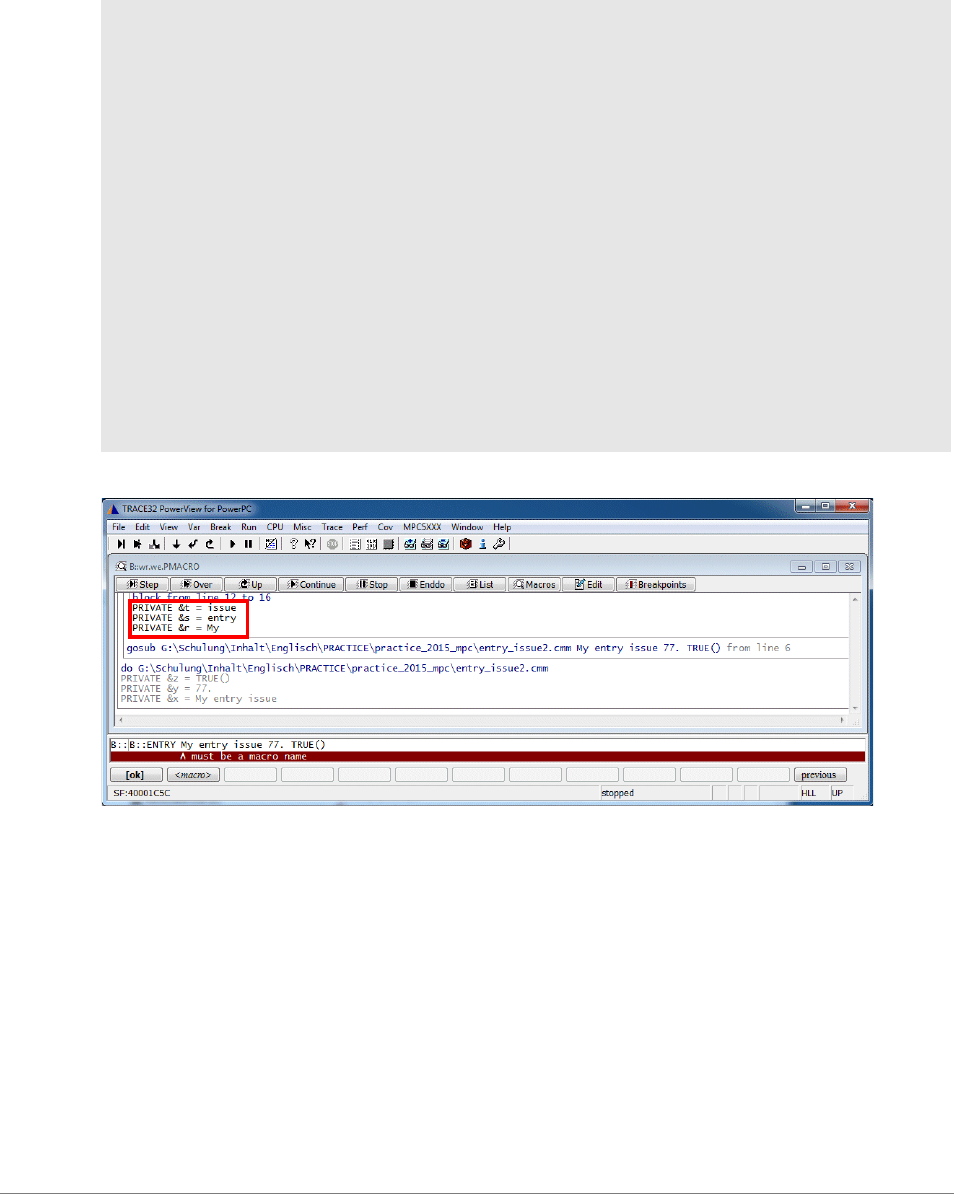
Training Script Language PRACTICE | 79
©
1989-2024 Lauterbach
2. Whitespace as parameter delimiter.
The ENTRY command regards whitespace as a parameter delimiter. If one of the parameters for the
called script/subroutine is a string containing whitespaces and it is not quoted, the script is stopped by
an error, because not enough macros are provided to take all parameters.
// Script entry_issue2.cmm
PRIVATE &x &y &z
&x="My entry issue"
&y=77.
&z=TRUE()
GOSUB level1 &x &y &z
ENDDO
level1:
(
PRIVATE &r &s &t
ENTRY &r &s &t
RETURN
)

Training Script Language PRACTICE | 80
©
1989-2024 Lauterbach
3. The quote issue.
If the string containing whitespaces is quoted, the quotes become part of the string if the ENTRY
command is used.
// Script entry_issue3.cmm
PRIVATE &x &y &z
&x="My entry issue"
&y=77.
&z=TRUE()
GOSUB level1 "&x" &y &z
ENDDO
level1:
(
PRIVATE &r &s &t
ENTRY &r &s &t
&r=&r // Removes quotes from string
RETURN
)
// Trick to remove of the quotes
&r=&r
Macro contains string (no quotes)
Macro contains string (with quotes)
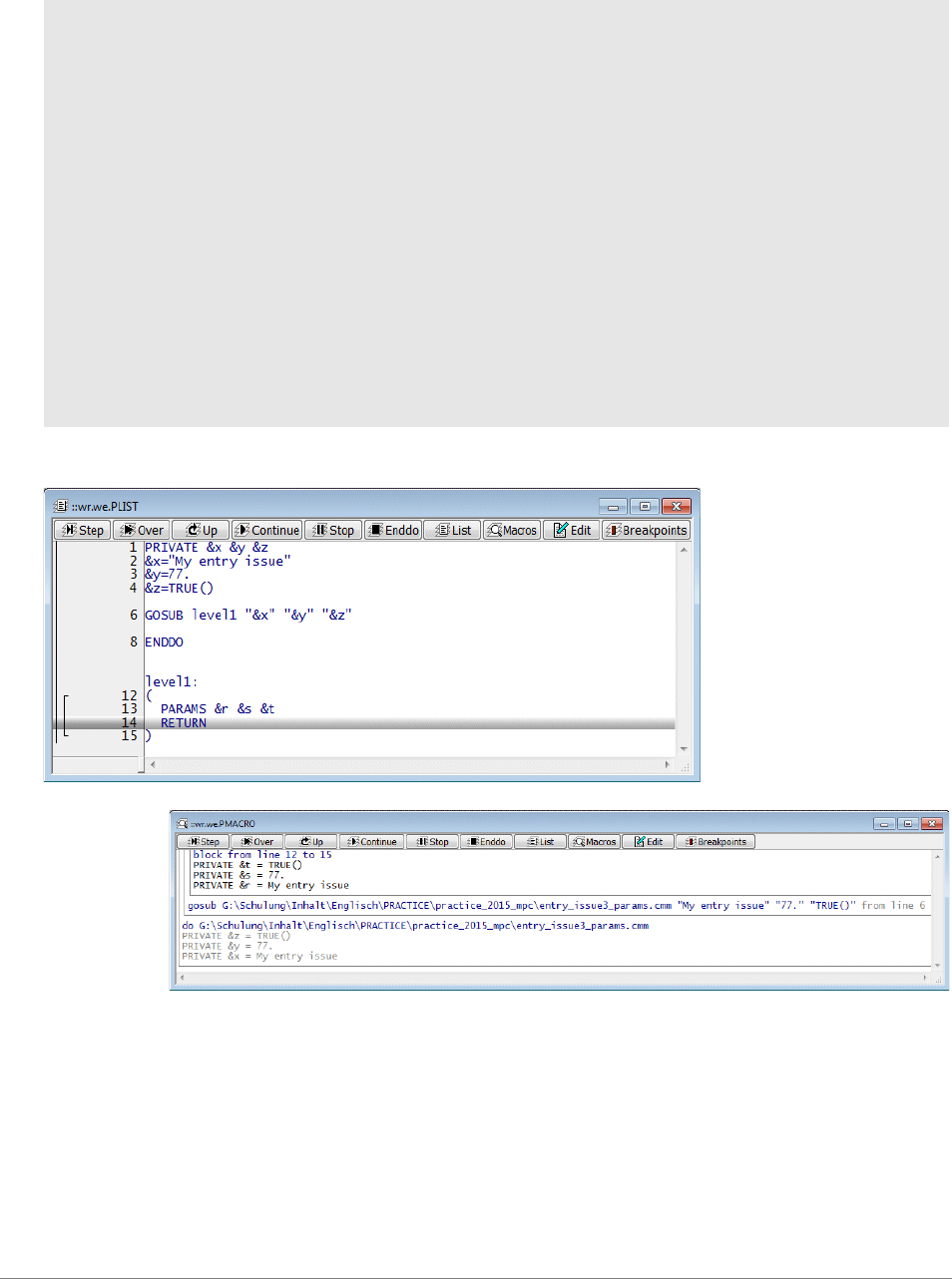
Training Script Language PRACTICE | 81
©
1989-2024 Lauterbach
The PARAMETERS command solves both issues.
// Script entry_issue3_params.cmm
PRIVATE &x &y &z
&x="My entry issue"
&y=77.
&z=TRUE()
GOSUB level1 "&x" "&y" "&z"
ENDDO
level1:
(
PARAMETERS &r &s &t
RETURN
)

Training Script Language PRACTICE | 82
©
1989-2024 Lauterbach
Operating System Interaction
PRACTICE can interact with the Operating System on the host computer. A well written PRACTICE script
can hide the differences in underlying Operating System and present a unified experience to the user.
Operating System Detection
Sometimes differences in the underlying host Operating System require the PRACTICE script to be a bit
more flexible in order to be truly portable. The function OS.VERSION(0) can be used to detect the host
Operating System.
;Printout host OS
IF OS.VERSION(0)>=0x50
PRINT "Unkown OS"
ELSE IF OS.VERSION(0)>=0x40
PRINT "Mac OS X"
ELSE IF OS.VERSION(0)>=0x30
PRINT "HP-UX"
ELSE IF OS.VERSION(0)>=0x10
PRINT "Linux"
ELSE
PRINT "MS Windows"
ENDDO
;Open a serial terminal - host dependent code
TERM.RESet
IF OS.VERSION(0)<0x10 ;MS Windows
(
TERM.METHOD COM COM1 9600. 8 NONE 1STOP NONE
)
ELSE ;Linux?
(
TERM.METHOD COM /dev/ttyS0 9600. 8 NONE 1STOP NONE
)
TERM.SCROLL ON
TERM.view
ENDDO

Training Script Language PRACTICE | 83
©
1989-2024 Lauterbach
Printing Results
Results can be sent to the system clipboard, a file or a connected printer. Physical printers must be
configured correctly in the TRACE32 configuration file (usually ~~/config.t32), although Windows users
will not need to do anything here.
To print results:
1. Select a printer using PRinTer.select (for manual selection via GUI), PRinTer.FILE.
2. Optionally format the output: PRinTer.FileType | PRinTer.ClipBoard / PRinTer.SIZE
/PRinTer.OFFSET
3. Open a connection to the printer with PRinTer.OPEN. Use PRinTer.EXPORT to generate CSV
data.
4. Re-direct the output from the command to the chosen printer using WinPrint.<command>
5. Close the printer connection with PRinTer.CLOSE
For a more detailed explanation of the commands and options, refer to “PRinTer” in PowerView Command
Reference, page 244 (ide_ref.pdf).
; Example 1 – save a memory dump to a file
LOCAL &file
; Get a temporary file from the OS
&file=OS.TMPFILE()
PRinTer.FILE "&file"
PRinTer.FileType ASCIIE
WinPrint.Data.dump 0x2200--0x22FF
&file="&file"+".lst"
; Display the results
TYPE "&file"
ENDDO

Training Script Language PRACTICE | 84
©
1989-2024 Lauterbach
; Example 2 – Save two memory dumps as CSV files for viewing in Excel
LOCAL &file
&file=OS.TMPFILE()
; Adding a numerical suffix to the file name will allow
; PRinTer.EXPORT to automatically increment the filename
; each time it is used. Otherwise it over-writes the existing file.
&file="&file"+"-1"
PRinTer.EXPORT.default "&file"
WinPrint.Data.dump 0x2200--0x22FF /Word
WinPrint.Data.dump 0x2300--0x23FF /Byte
&file="&file"+".lst"
TYPE "&file"
&file=STRing.Replace("&file","-1.lst","-2.lst",0)
TYPE "&file"
ENDDO
; Example 3 – Save the same memory dump as ASCII and CSV to
; the same file
LOCAL &file
&file=OS.TMPFILE()
; Set format to CSV initially
PRinTer.FileType CSV
PRinTer.OPEN "&file"
WinPrint.Data.dump 0x2200--0x22FF /Word
; Close the file, set the format to ASCIIE, then re-open the
; file to append new data
PRinTer.CLOSE
PRinTer.FileType ASCIIE
PRinTer.OPEN "&file" /Append
WinPrint.Data.dump 0x2200--0x22FF /Word
PRinTer.CLOSE
&file="&file"+".lst"
TYPE "&file"
ENDDO

Training Script Language PRACTICE | 85
©
1989-2024 Lauterbach
Accessing Environment Variables
Environment variables can be accessed from a PRACTICE script by using the function
OS.ENV("<env_var>"). The value of the variable is returned and can be assigned to a PRACTICE macro.
A more extensive example which will run on Windows, Linux or MacOS can be found at
~~/demo/practice/my_environment.cmm.
; This example will only work on a Windows host
LOCAL &username
&username=OS.ENV("USERNAME")
AREA.view
PRINT "Hello, &username"
ENDDO
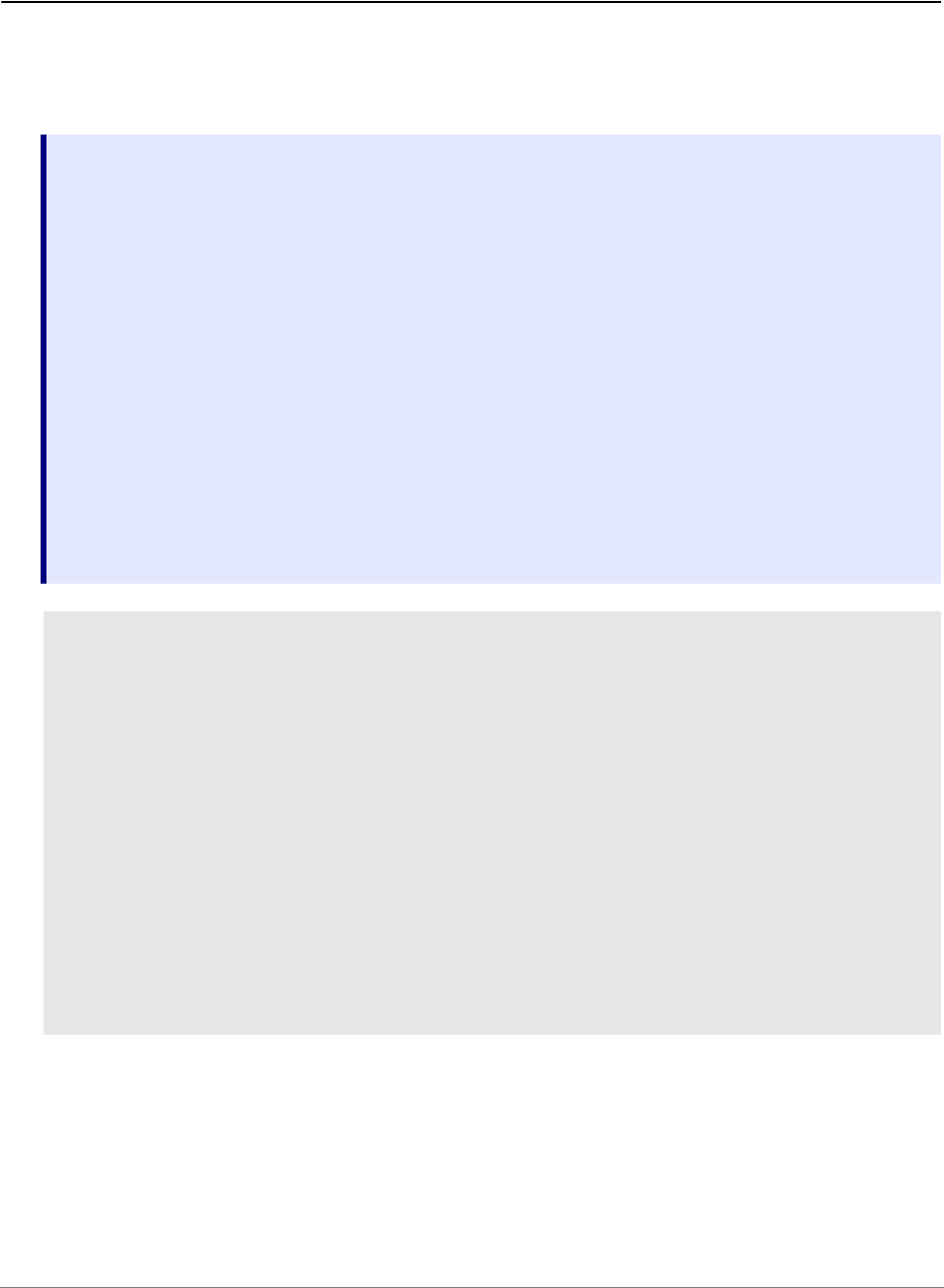
Training Script Language PRACTICE | 86
©
1989-2024 Lauterbach
Running a Command
The OS.* family of commands can be used to launch programs on the host Operating System from within a
PRACTICE scripts. A brief overview is given here but more information can be found at “OS” in PowerView
Command Reference, page 224 (ide_ref.pdf).
OS.Area <cmdline> Execute a command on the host. The results will be displayed
in the AREA window. the script will block until the command
has completed.
OS.Command <cmdline> Execute multiple commands on the host (use host native
piping). PRACTICE macros can be inserted into the
command line. On Windows hosts, the first argument must be
the command interpreter (CMD.EXE). On Windows hosts the
PRACTICE script does not block. On other hosts use ’&’ to
force non-blocking behavior.
OS.Hidden <cmdline> Execute a command; the output is discarded. PRACTICE
script blocks until the command completes.
OS.screen <cmdline> Open a host shell and execute the command line. This is non-
blocking.
OS.Window <cmdline> Execute a host command and all output will be re-directed to a
new TRACE32 window. This is non-interactive and the
PRACTICE script blocks until the command has completed.
; List all *.cmm files in the current AREA window
; For Windows hosts
OS.Area dir *.cmm
; For Linux/MacOS hosts
OS.Area ls –l *.cmm
; List all *.cmm files in a new TRACE32 window (OS.Window)
; For Windows hosts
OS.Window dir *.cmm
; For Linux/MacOS hosts
OS.Window ls –l *.cmm
; List all *.cmm files to a file in the user’s home directory
; For Windows hosts
OS.Command CMD /C dir *.cmm > %USERPROFILE%/tmpfile.lst
; For Linux/MacOS hosts
OS.Command ls –l *.cmm > $HOME/tmpfile.lst
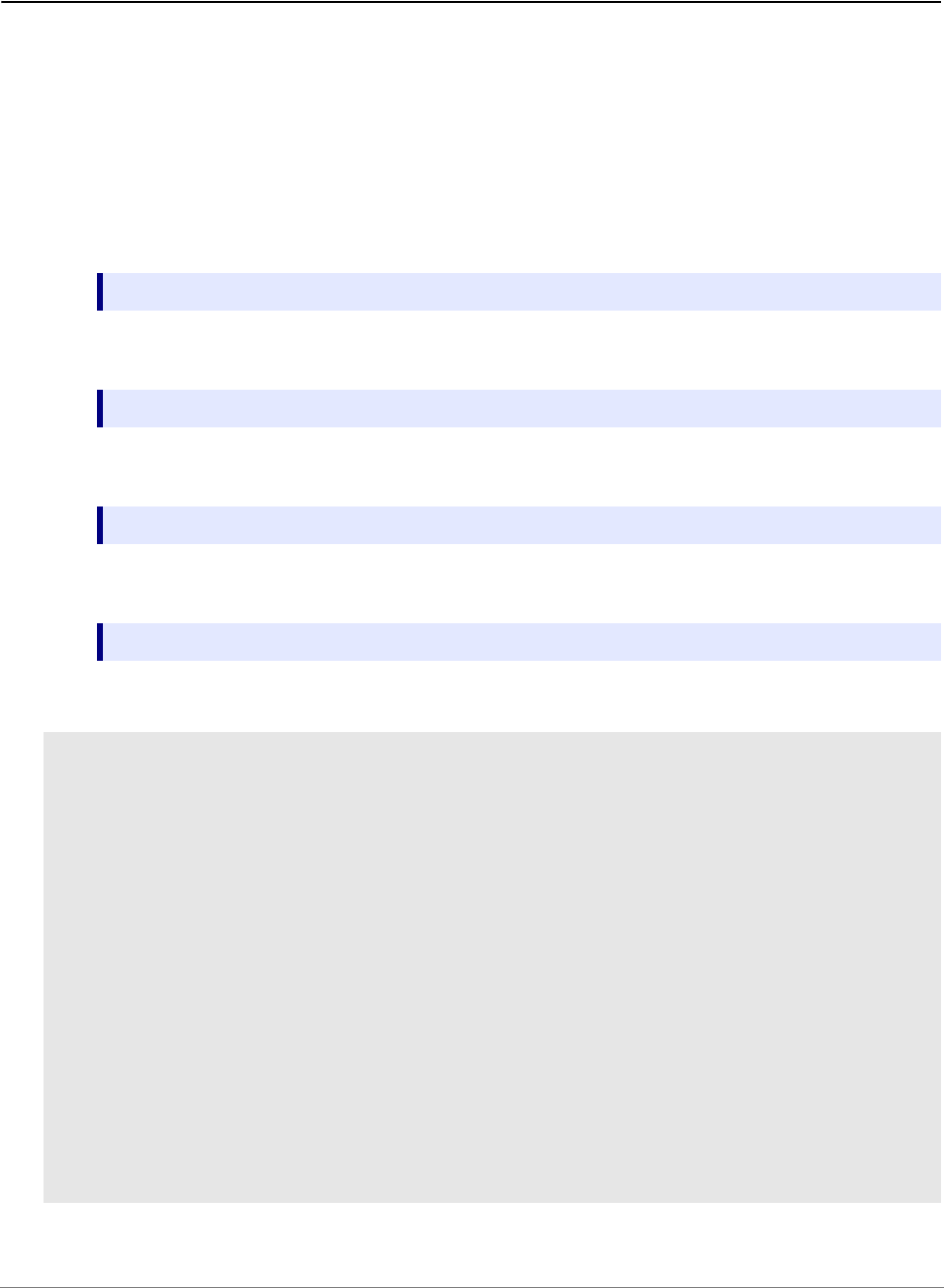
Training Script Language PRACTICE | 87
©
1989-2024 Lauterbach
File Manipulation
A PRACTICE script can manipulate files in the host Operating System file system (display, copy, delete,
etc.). A number of commands are available and it is recommended to use these instead of the underlying
Operating Systems’ native commands to make scripts more portable. More information can be found at
“File and Folder Operations” in PowerView User’s Guide, page 71 (ide_user.pdf).
In addition, PRACTICE supports 9 file handles (#1 through #9) that are used to open, close, read and write
files.
• Open file
• Close file
• Read data from an open file
• Write data to an open file
OPEN #<buffer> <filename> / Read | Write | Create | Binary
CLOSE #<buffer>
READ #<buffer> [ %LINE ] <parlist>
WRITE #<buffer> <parlist>
; Assume file "file.txt" contains
; Hello and Welcome
; Read each word
LOCAL &arg1 &arg2 &arg3 &line
OPEN #1 "file.txt" /Read
READ #1 &arg1 &arg2 &arg3
CLOSE #1
; Print them in reverse order
AREA.view
PRINT "&arg3 &arg2 &arg1"
; Read the entire line
OPEN #1 "file.txt" /Read
READ #1 %LINE &line
CLOSE #1
PRINT "Line Reads: &line"
ENDDO

Training Script Language PRACTICE | 88
©
1989-2024 Lauterbach
Data can be written using WRITE or WRITEB (for binary data).
; Example of writing text data to a file in different styles
LOCAL &fname &sname &file
DIALOG.view
(
HEADER "Write Test"
POS 0. 0. 30. 4.
BOX "Please Enter your details"
POS 1. 1. 10. 1.
TEXT "First name:"
POS 1. 2. 10. 1.
TEXT "Last name:"
POS 12. 1. 17. 1.
F: DEFEDIT "" ""
POS 12. 2. 17. 1.
S: EDIT "" ""
POS 24. 4. 6. 1.
DEFBUTTON "OK" "CONTinue"
)
STOP
&fname=DIALOG.STRING(F)
&sname=DIALOG.STRING(S)
DIALOG.END
&file=OS.TMPFILE()
OPEN #1 "&file" /CREATE
; Write first line
WRITE #1 "File saved for &fname &sname"
; Write second line which should be identical to the first
WRITE #1 "File saved for "+"&fname"+" "+"&sname"
; Write third line which will be identical to the other two
; The %CONTinue allows the current line to be on the same line as the
; previous write.
WRITE #1 "File saved for " "&fname"
WRITE #1 %CONTinue " " "&sname"
; Close the file
CLOSE #1
TYPE &file
ENDDO

Training Script Language PRACTICE | 89
©
1989-2024 Lauterbach
; Example of writing binary data to a file
LOCAL &file
&file=OS.TMPFILE()
OPEN #2 "&file" /Binary /Create
WRITEB #2 0x48 0x65 0x6C 0x6C 0x6F
WRITEB #2 0x20 0x57 0x6F 0x72 0x6C 0x64
CLOSE #2
TYPE &file
ENDDO

Training Script Language PRACTICE | 90
©
1989-2024 Lauterbach
These techniques can be combined with the printing to a file method from earlier to extract and parse
information from a target system. The example below shows how to build a list of all the running threads in a
FreeRTOS based system and display them in a custom dialog.
LOCAL &tasklist &tmpfile &line &tmpline &tfile
&tasklist=""
&tmpfile=OS.TMPFILE()
&line=""
; Print task list window contents to a temporary file
PRinTer.FILE "&tmpfile"
PRinTer.FileType ASCIIE
WinPrint.TASK.TaskList
&tfile="&tmpfile"+".lst"
OPEN #1 "&tfile"
; Read first two lines and throw them away
; These are the header and column titles
READ #1 %LINE &line
READ #1 %LINE &line
WHILE !FILE.EOF(1)
(
READ #1 %LINE &line
IF "&line"!=""
(
; Extract only the task name part of the line
&tmpline=STRing.MID("&line",10.,16.)
&tasklist="&tasklist"+"&tmpline"+","
)
)
CLOSE #1
DIALOG.view
(
HEADER "FreeRTOS Task List"
POS 0. 1. 25. 10.
TSK: LISTBOX "" ""
POS 12. 12. 10. 1.
DEFBUTTON "Close" "CONTinue"
)
DIALOG.Set TSK "" "&tasklist"
STOP
DIALOG.END
ENDDO

Training Script Language PRACTICE | 91
©
1989-2024 Lauterbach
Time and Date Functions
The date and time can be retrieved using the DATE.DATE() and DATE.TIME() functions respectively. More
information about date and time functions can be found at “DATE Functions” in PowerView Function
Reference, page 32 (ide_func.pdf).
These can be used to add timestamps to reports or log files or to include the time and date in log file names.
AREA.view
PRINT DATE.DATE()
PRINT DATE.TIME()
ENDDO
LOCAL &date &time &d &m &y &logfile
&date=DATE.DATE()
&time=DATE.TIME()
&d=DATE.DAY()
&m=DATE.MONTH()
&y=DATE.YEAR()
; Remove ‘.’ and ‘:’ characters
&d=STRing.Replace("&d",".","",0)
&m=STRing.Replace("&m",".","",0)
&y=STRing.Replace("&y",".","",0)
&time=STRing.Replace("&time",":","_",0)
; Create logfile name
&logfile="log_"+"&d"+"_"+"&m"+"_"+"&y"+"_"+"&time"+".log"
; Check to see if logdir is valid or not.
; If not, create it.
IF !OS.DIR("logdir")
MKDIR "logdir"
PRINT "Creating new log file: &logfile"
OPEN #1 "logdir/&logfile" /Create
WRITE #1 "LOG File created on &date at &time"
CLOSE #1
TYPE "logdir/&logfile"
ENDDO
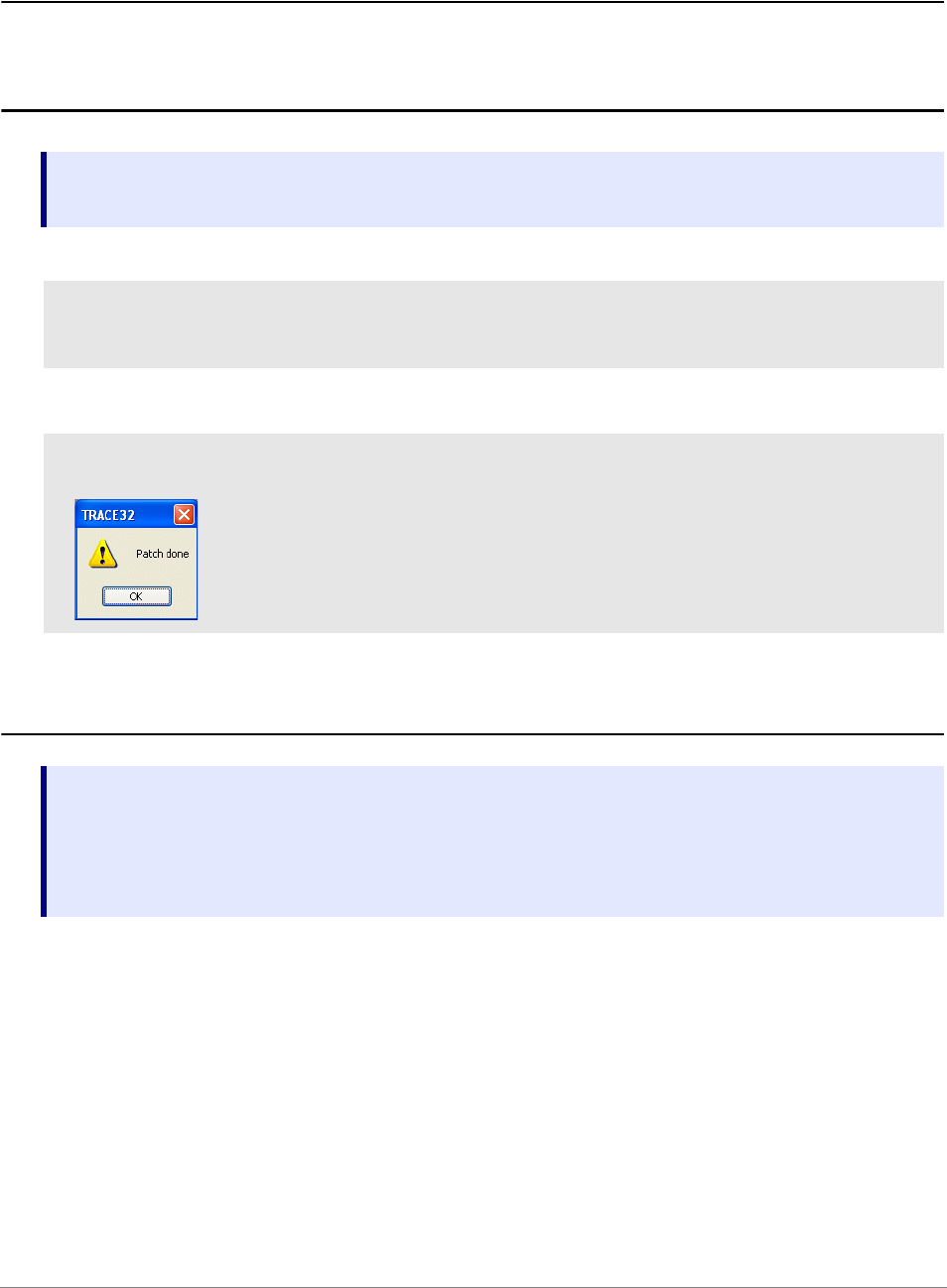
Training Script Language PRACTICE | 92
©
1989-2024 Lauterbach
I/O Commands
Output Command
Input Command
PRINT <format> <parlist>
DIALOG.OK <message>
PRINT "FLASH programmed successfully"
PRINT %ERROR "FLASH programming failed"
DIALOG.OK "Patch done"
ENTER <parlist> Window based input
INKEY [<par>] Input command (character)
DIALOG.YESNO <message> Create a standard dialog
DIALOG.File <message> Read a file name via a dialog
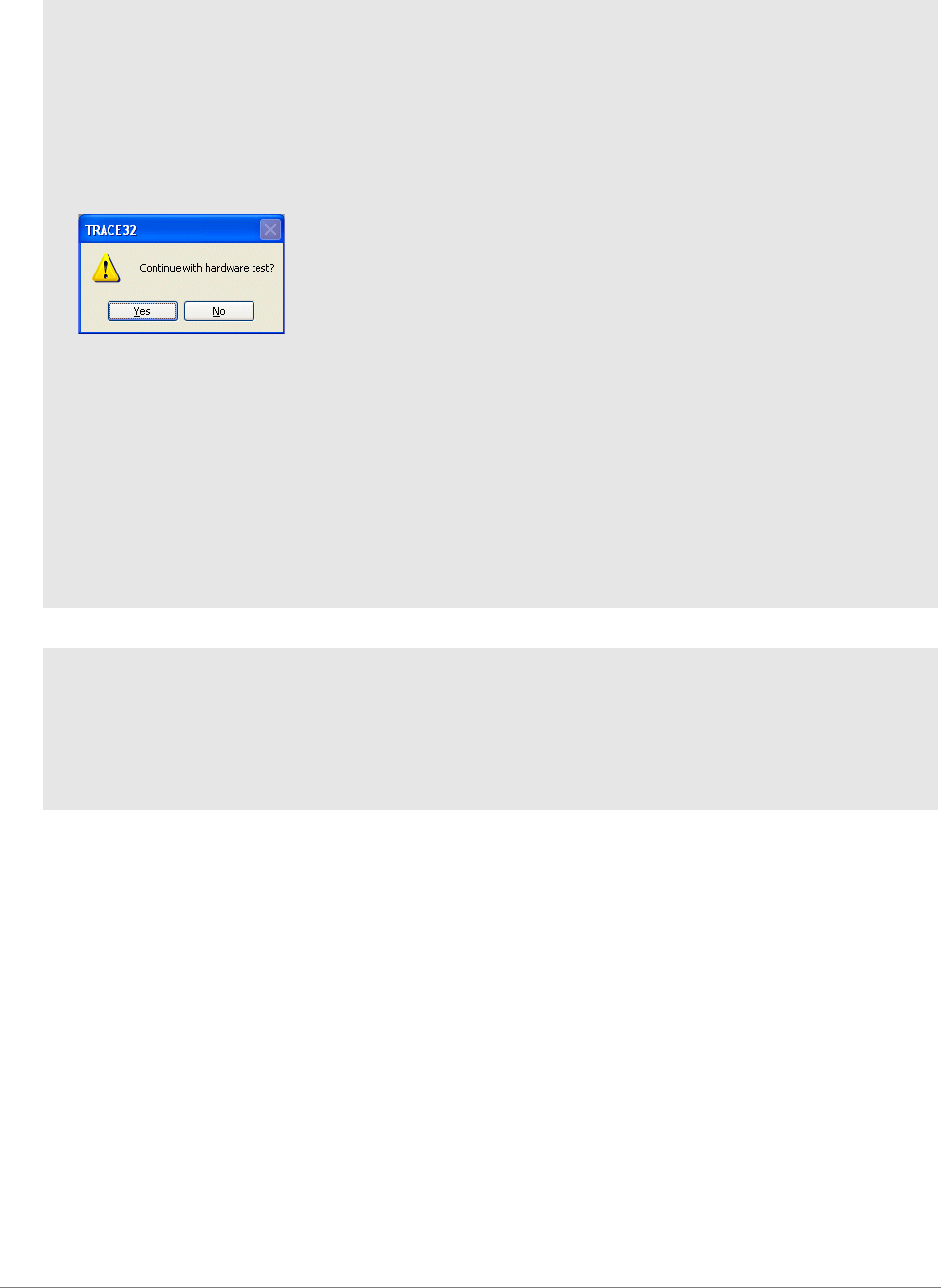
Training Script Language PRACTICE | 93
©
1989-2024 Lauterbach
INKEY ; Wait for any key
INKEY &key ; Wait for any key, key
; code is assigned to
&key
; PRACTICE script dialog.cmm
DIALOG.YESNO "Continue with hardware test?"
ENTRY &result
IF &result
(
PRINT "Test started"
DO test2
)
ELSE
PRINT "Test aborted"
ENDDO
DIALOG.File *sre
ENTRY &filename
Data.LOAD.S3record &filename
ENDDO
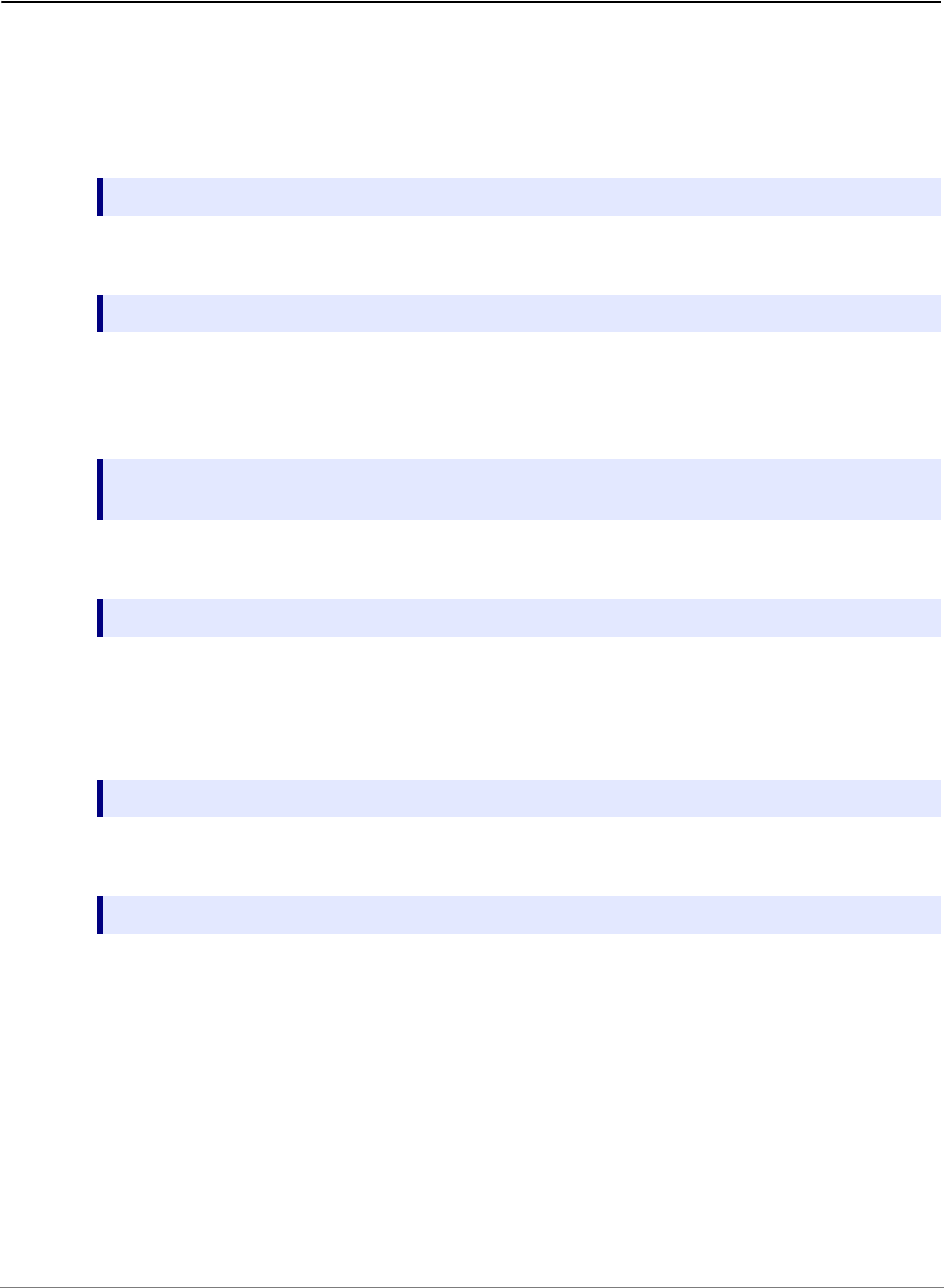
Training Script Language PRACTICE | 94
©
1989-2024 Lauterbach
I/O via the AREA Window
An I/O window is needed for PRACTICE inputs and outputs. This is handled by an AREA window.
To open and assign an AREA window:
1. Create an AREA window
2. Select an AREA window for PRACTICE I/O.
3. Select the screen position of the AREA window. This command is used here, because it allows
you to assign a name to an AREA window. This is useful, if you want to delete this window after
the I/O procedure.
4. Display AREA window
To remove AREA window:
1. Resets the AREA window settings to the default settings: the message area (AREA A000) is
used for error and system messages. No other AREA window is active.
2. Delete a specific window.
AREA.Create [<area> ]
AREA.Select [<area>]
WinPOS [<pos>] [<size>] [<scale>] [<window_name>] [<state>]
[<header>]
AREA.view [<area>]
AREA.RESet
WinCLEAR [<pagename> | <windowname> | TOP]

Training Script Language PRACTICE | 95
©
1989-2024 Lauterbach
; PRACTICE file iowindow.cmm
AREA.Create IO-AREA
AREA.Select IO-AREA
WinPOS ,,,,,, IO1
AREA.view IO-AREA
PRINT "Please enter the address"
PRINT "Address="
ENTER &a
PRINT " "
PRINT "Entered address=" &a
WAIT 2.s
AREA.RESet
WinCLEAR IO1
ENDDO
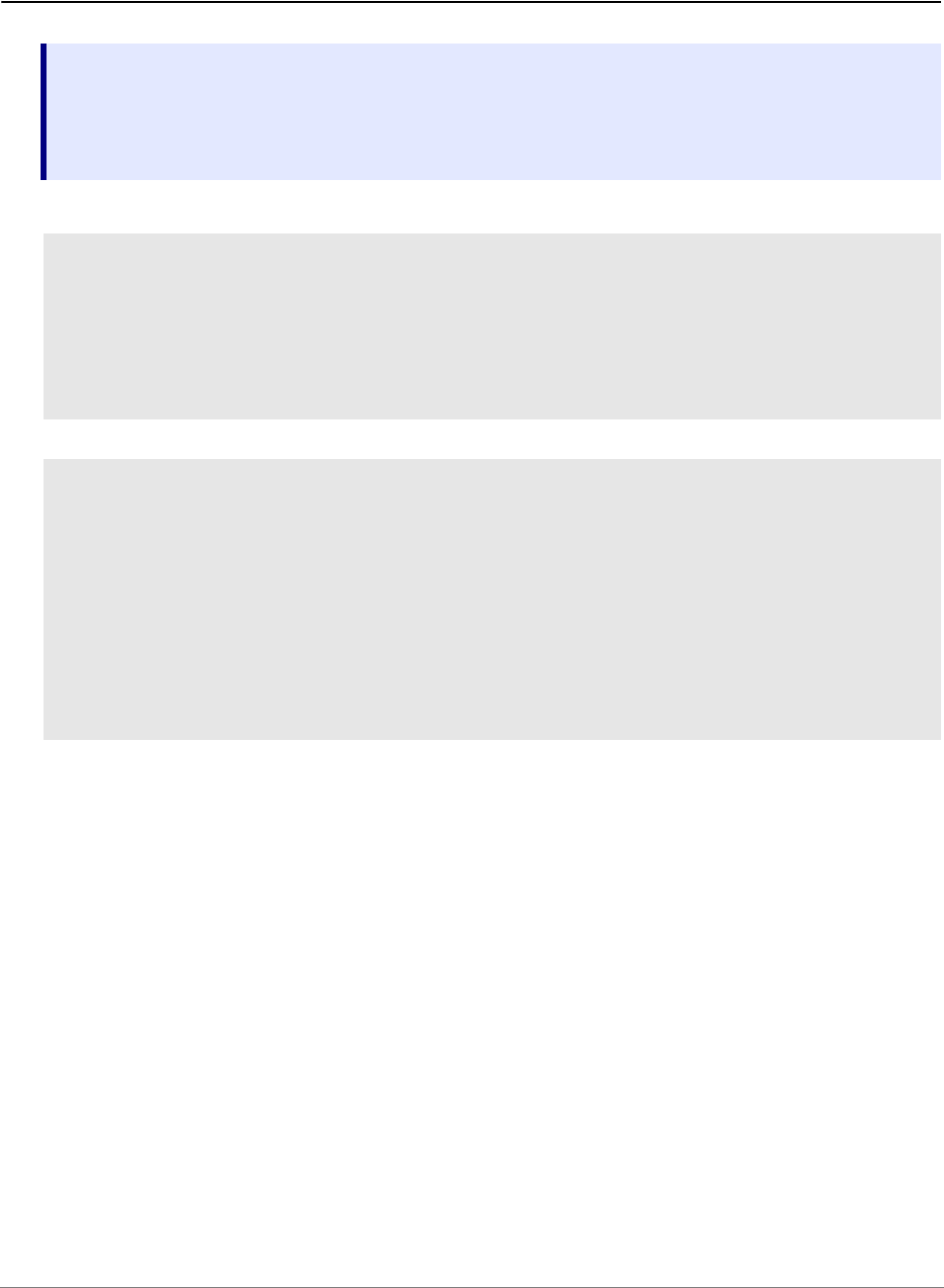
Training Script Language PRACTICE | 96
©
1989-2024 Lauterbach
Event Control via PRACTICE
ON ERROR <command> Perform commands on PRACTICE runtime error
ON SYSUP <command> Perform commands when the communication between debugger
and CPU is established
ON POWERUP <command> Perform commands on target power on
…
ON ERROR GOTO
(
DIALOG.OK "Abortion by error!"
ENDDO (0!=0)
)
…
ON POWERUP GOTO startup
IF !(STATE.POWER())
STOP
startup:
SYStem.CPU TC1796
WAIT 0.5s
SYStem.UP
ENDDO
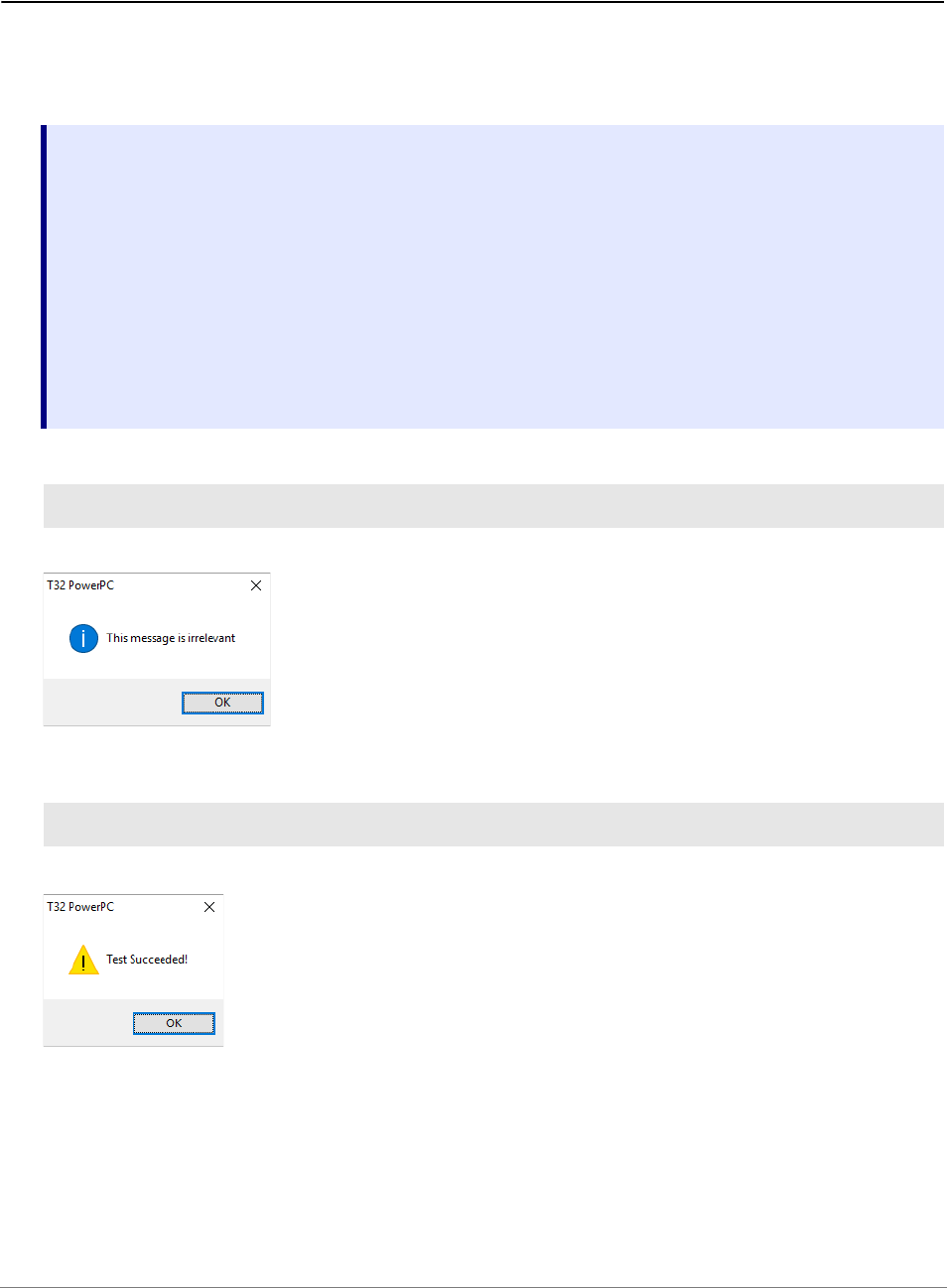
Training Script Language PRACTICE | 97
©
1989-2024 Lauterbach
Simple Dialogs
TRACE32 provides a number of simple dialogs which can be used to inform the user of something or to
prompt them to make a simple choice.
DIALOG.MESSAGE "<text>" Creates a standard dialog box with an information icon
and the user text displayed. The dialog closes when the
user clicks the OK button.
DIALOG.OK "<text>" Creates a standard dialog box with an exclamation icon
and the user provided text. The dialog closes when the
user clicks the OK button.
DIALOG.YESNO "<text>" Creates a standard dialog box with a question mark
icon and the user provided text. The user is presented
with two buttons. Clicking YES returns a TRUE value to
the script whilst clicking NO returns a FALSE value to
the script. Either button will close the dialog.
DIALOG.MESSAGE "This message is irrelevant"
DIALOG.OK "Test Succeeded!"
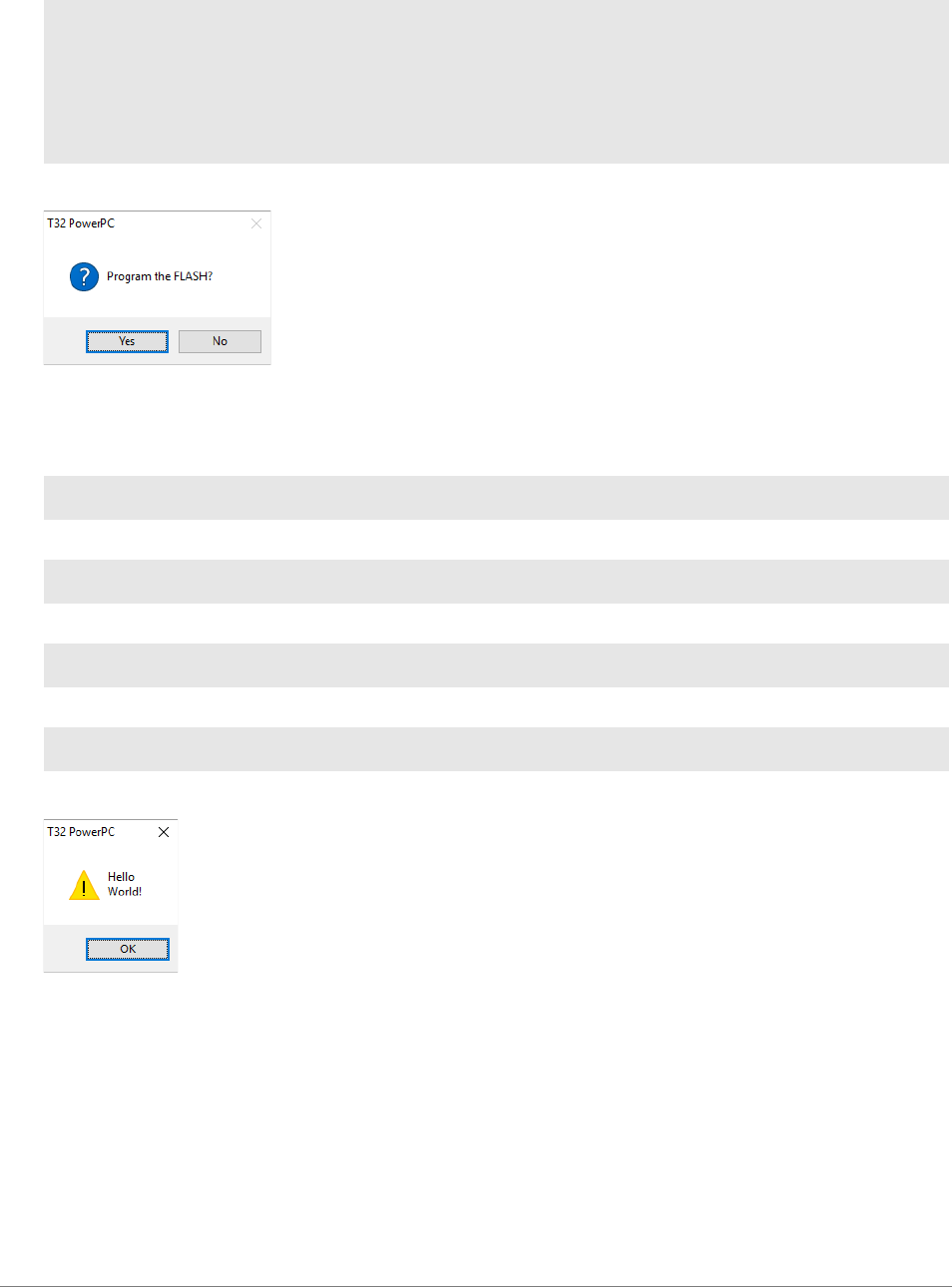
Training Script Language PRACTICE | 98
©
1989-2024 Lauterbach
Text can be split across multiple lines in these simple dialogs. The list below shows the methods of achieving
this.
Three of these use the CONVert.CHAR() function to insert carriage return (0x0D, '\r') and/or line feed
(0x0A, '\n') characters into the string. The fourth version simply presents two strings and TRACE32 will
put one per line.
LOCAL &result
DIALOG.YESNO "Program the FLASH?"
ENTRY &result
if &result
GOSUB prog_flash
ENDDO
DIALOG.OK "Hello"+CONVert.CHAR(0x0D)+"World!"
DIALOG.OK "Hello"+CONVert.CHAR(0x0A)+"World!"
DIALOG.OK "Hello"+CONVert.CHAR(0x0A0D)+"World!"
DIALOG.OK "Hello" "World"
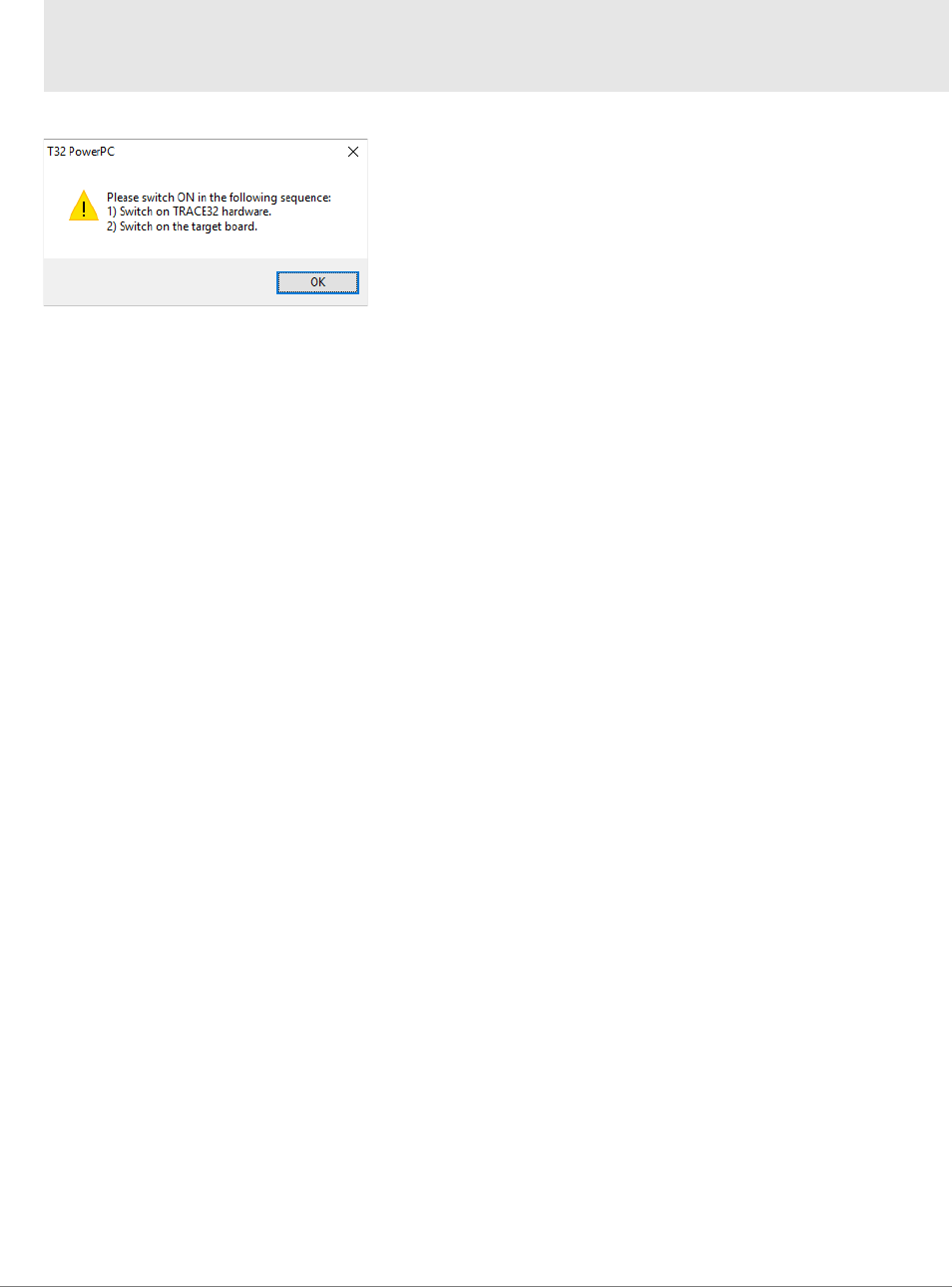
Training Script Language PRACTICE | 99
©
1989-2024 Lauterbach
Using the technique for splitting PRACTICE lines can help break up dialogs into something more readable.
DIALOG.OK "Please switch ON in the following sequence:" \
"1) Switch on TRACE32 hardware," \
"2) Switch on the target board."
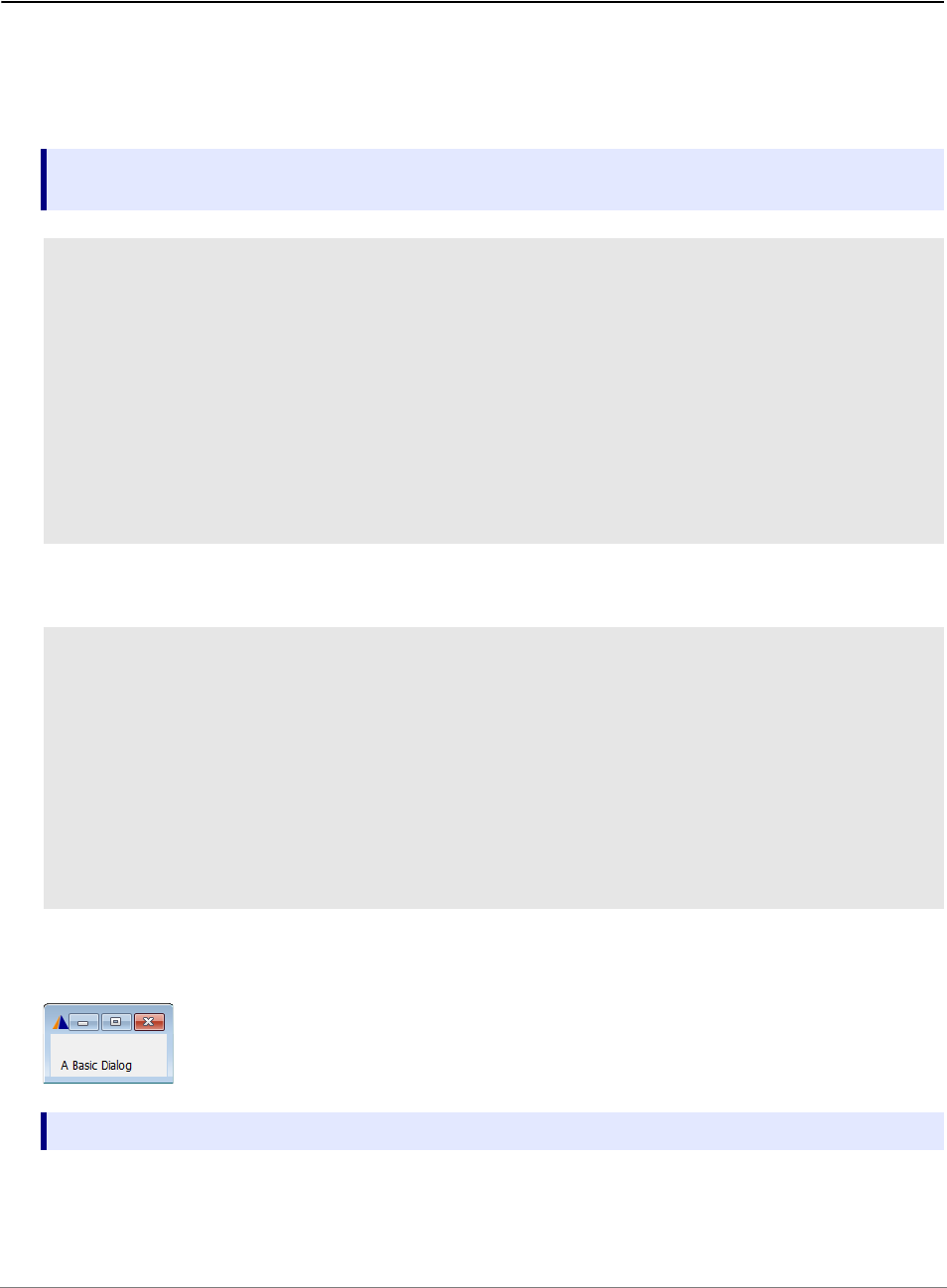
Training Script Language PRACTICE | 100
©
1989-2024 Lauterbach
Dialog Programming
Complex dialogs can be created in PRACTICE scripts. These allow users to develop custom interfaces for
their scripts. Dialogs can be created in one of two ways. The first requires putting the dialog code into a
separate file with a .dlg extension and calling it with the DIALOG.view command.
The second method includes the dialog code within the script itself.
Both examples produce the same result. Dialogs automatically size themselves to encompass all of the
controls placed within it.
DIALOG.view <filename> Creates a dialog based upon the code in the dialog file,
<filename>.
; File basicdialog.dlg
POS 1. 1. 10.
TEXT "A Basic Dialog"
; File dialogscript.cmm
DIALOG.view basicdialog.dlg
SCREEN.WAIT //update screen
WAIT 3.s
DIALOG.END
ENDDO
; Example code to create a simple dialog
DIALOG.view
(
POS 1. 1. 10.
TEXT "A Basic Dialog"
)
SCREEN.WAIT //update screen
WAIT 3.s
DIALOG.END
ENDDO
DIALOG.END Closes the currently active dialog window.
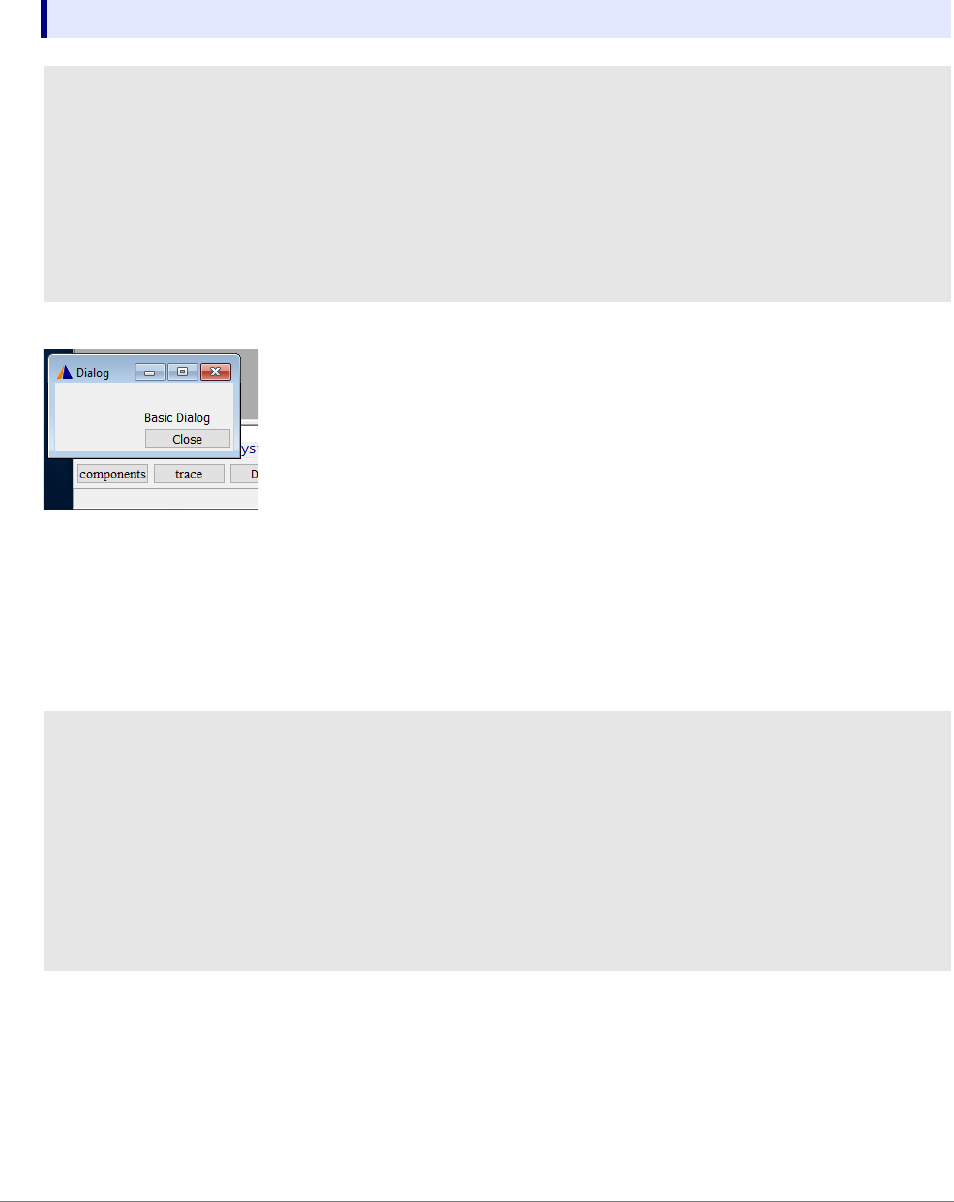
Training Script Language PRACTICE | 101
©
1989-2024 Lauterbach
By default dialog windows are contained within the parent window of TRACE32 unless you have specified a
non-MDI style interface. Dialogs can be created as free-floating windows by using the WinExt command.
By using the PRACTICE command STOP in this example, the dialog becomes modal. The script will
wait until the user (or the script) continues execution. This CONTinue comes when the command
associated with the BUTTON control is executed. This is activated when the user clicks the button.
Adding the prefix WinResist will cause the dialog to remain displayed after a call to WinCLEAR.
Multiple command prefixes can be applied to each dialog.
WinExt.<command> Pre-command for creating an external window.
; Example of non-MDI dialog
WinExt.DIALOG
(
TEXT "Hello"
BUTTON "Close" "CONTINUE"
)
STOP
DIALOG.END
ENDDO
; Example of non-MDI dialog which will persist through a WinCLEAR
; operation.
WinResist.WinExt.DIALOG
(
TEXT "Hello"
BUTTON "Close" "CONTinue"
)
STOP
DIALOG.END
ENDDO
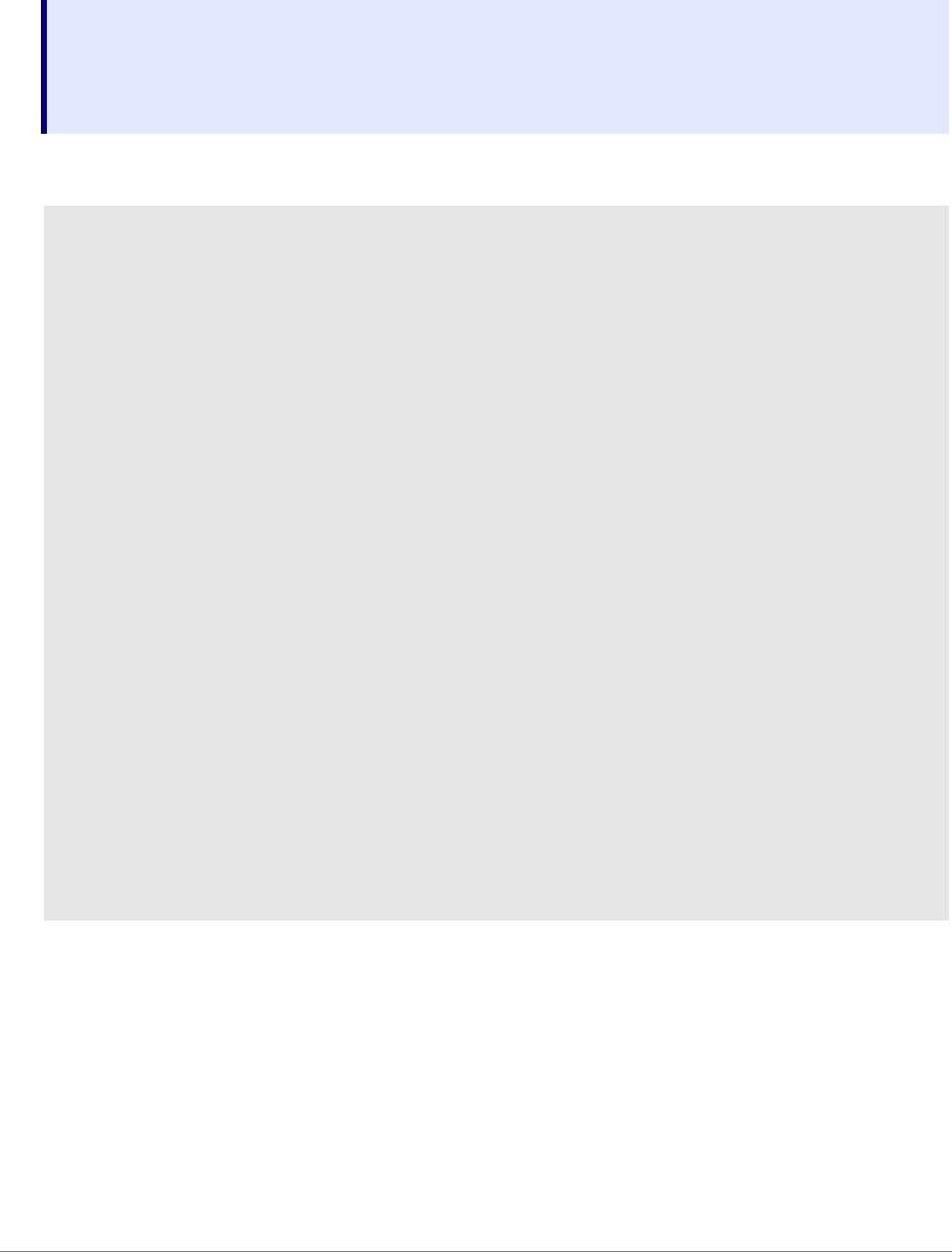
Training Script Language PRACTICE | 102
©
1989-2024 Lauterbach
A dialog can be resized using the WinRESIZE command. This can be performed dynamically and allows for
hidden options.
WinRESIZE [<width>] [<height>] [<windowname>] Resizes the open window that has the
name <windowname>. If no name is
specified, the top most window is resized.
A <windowname> can be created with the
WinPOS or NAME commands.
WinExt.DIALOG
(
HEADER "Hidden Option"
POS 0. 0. 20. 4.
BOX ""
POS 1. 1. 15. 1.
TEXT "Please select an option"
POS 1. 2. 8. 1.
A.A: CHOOSEBOX "Option A" ""
POS 9. 2. 8. 1.
A.B: CHOOSEBOX "Option B" ""
POS 22. 2. 8. 1.
A.C: CHOOSEBOX "Option C" ""
POS 5. 4. 7. 1.
BUTTON "Options>>"
(
WinRESIZE 32. 5.
)
POS 22. 4. 8. 1.
BUTTON "<<Options"
(
WinRESIZE 20. 5.
)
)
;Set dialog’s initial size
WinRESIZE 20. 5.
STOP
DIALOG.END
ENDDO
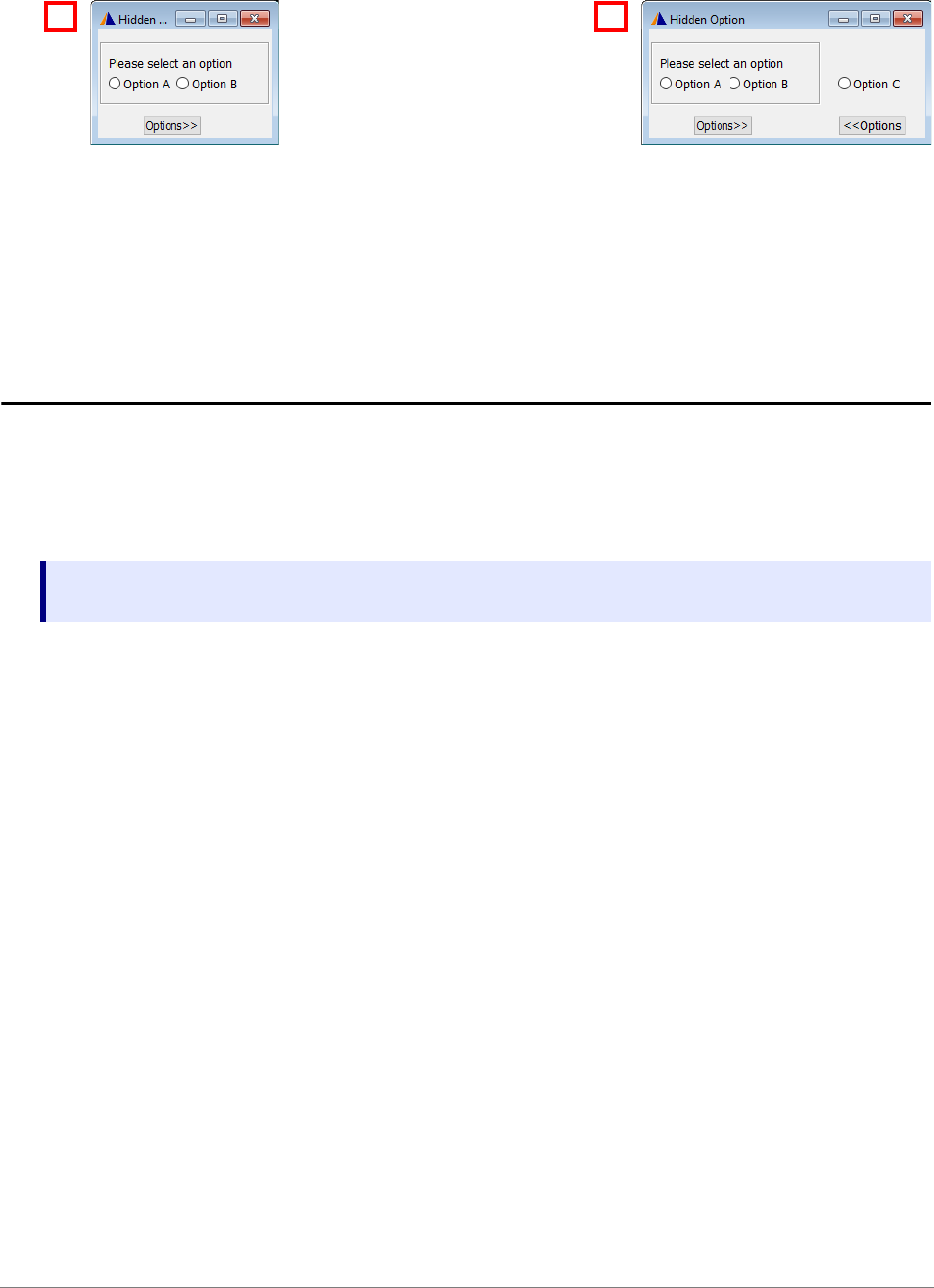
Training Script Language PRACTICE | 103
©
1989-2024 Lauterbach
Control Positioning
Control placement starts at (0, 0) which is the top left of the dialog. The default size is 9 units wide and 1 unit
high. After a control is placed the next position is calculated by advancing the Y co-ordinate by one and
keeping the same X co-ordinate. The size defaults to the same size as the last placed control. To override
the size and position of the next control to be placed, use the POS command.
The examples above have a period "." after the numbers in the arguments to POS. This instructs TRACE32
to treat these as decimal numbers.
A Click "Options>>" to expand the dialog
B Dialog shown expanded. Click "<<Options" to shrink the dialog.
POS [<x>] [<y>] [<width>] [<height>] Defines the size and position of the next control to be
placed on a dialog window.
<x> 0 - 16383.5 units. Can be specified in 0.5 unit increments.
<y> 0 - 8191.75 units. Can be specified in 0.25 unit increments.
<width> 0 - 16383.5 units. Can be specified in 0.5 unit increments.
<height> 0 - 8191.75 units. Can be specified in 0.25 unit increments.
, The value of the previous POS argument is used. In the example here
the previous value for the <width> is preserved.
; <x> <y> <width> <height>
POS 3. 7. , 2.
<no_argument> The value of the previous POS argument is used, starting from right to
left. In the example below, the values for <width> and <height> will be
taken from the previous POS command.
; <x> <y> <width> <height>
POS 3. 7.
BA
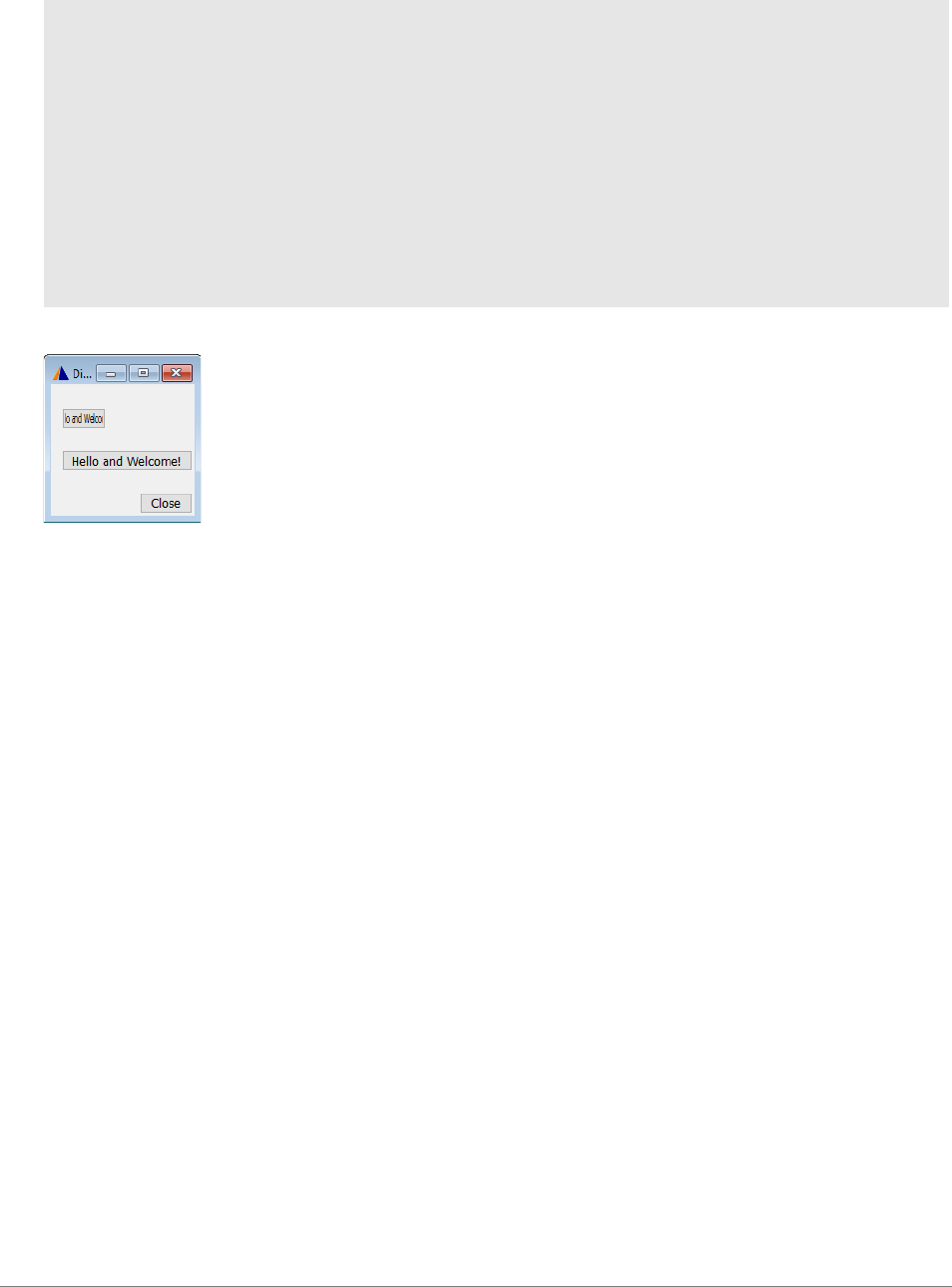
Training Script Language PRACTICE | 104
©
1989-2024 Lauterbach
Controls with text in them will attempt to fit the text to the size of the control.
DIALOG.view
(
POS 1. 1. 5. 1.
BUTTON "Hello and Welcome!" ""
POS 1. 3. 15. 1.
BUTTON "Hello and Welcome!" ""
POS 10. 5. 6. 1.
BUTTON "Close" "CONTinue"
)
STOP
DIALOG.END
ENDDO

Training Script Language PRACTICE | 105
©
1989-2024 Lauterbach
Control Properties
Some dialog controls must be associated with a PRACTICE label. This provides some extra capabilities:
• PRACTICE script can enable or disable the control.
• The PRACTICE script can extract user input or control state information via the label.
• The PRACTICE script can set a value into the control by using the label.
• The PRACTICE script can set the control’s state.
• If a control has a command block associated with it, this can be executed.
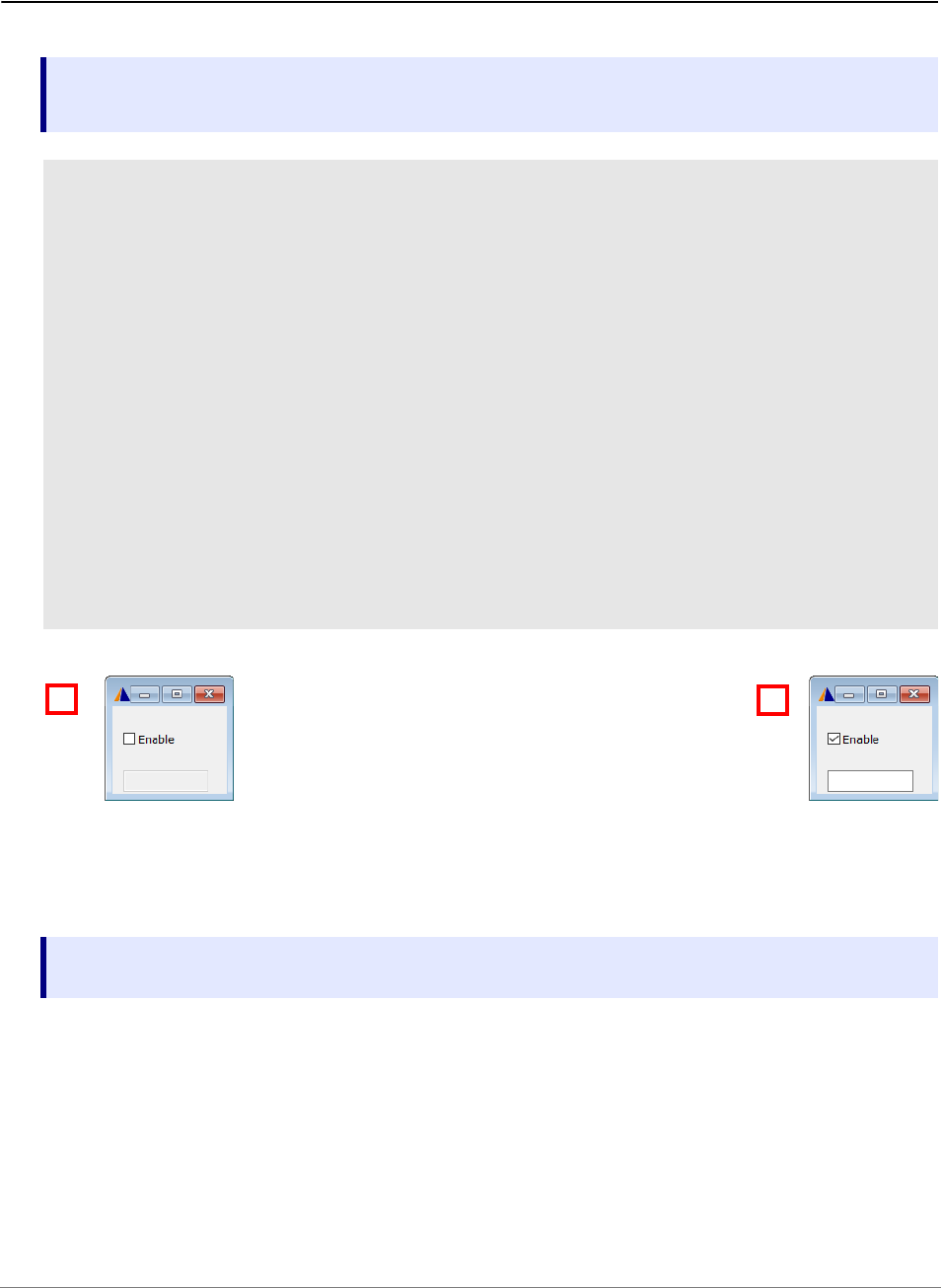
Training Script Language PRACTICE | 106
©
1989-2024 Lauterbach
Enable or Disable a Control
DIALOG.Enable <label> Enable the control which is associated with <label>.
DIALOG.Disable <label> Disable the control which is associated with <label>.
DIALOG
(
POS 1. 1. 10. 1.
CB1: CHECKBOX "Enable"
(
IF DIALOG.BOOLEAN(CB1)
DIALOG.Enable T1
ELSE
DIALOG.Disable T1
)
POS 1. 2. 10. 1.
T1: EDIT "" ""
)
;Set starting state for controls after the DIALOG command but before
;the STOP.
DIALOG.DISABLE T1
STOP
ENDDO
A When the dialog opens the CHECKBOX is enabled and the EDIT control is not.
B Clicking the CHECKBOX will enable the EDIT control.
DIALOG.BOOLEAN(<label>) Returns the boolean value of the dialog control
associated with <label>.
A
B

Training Script Language PRACTICE | 107
©
1989-2024 Lauterbach
Collect data from a control
Information from a control is made available to the PRACTICE script through the label associated with that
control. The method of extraction is to use the DIALOG.STRing() function.
DIALOG.STRing(<label>) Returns the data from the dialog control associated
with <label>.
DIALOG.STRing2(<label>) Retrieves the complete list of values from a list dialog
control: LISTBOX, MLISTBOX, DLISTBOX,
COMBOBOX, etc. Returned values are in
comma-separated string.
LOCAL &userInput
DIALOG.view
(
POS 1. 1. 10. 1.
TXT: EDIT "" ""
POS 1. 2. 10. 1.
BUTTON "OK" "CONTinue"
)
STOP
&userInput=DIALOG.STRing(TXT)
AREA.view
PRINT "User entered: &userInput"
ENDDO

Training Script Language PRACTICE | 108
©
1989-2024 Lauterbach
LOCAL &toppings &ordered
DIALOG.view
(&
HEADER "Dialog.string2() Example"
POS 1. 1. 15. 10.
BOX "Select Toppings"
POS 2. 2. 13. 1.
CB1: CHECKBOX "Ham"
(
GOSUB check_item "Ham"
)
CB2: CHECKBOX "Pepperoni"
(
GOSUB check_item "Pepperoni"
)
CB3: CHECKBOX "Olives"
(
GOSUB check_item "Olives"
)
CB4: CHECKBOX "Mushrooms"
(
GOSUB check_item "Mushrooms"
)
CB5: CHECKBOX "Pineapple"
(
GOSUB check_item "Pineapple"
)
CB6: CHECKBOX "Onion"
(
GOSUB check_item "Onion"
)
CB7: CHECKBOX "Sweetcorn"
(
GOSUB check_item "Sweetcorn"
)
CB8: CHECKBOX "Jalapenos"
(
GOSUB check_item "Jalapenos"
)
POS 18. 1.5 13. 9.
TOP: MLISTBOX "" ""
POS 26. 12. 8. 1.
DEFBUTTON "Order" "CONTinue"
)
STOP
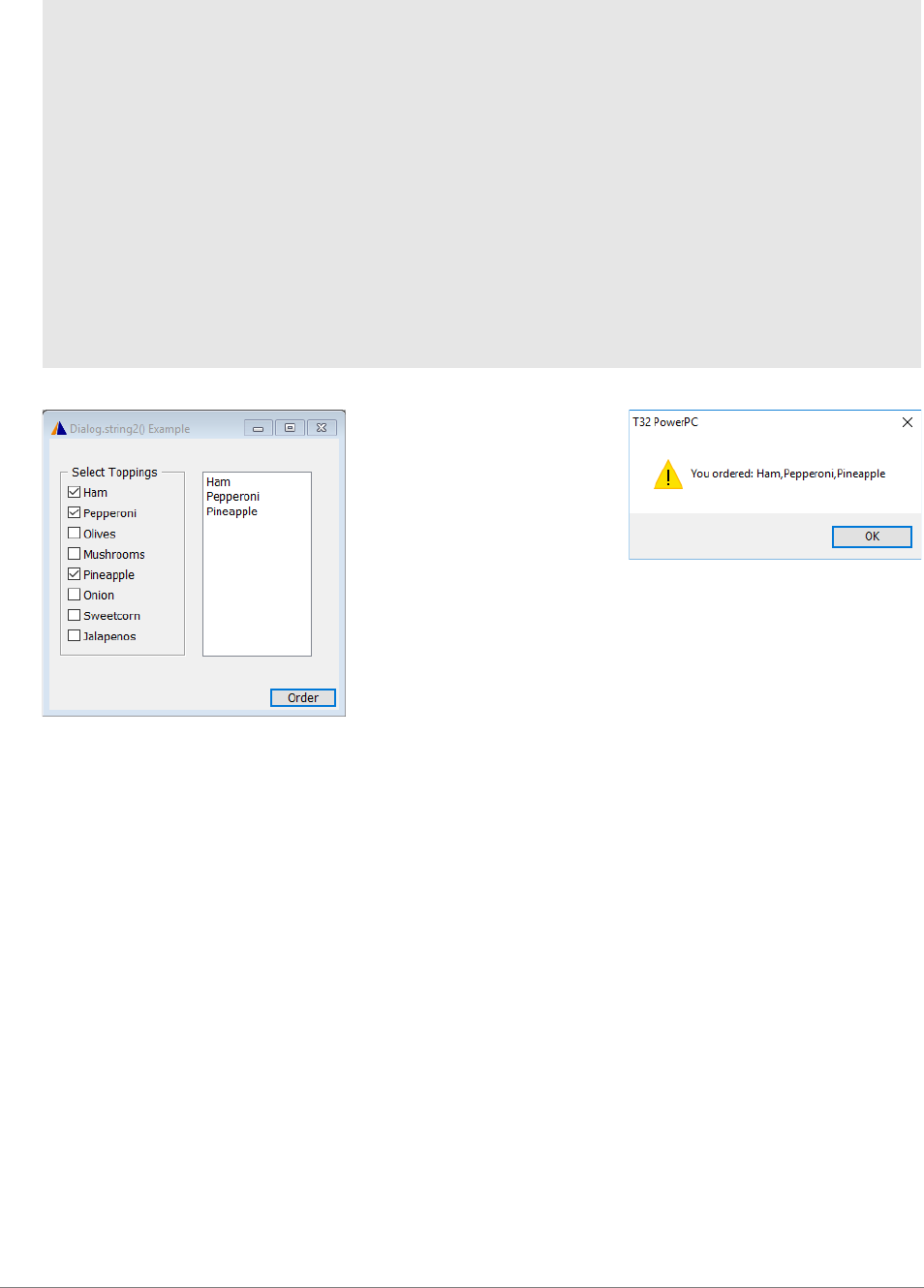
Training Script Language PRACTICE | 109
©
1989-2024 Lauterbach
&ordered=DIALOG.STRing2(TOP)
DIALOG.OK "You ordered: &ordered"
DIALOG.END
ENDDO
check_item:
ENTRY &newitem
&newitem=&newitem ;Remove any extra quotes
IF "&toppings"=="" ;Is this the first item to be added to the list
&toppings="&newitem"
ELSE
&toppings="&toppings"+","+"&newitem"
DIALOG.Set TOP "" "&toppings"
RETURN

Training Script Language PRACTICE | 110
©
1989-2024 Lauterbach
Setting a value or state to a control
Controls that can be associated with a label can be set or have data entered into them using the
DIALOG.Set command.
DIALOG.Set <label> <value> Set the <value> to the control associated with <label>.
DIALOG.view
(
POS 1. 1. 5. 1.
T1: DYNTEXT "Hello"
POS 1. 2. 15. 1.
C1: CHECKBOX "Checkbox" ""
POS 10. 5. 6. 1.
BUTTON "Toggle"
(
IF DIALOG.BOOLEAN(C1)
(
DIALOG.Set T1 "Hello"
DIALOG.Set C1 FALSE()
)
ELSE
(
DIALOG.Set T1 "World"
DIALOG.Set C1 TRUE()
)
)
)
DIALOG.Disable C1
STOP
DIALOG.END
ENDDO
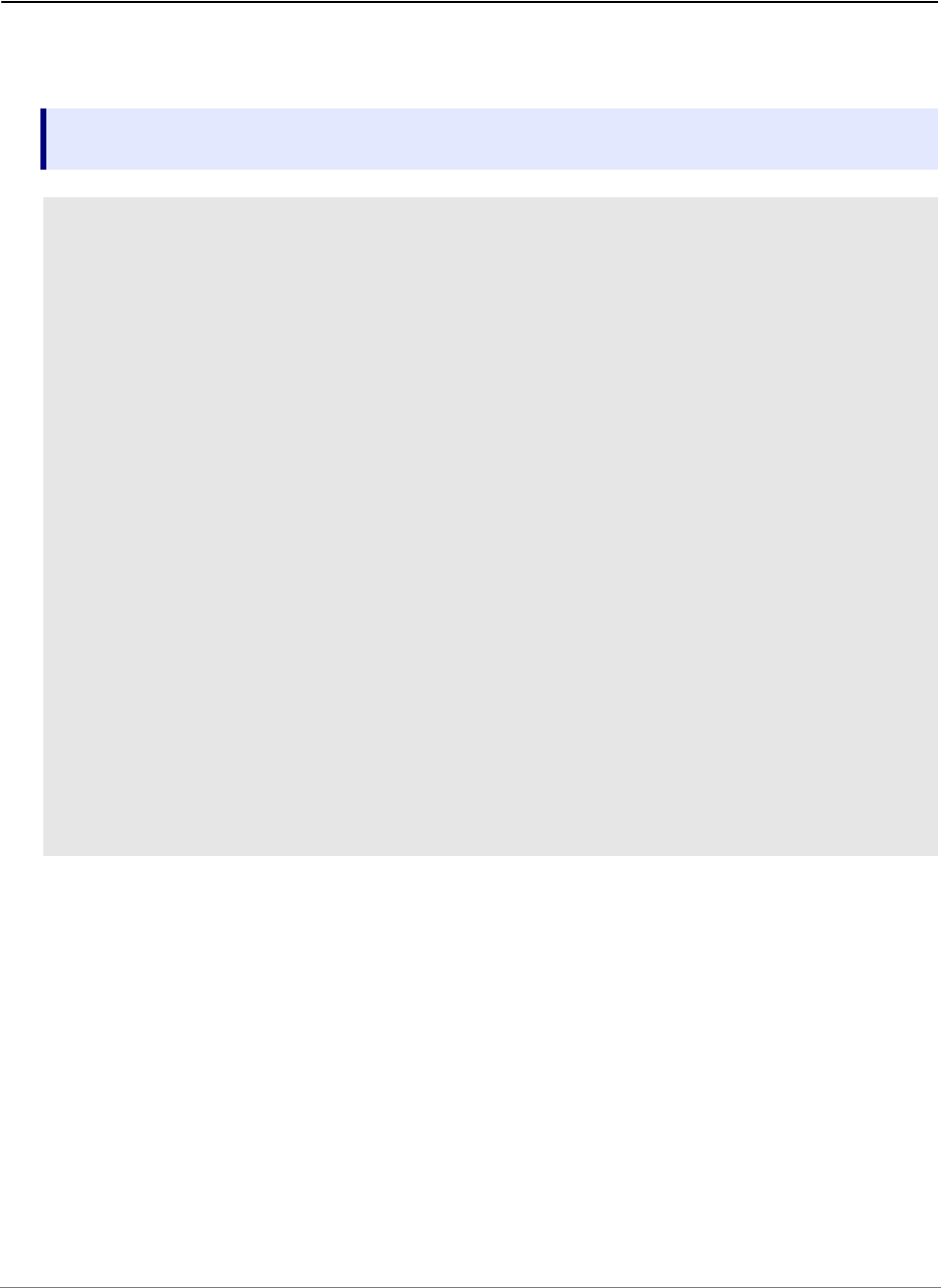
Training Script Language PRACTICE | 111
©
1989-2024 Lauterbach
Execute a command
It is possible to execute the command or block associated with any other control. This is done using the
DIALOG.EXecute command.
DIALOG.EXecute <label> Execute the command of the control which is
associated with <label>.
DIALOG.view
(
POS 1. 1. 10. 1.
T1: DYNTEXT "Placeholder"
POS 1. 2. 10. 1.
T2: DYNTEXT "Placeholder"
POS 15. 1. 9. 1.
B1: BUTTON "Set Text 1"
(
DIALOG.Set T1 "Hello"
)
POS 15. 3. 9. 1.
B2: BUTTON "Set Text 2"
(
DIALOG.Set T2 "World"
)
POS 15. 5. 9. 1.
B3: BUTTON "Set both"
(
DIALOG.EXecute B1
DIALOG.EXecute B2
)
)
STOP
DIALOG.END
ENDDO
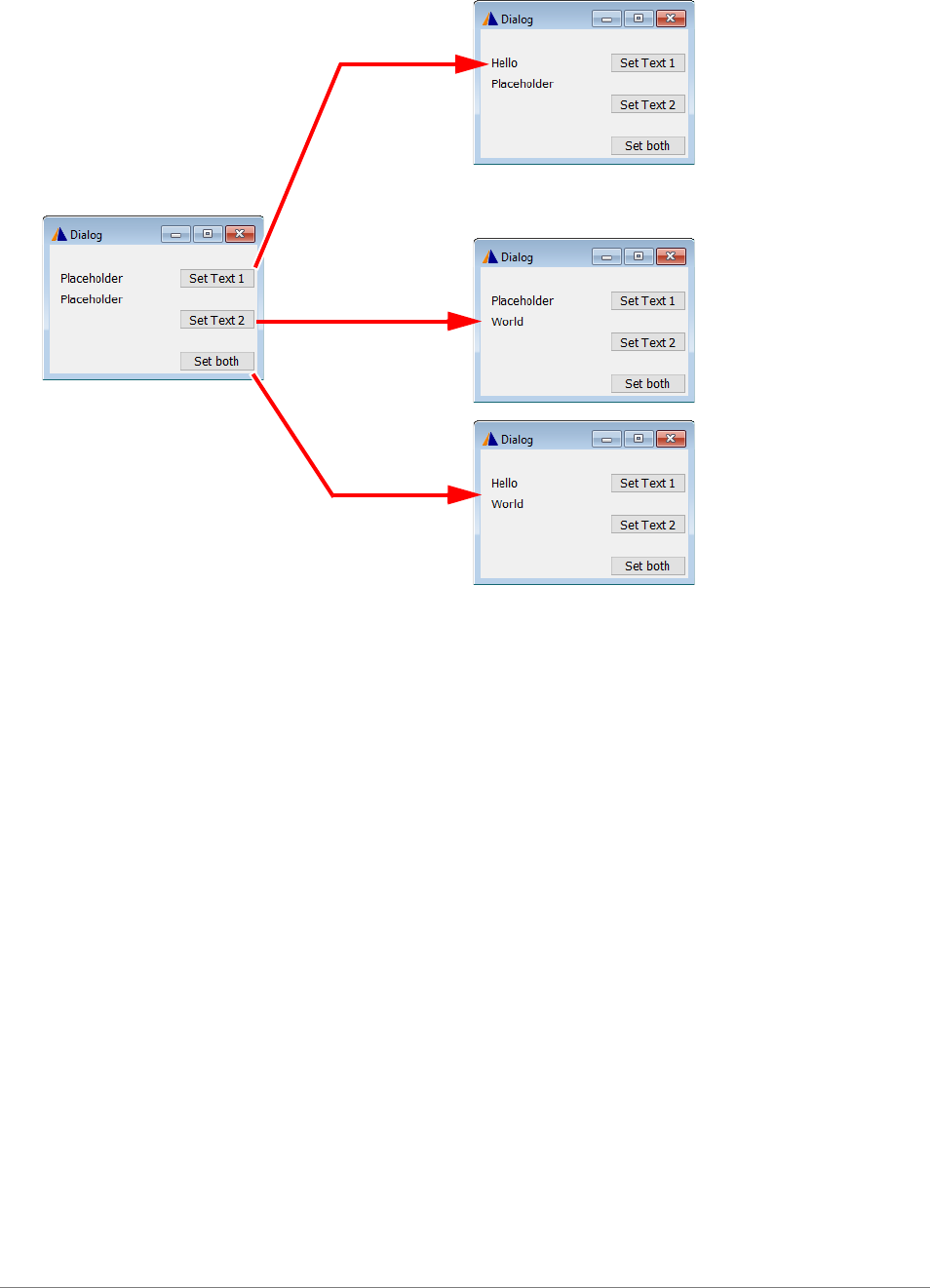
Training Script Language PRACTICE | 112
©
1989-2024 Lauterbach
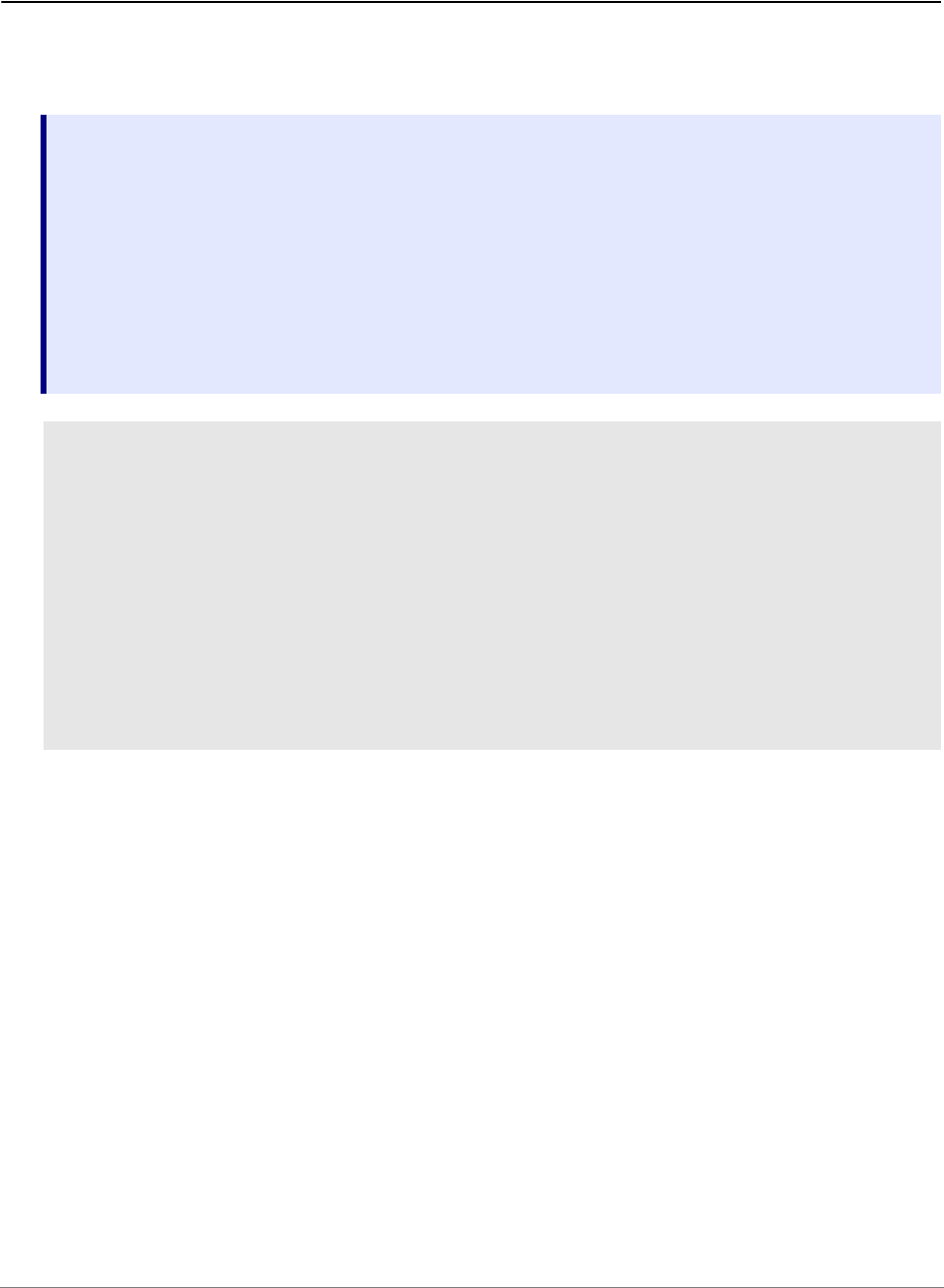
Training Script Language PRACTICE | 113
©
1989-2024 Lauterbach
File Browsing
PRACTICE provides several commands for file and directory browsing. There are two broad categories:
those that return a value like a subroutine and those that can set the returned value to a label.
The above example also uses the OS.FILE.NAME() and OS.FILE.PATH() functions to extract the file name
and file path respectively.
DIALOG.DIR <directory_name> Creates a dialog box to choose a directory name.
<directory_name> must contain wildcard characters.
DIALOG.File <file> Creates a file chooser dialog box. <file> must contain
wildcard characters. The file must exist and the user
must have read access to the file. The file name
returned contains the full path.
DIALOG.File.SAVE <file> Creates a file chooser dialog box. <file> must contain
wildcard characters. The file need not exist but the user
must have permissions to create the file in the selected
directory. The file name returned contains the full path.
LOCAL &filename
DIALOG.File.open *.cmm
ENTRY %LINE &filename ;Use ENTRY to obtain result from
;DIALOG.FILE. Added %LINE option in
;case the file name had spaces in it.
PRINT "&filename selected."
;To extract just the file name
PRINT "File name is "+OS.FILE.NAME(&filename)
;To extract the path information
PRINT "Path details are "+OS.FILE.PATH(&filename)
ENDDO
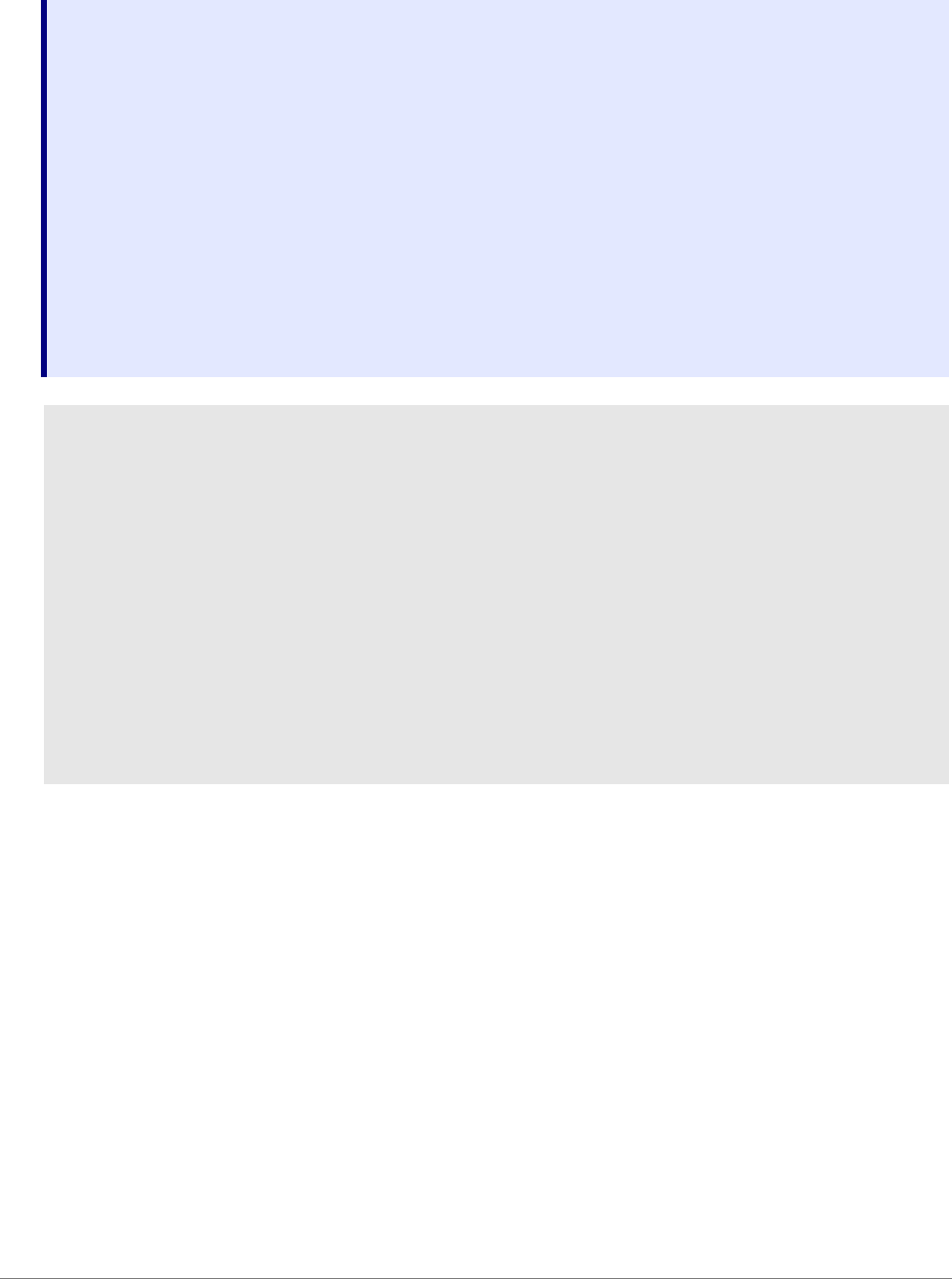
Training Script Language PRACTICE | 114
©
1989-2024 Lauterbach
The DIALOG.SetFile command has been attached to the BUTTON. Commands can be attached to some
controls. If the command is a single line it can be enclosed in quotes ("). If the command is more complex it
can be a PRACTICE block (enclosed in parentheses).
DIALOG.SetDIR <label> <dir_path> Creates a dialog box to choose a directory name.
<dir_path> must contain wildcard characters.
The result is placed into the <label>.
DIALOG.SetFile <label> <file_name> Creates a file chooser dialog box. <file_name>
must contain wildcard characters. The file must
exist and the user must have read access to the
file. The result will be placed into the EDIT control
associated with <label>.
DIALOG.SetFile.SAVE <label> <file_name> Creates a file chooser dialog box. <file_name>
must contain wildcard characters. The file need
not exist but the user must have permissions to
create the file in the selected directory. The result
will be placed into the EDIT control associated
with <label>.
LOCAL &fname
DIALOG.view
(
POS 1. 1. 25. 1.
FILE: EDIT "" ""
POS 30. 1. 5. 1.
B: BUTTON "..." "DIALOG.SetFile FILE *"
POS 30. 3. 5. 1
BUTTON "OK" "CONTinue"
)
STOP
&fname=DIALOG.STRing(FILE)
DIALOG.END
PRINT "File - &fname"
ENDDO
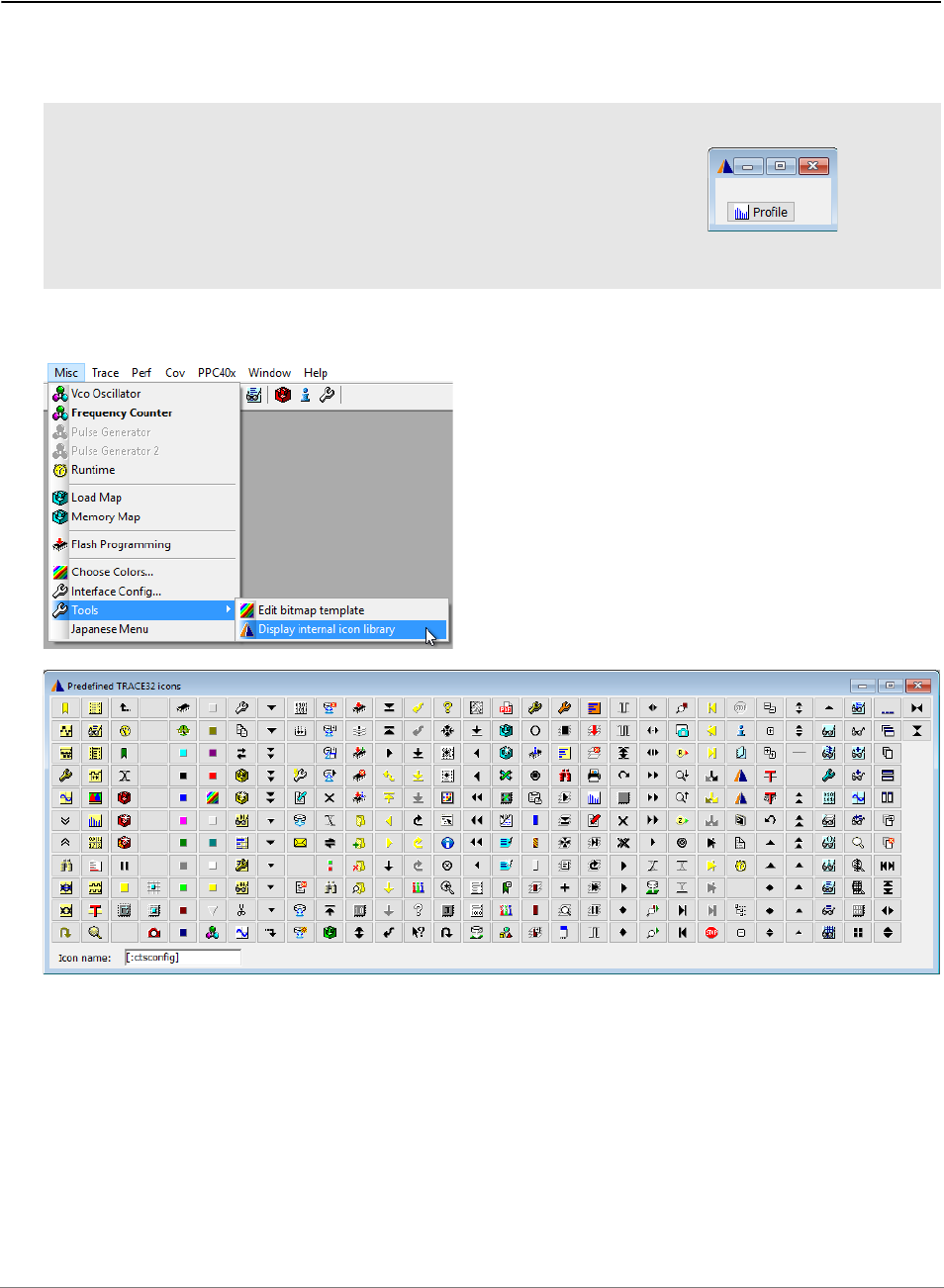
Training Script Language PRACTICE | 115
©
1989-2024 Lauterbach
Icons
TRACE32 has a number of built-in icons which can be used in dialog or menu programming. These are
added by using the syntax [:<icon_name>] in the text part of a control.
A list of internal icons can be displayed. Select the icon and the name is displayed.
DIALOG.view
(
POS 1. 1. 8. 1.
BUTTON "[:profile]Profile" ""
)
STOP
ENDDO

Training Script Language PRACTICE | 116
©
1989-2024 Lauterbach
Dialog Example
A complete list of dialog controls can be found in “PowerView Command Reference” (ide_ref.pdf). In this
section we will examine a few of them in the context of a complex example. The full version of this script can
be found in ~~/demo/practice/dialogs/dialog_example_generic.cmm
First, declare some local macros to be used in the script. Some of them are given default values. Some lines
have been split using the "\" character to make the script more readable here. Some assignments, like
&instr are made using multiple assignments to build up a longer value.
Display the dialog. The characters "&+" after the opening parenthesis allow for runtime macro substitution
into the dialog controls. The code below will create a header and add a text line and edit field to the dialog.
The next few lines add a box and a group of radio buttons (CHOOSEBOXes) into the box pane. Each
CHOOSEBOX is part of the same group. The label name takes the form <group>.<member> and TRACE32
ensures that only one member of each group can be selected at any one time. Each CHOOSEBOX has a
command associated with it which will be executed when the user selects that control.
LOCAL &bond &batman &captain &bondsel &captainsel &batmansel &expand \
&progress &instr &myname
&bond="Sean Connery,George Lazenby,Roger Moore,Timothy Dalton,"
&bond="&bond"+"Pierce Brosnan,Daniel Craig"
&batman="Adam West,Michael Keaton,Val Kilmer,George Clooney,"
&batman="&batman"+"Christian Bale,Ben Affleck"
&captain="Jonathon Archer,James Kirk,Jean-Luc Picard,"
&captain="&captain"+"Benjamin Sisko,Katherine Janeway"
&expand=0.
&progress=0.
&instr="Instructions for USE"+CONVert.CHAR(10.)
&instr="&instr"+"============="+CONVert.CHAR(10.)
&instr="&instr"+"1) Enter your name. We will not send you spam"
&instr="&instr"+" e-mail ;-)"+CONVert.CHAR(10.)
&instr="&instr"+"2) Select an option in the ""Options"" pane." \
+CONVert.CHAR(10.)
&instr="&instr"+"3) Double-click to select an item from the list." \
+CONVert.CHAR(10.)
&instr="&instr"+"4) Once an item from each category has been"
&instr="&instr"+" selected, click ""OK""."+CONVert.CHAR(10.)
DIALOG.view
(&+
HEADER "Dialog Example"
POS 1. 0. 20. 1.
TEXT "Please enter your name:"
POS 22. 0. 24. 1.
MYNAME: DEFEDIT "" ""

Training Script Language PRACTICE | 117
©
1989-2024 Lauterbach
The command has the characters "&-" after the opening parenthesis to disable macro substitution during
the execution of the command. This prevents a double substitution taking place on the macros used in the
command. Each command block checks to see if a selection for that group has already been made. If it
hasn’t the list is displayed. If a selection has already been made the list of items is displayed and the
selected one highlighted. This is done with the two forms of the DIALOG.Set command.
Here is the code that draws the list and initially populates it with the &bond list. When an item in the list is
double-clicked by the user the command is executed and, again, macro substitution is temporarily disabled.
The current member of the CHOOSEBOX group is determined and the macro for the selection from that
group is updated. Then one of the CHECKBOXes is checked to indicate that a selection for that group has
been made. A macro containing the percentage completion is updated and this is used to update the
progress bar. Once progress exceed 99% the OK button on the dialog is enabled, using DIALOG.Enable.
POS 1. 1. 20. 5.
BOX "Options"
POS 2. 2. 15. 1.
O.BOND: CHOOSEBOX "James Bond"
(&-
IF "&bondsel"==""
DIALOG.Set SEL "" "&bond"
ELSE
DIALOG.Set SEL "&bondsel" "&bond"
)
O.BMAN: CHOOSEBOX "Batman"
(&-
IF "&batmansel"==""
DIALOG.Set SEL "" "&batman"
ELSE
DIALOG.Set SEL "&batmansel" "&batman"
)
O.CAPN: CHOOSEBOX "Star Trek"
(&-
IF "&captainsel"==""
DIALOG.Set SEL "" "&captain"
ELSE
DIALOG.Set SEL "&captainsel" "&captain"
)

Training Script Language PRACTICE | 118
©
1989-2024 Lauterbach
This excerpt draws a box with three CHECKBOXes and a progress bar in it. The CHECKBOX controls will
be disabled and only updated via the script to prevent un-wanted user interaction.
POS 22. 1.5 25. 4.
SEL: LISTBOX "&bond"
(&-
IF DIALOG.BOOLEAN(O.BOND)
(
&bondsel=DIALOG.STRing(SEL)
DIALOG.Set B_SEL "ON"
)
ELSE IF DIALOG.BOOLEAN(O.BMAN)
(
&batmansel=DIALOG.STRing(SEL)
DIALOG.Set BM_SEL "ON"
)
ELSE
(
&captainsel=DIALOG.STRing(SEL)
DIALOG.Set C_SEL "ON"
)
&progress=&progress+34.
DIALOG.Set PBAR &progress
IF &progress>99.
DIALOG.Enable BOK
)
POS 1. 6. 45. 3.
BOX "Selection made"
POS 2. 7. 12. 1.
B_SEL: CHECKBOX "Bond Selected" ""
POS 18. 7. 12. 1.
BM_SEL: CHECKBOX "Batman Selected" ""
POS 32. 7. 12. 1.
C_SEL: CHECKBOX "Captain Selected" ""
POS 1. 9. 45. 3.
BOX "Progress"
POS 2. 10. 43. 1.
PBAR: BAR

Training Script Language PRACTICE | 119
©
1989-2024 Lauterbach
Here, a TREEBUTTON is used to expand or reduce the size of the dialog. This allows for a set of hidden
instructions to be made visible.
This code adds a TEXTBUTTON next to the TREEBUTTON providing the user with a larger area to click.
The TEXTBUTTON uses DIALOG.EXecute to execute the command of the TREEBUTTON.
This code draws a button with the text “OK” and which will execute the command CONTinue when clicked
by the user. It then creates an INFOTEXT control which will display the text stored in macro &instr. The
other options to INFOTEXT configure the border style, font and background color. The closing parenthesis
indicates the end of the dialog controls.
POS 1. 12. 1. 1.
TB1: TREEBUTTON ""
(&-
IF &expand==0
(
WinRESIZE 48. 18.
&expand=1
DIALOG.Set TB1 "ON"
)
ELSE
(
WinRESIZE 48. 13.
&expand=0
DIALOG.Set TB1 "OFF"
)
)
POS 2. 12. 10. 1.
TEXTBUTTON "Instructions"
(
DIALOG.EXecute TB1
)
POS 40. 12. 8. 1.
BOK: BUTTON "OK" "CONTinue"
POS 1. 13.5 46. 4.
INFO: INFOTEXT "&instr" STICKER SUNKEN Variable1 7.
)

Training Script Language PRACTICE | 120
©
1989-2024 Lauterbach
After the end of the dialog controls, there are some statements that set the initial state of some of the
controls. The CHECKBOX controls are disabled. The initial member of the group of CHOOSEBOXes is set.
The dialog is resized to hide the INFOTEXT control and the final OK button is disabled.
The user’s name is extracted from the EDIT control and a message box is displayed showing their choices.
When the user closes the message box (DIALOG.OK), the dialog itself will be closed and the script will
terminate.
DIALOG.Set O.BOND
DIALOG.Disable B_SEL
DIALOG.Disable BM_SEL
DIALOG.Disable C_SEL
WinRESIZE 48. 13.
DIALOG.Disable BOK
STOP
&myname=DIALOG.STRing(MYNAME)
DIALOG.OK "Thanks &myname. Your selections were:" "" "Favorite James Bond
is &bondsel" \
"Favorite Batman is &batmansel" "Favorite Captain is &captainsel"
DIALOG.END
ENDDO

Training Script Language PRACTICE | 121
©
1989-2024 Lauterbach
PRACTICE in a Multi-Core Environment
PRACTICE scripts need some modification to function effectively in a modern multicore debug environment.
This section contains advice and guidance on how to achieve this. Where the target is configured for
Symmetric Multi-Processing (SMP), a single instance of TRACE32 PowerView is used to control all cores. In
this case many PRACTICE commands add an option /CORE <n> option to indicate that the command
should be run with reference to a particular core or cores. This section will focus now on Asymmetric Multi-
Processing (AMP) systems where multiple instances of TRACE PowerView are used to control
heterogenous cores.
For simple multicore debug sessions it may be sufficient to have one instance of TRACE32 PowerView
configure the main core and then launch a second instance which would attach to and configure the other
debug session. Such a system might look like the examples below.
Some systems require a more flexible approach, especially where communication between instances of
PowerView is required.
;Script for core 1
SYStem.CPU XXX ;Set correct CPU type
SYStem.Up
Data.LOAD.Elf myprog.elf
; Let core 1 run until it has initialised core 2
Go.direct core_2_release
WAIT !STATE.RUN()
; Launch a second instance of TRACE32 with a custom config file and
; start-up script
OS.screen t32mxxx –c config_core2.t32 -s start_up_script-core2.cmm
ENDDO
; script for core 2
SYStem.CPU xxx
SYStem.Mode Attach
Break.direct
WAIT !STATE.RUN()
Data.LOAD.Elf * “myprog.elf”
ENDDO

Training Script Language PRACTICE | 122
©
1989-2024 Lauterbach
Communication via InterCom
TRACE32 PowerView implements a communication system called INTERCOM which allows instances to
communicate with each other via UDP. More information about this can be found at “InterCom” in
PowerView Command Reference, page 165 (ide_ref.pdf). This requires a small modification to the
configuration file (normally ~~/config.t32) file to enable. A modified file is shown below with the
changes highlighted.
The PORT= indicates that this instance of TRACE32 PowerView will listen for incoming requests on this UDP
port. The ports must be unique.
A separate configuration file is needed for each instance of TRACE32 with a unique CORE= and PORT=
identifier. Alternatively, a single generic configuration file may be used and the values passed in via the
command line, for example:
Start with:
T32<exe> -c <config_file> <port> <connection> <core> <node_name>
t32mppc -c config.t32 20001 USB 1 NODE=t32ppc1
t32mtpu -c config.t32 20002 USB 2 NODE=t32tpu1
PBI=
USB
CORE=1
IC=NETASSIST
PORT=20001
IC=NETASSIST
PORT=${1}
PBI=
${2}
CORE=${3}
${4}

Training Script Language PRACTICE | 123
©
1989-2024 Lauterbach
Below is an example of launching other instances from a PRACTICE script.
The main script can wait until the other instances are available by using the InterCom.WAIT command. The
example above would be extended like this.
Now that all instances are synchronised, commands can be issued to each instance. This can be done
using the InterCom.execute command and can be wrapped in a PRACTICE macro to make the script more
readable.
PRIVATE &t32path &t32mppc &t32mtpu
;Get TRACE32 executable directory
&t32path=OS.PresentExecutableDirectory()
; Create macros for executables
&t32mppc="&t32path/t32mppc"
&t32mtpu="&t32path/t32mtpu"
; Launch other instances
OS.screen "&t32mppc" -c ~~/config.t32 20002 USB 2 NODE=2nd_PPC_core
OS.screen "&t32mtpu" -c ~~/config.t32 20003 USB 3 NODE=eTPU_core
ENDDO
; Extension of previous script
OS.screen "&t32mppc" -c ~~/config.t32 20002 USB 2 NODE=2nd_PPC_core
OS.screen "&t32mtpu" -c ~~/config.t32 20003 USB 3 NODE=eTPU_core
INTERCOM.WAIT localhost:20002
INTERCOM.WAIT localhost:20003
ENDDO
; Using INTERCOM.execute
SYStem.CPU e200z6
INTERCOM.execute localhost:20002 SYStem.CPU e200z6
INTERCOM.execute localhost:20003 SYStem.CPU e200z2
; Using a macro
LOCAL &core2 &core3
&core2="INTERCOM.execute localhost:20002"
&core3="INTERCOM.execute localhost:20003"
SYStem.CPU e200z6
&core2 SYStem.CPU e200z6
&core3 SYStem.CPU e200z2

Training Script Language PRACTICE | 124
©
1989-2024 Lauterbach
Designing Robust PRACTICE Scripts
A script may run on the PC of the person who developed it but it may not run as well (or at all) on the PC of a
colleague or a customer. This section will help you to design PRACTICE scripts that will be more robust and
more portable.
There are several things to take into consideration when designing a robust PRACTICE script.
• Host PCs may have different directory structures.
• Host PCs may be running different Operating Systems.
• Different debug hardware may be used.
• The script may be run with a different target board or processor.
• Differences in TRACE32 versions.
• Differences in TRACE32 settings.
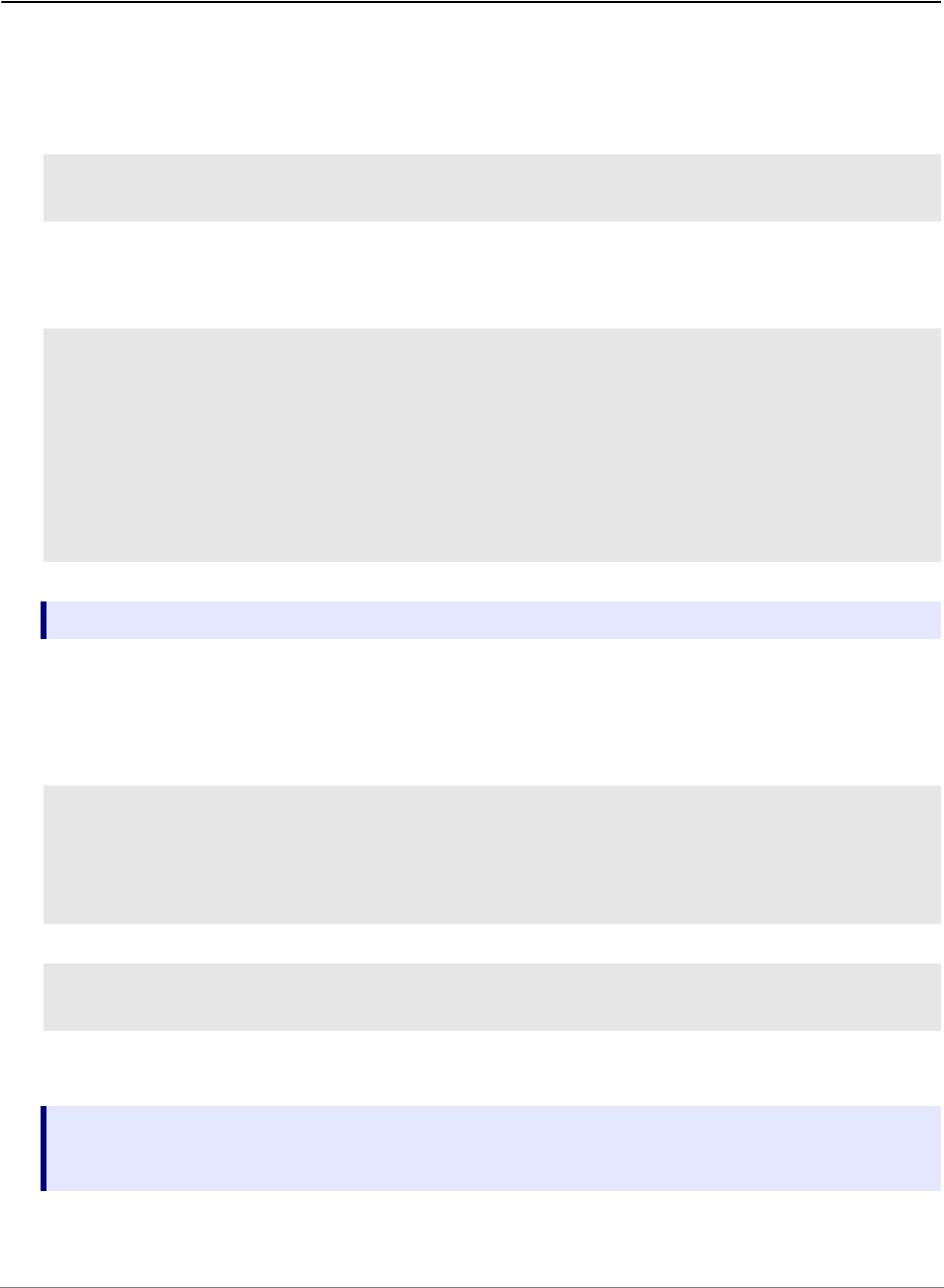
Training Script Language PRACTICE | 125
©
1989-2024 Lauterbach
Path Functions and Path Prefixes
Scripts should avoid hard coding any paths; users will likely have their own PCs set out to their own tastes.
Network drives may also be mapped to different letters.
This example will only work if the ELF file is located in the current working directory.
This example will work only if the ELF file is located in this path. It will not work on a colleague’s PC who has
stored the project in C:\users\barry\Project_1\.
An alternative approach would use relative directory paths. TRACE32 provides a number of functions or
built-in path prefixes. For example:
; This will only work if the ELF file is located in the current directory
Data.LOAD.Elf "myprog.elf"
; This will fail if the ELF file is located somewhere else.
; But it will leave the current working directory unchanged.
; ELF file path "C:\users\rico\project_1\out\myprog.elf"
PRIVATE &pwd
&PWD=OS.PresentWorkingDirectory()
ChDir "C:\users\rico\Project_1\out"
Data.LOAD.Elf "myprog.elf"
ChDir "&pwd"
OS.PresentWorkingDirectory() Returns the name of the working directory as a string.
; 1st example uses OS.PresentPracticeDirectory() to get the current
; script’s directory
PRIVATE &ppd
&ppd=OS.PresentPracticeDirectory()
Data.LOAD.Elf "&ppd\myprog.elf"
; 2nd approach uses built in shortcut "~~~~" instead.
Data.LOAD.Elf "~~~~\myprog.elf"
OS.PresentPracticeDirectory() Returns the name of the directory where the current
PRACTICE script is located as a string.
~~~~/ is the TRACE32 path prefix equivalent.

Training Script Language PRACTICE | 126
©
1989-2024 Lauterbach
If the script is located in the same directory as the ELF file, the above examples will work. If the ELF file is in
a sub-directory, this can also be made to work.
Users could always be presented with a file chooser to browse for the ELF file to be loaded.
The script could be called with the top level directory for the project as an argument.
A better version would be to check if the file exists and prompt the user to browse for it if it is not where
expected.
A complete list of all path prefixes is provided in “Path Prefixes” in PowerView User’s Guide, page 45
(ide_user.pdf).
; 1st example uses OS.PresentPracticeDirectory() to get the current
; script’s directory
PRIVATE &ppd
&ppd=OS.PresentPracticeDirectory()
Data.LOAD.Elf "&ppd\out\myprog.elf"
; 2nd approach uses built in shortcut "~~~~" instead.
Data.LOAD.Elf "~~~~\out\myprog.elf"
Data.LOAD.Elf "*.elf"
; Call script as:
; DO load_script.cmm C:\user\rico\project
;
PARAMETERS &basedir
Data.LOAD.Elf "&basedir\out\myprog.elf"
PRIVATE &ppd &file
&ppd=OS.PresentPracticeDirectory()
&file="&ppd"+"\myprog.elf"
IF OS.FILE("&file")==TRUE()
Data.LOAD.Elf "&file"
ELSE
(
&file="&ppd"+"\out\myprog.elf"
IF OS.FILE("&file")==TRUE()
Data.LOAD.Elf "&file"
ELSE
Data.LOAD.Elf "*.elf"
)
OS.FILE(<filename>) Returns TRUE if the file exists.
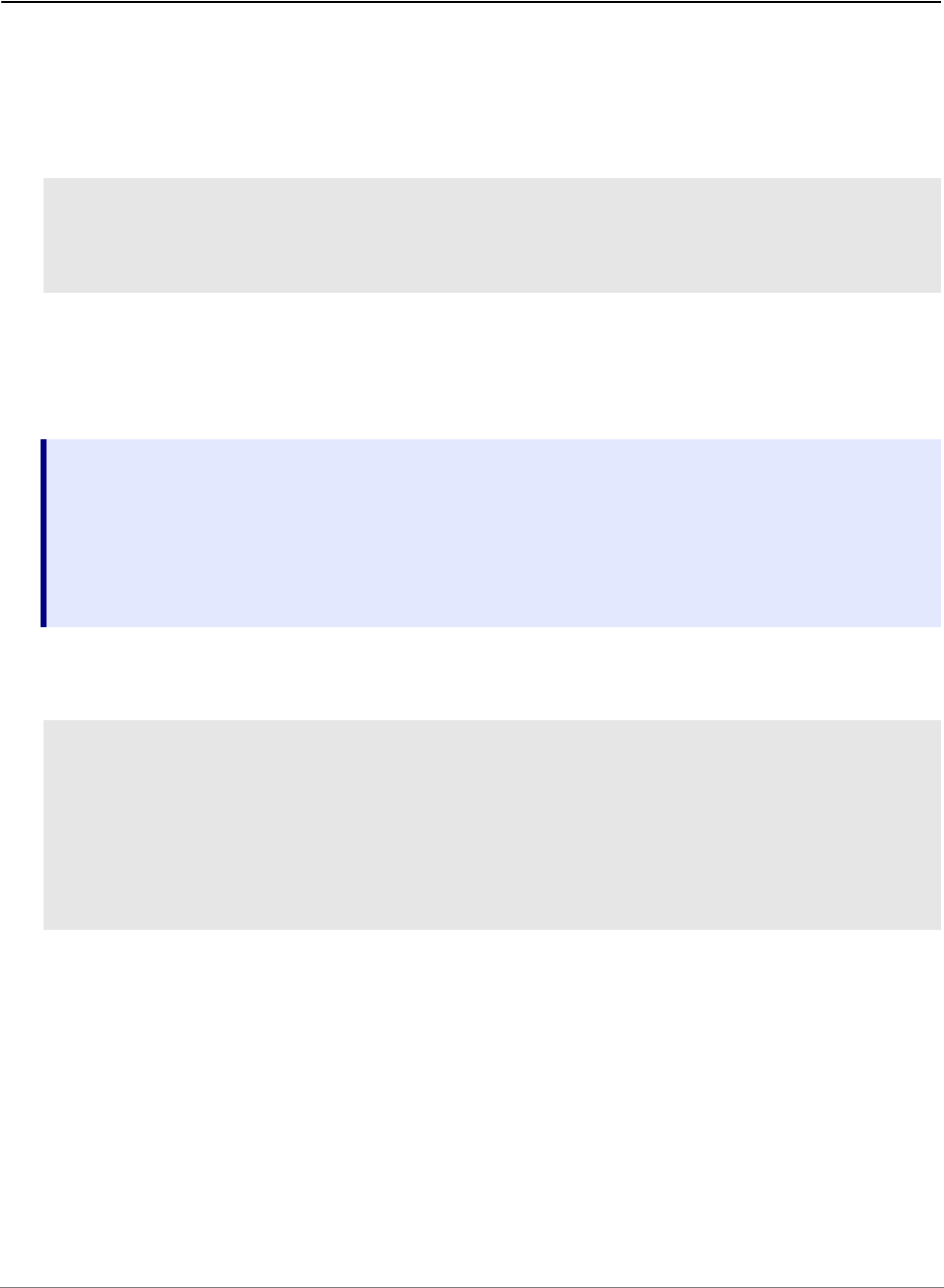
Training Script Language PRACTICE | 127
©
1989-2024 Lauterbach
Host Operating System
There will be differences between host Operating Systems. Scripts should be written in such a way as to
remove the impact of these differences from the user.
If a script uses a forward slash ("/") in a path name, TRACE32 will automatically use the correct slash for the
underlying host Operating System.
Use the TRACE32 built-in commands for file system manipulation. These will automatically be resolved to
the correct commands for the host Operating System. A full list of these commands an be found in See “File
and Folder Operations” in PowerView User’s Guide, page 71 (ide_user.pdf) but include:
The built-in macro "~~" which resolves to the TRACE32 system directory can be used to overcome
differences in host Operating Systems.
Different Operating Systems use different line termination sequences.
• Windows uses CR + LF
• Linux and MacOS use LF
Data.LOAD.Elf "~~~~\myprog.elf" ; Not Portable - Windows only!
Data.LOAD.Elf "~~~~/myprog.elf" ; Portable - Host OS Independent
REN <filename> Rename file.
COPY <source> <destination> Copy file.
MKDIR <path> Create directory.
RMDIR <path> Delete directory.
ZIP <source> [<destination>] Compress files.
; Will only work on Windows host with default installation
COPY C:\t32\config.t32 C:\t32\config-usb.t32
;Will only work on Linux or MacOS with default installation
COPY /opt/t32/config.t32 /opt/t32/config-usb.t32
;Will work anywhere regardless of installation directories
COPY "~~/config.t32" "~~/config-usb.t32"
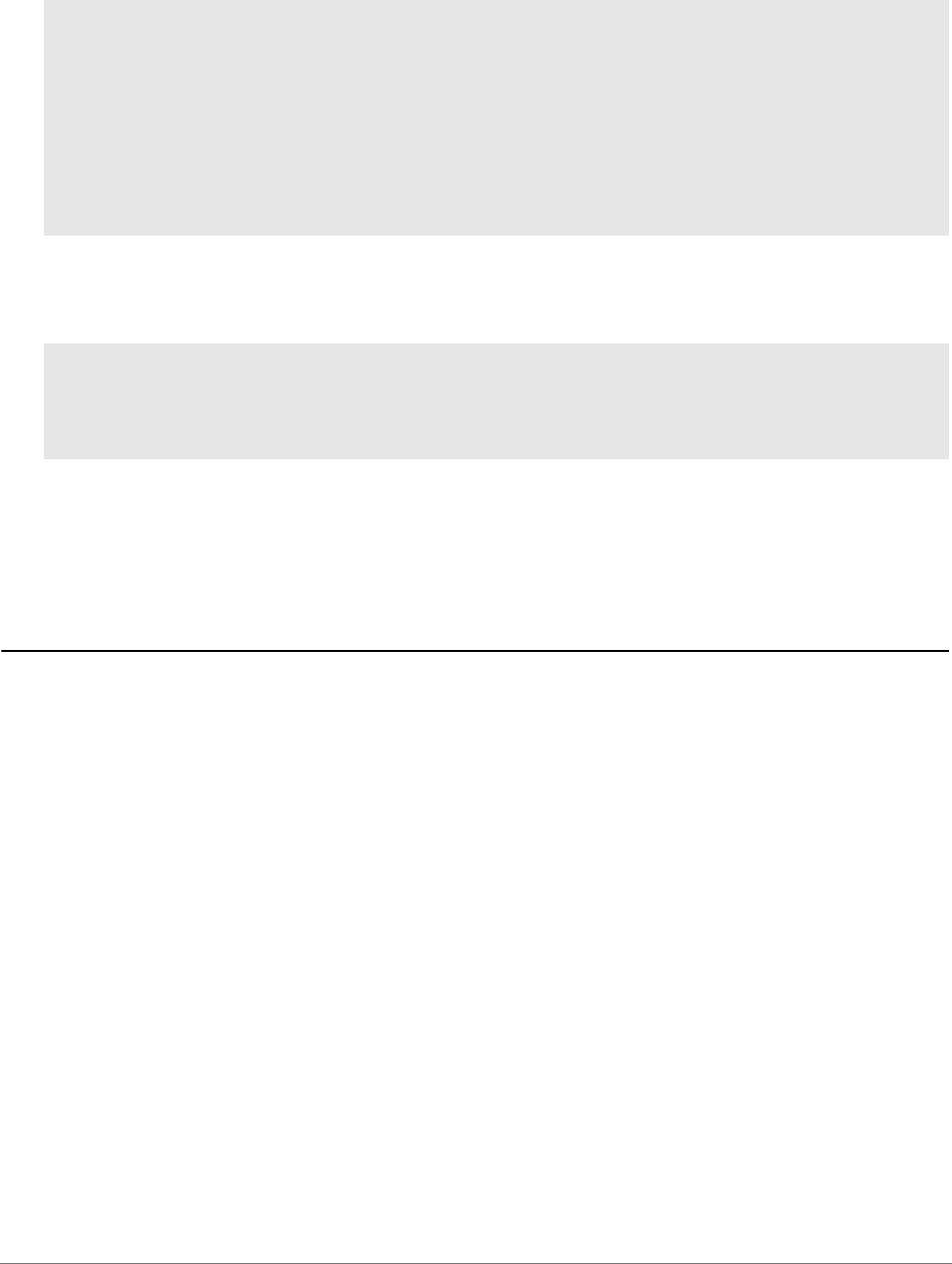
Training Script Language PRACTICE | 128
©
1989-2024 Lauterbach
TRACE32 uses LF to denote an end of line when reading a file. The following code will read a file on any
host11
When TRACE32 writes a file, it uses the correct end of line sequence for the current host Operating System.
Scripts can be made to write portable files by using this trick.
The function OS.VERSION(0) can be used to determine the host operating system. Using this allows scripts
to adapt to underlying fundamental differences. An example can be found on page RICO.
Debug Hardware
A script may need to adapt depending upon the debug hardware that is used. Some scripts may not be
appropriate for certain hardware. The script should check and then inform the user before quitting. A number
of functions exist for TRACE32 hardware detection and more information can be found in “General
Function Reference” (general_func.pdf). A few are listed below. Each returns TRUE if the relevant
hardware is detected.
• AUTOFOCUS()
• hardware.COMBIPROBE()
• hardware.POWERDEBUG()
• hardware.POWERTRACE2()
• INTERFACE.SIM()
LOCAL &text
OPEN #1 "~~~~/log.txt"
READ #2 %LINE &text
WHILE !EOF()
(
PRINT "&text"
READ #2 %LINE &text
)
CLOSE #2
OPEN #2 "~~~~/log.txt" /Create
WRITE #2 %String "Hello" %Ascii 0x0A
WRITE #2 %String "World" %Ascii 0x0A
CLOSE #2
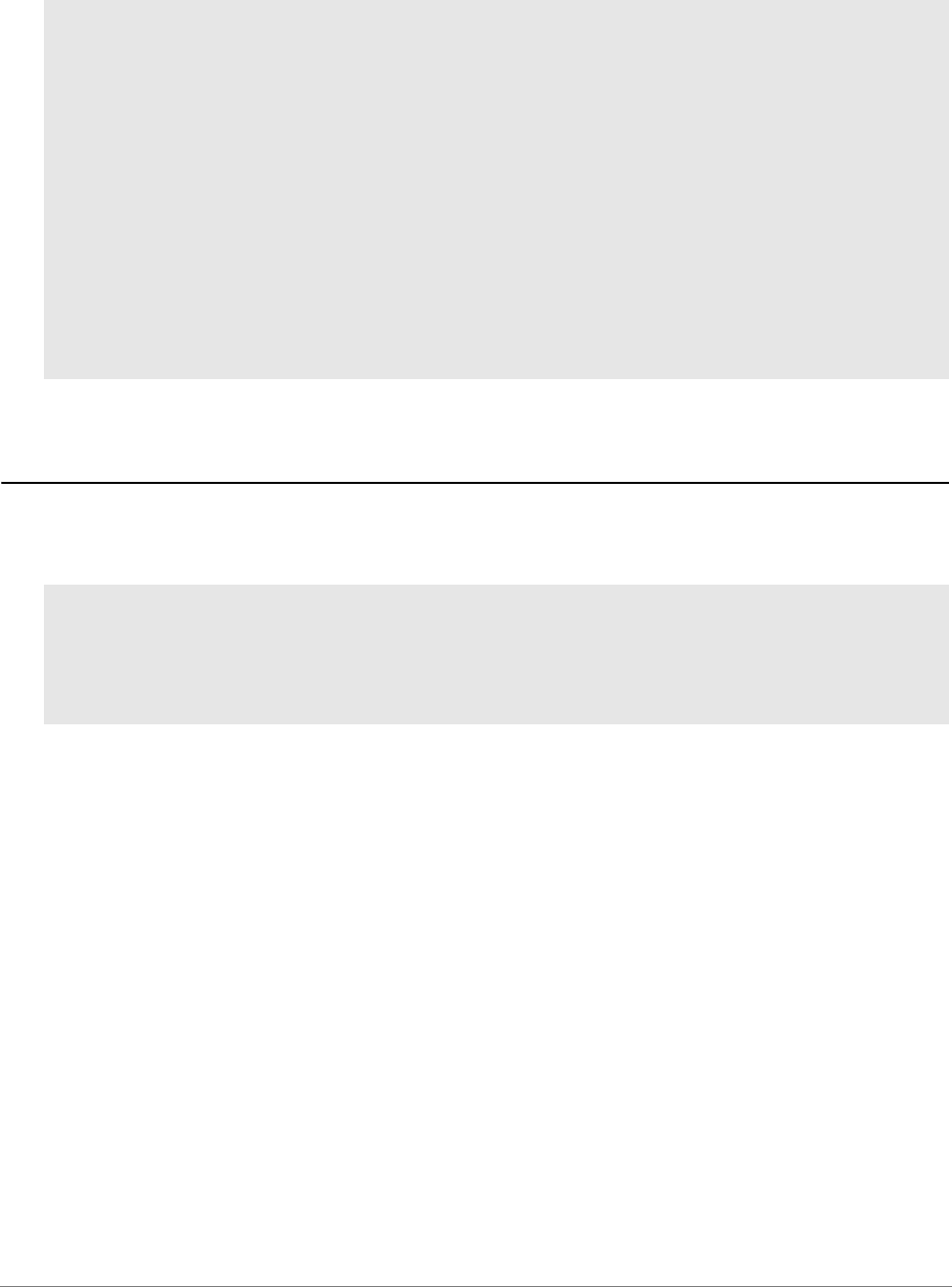
Training Script Language PRACTICE | 129
©
1989-2024 Lauterbach
Target CPU and Board
The function CPUFAMILY() will return the name of the family. Any core which can be debugged with the
same t32m* executable is part of the family. Each family will have its own set of unique functions.
The function CPU() will return the value of the processor selected by the user in the SYStem.state window.
IF INTERFACE.SIM()
(
DIALOG.OK "Simulator mode not supported by this script." \
"Press ’OK’ to exit the script."
ENDDO
)
IF !AUTOFOCUS()
(
DIALOG.OK "Autofocus pre-processor required." \
"Please connect correct hardware." \
"Press ’OK’ to exit the script."
ENDDO
)
;Rest of the script goes here
IF CPUFAMILY()=="ARM"
(
IF CABLE.TWOWIRE()
SYStem.CONFIG SWD
)
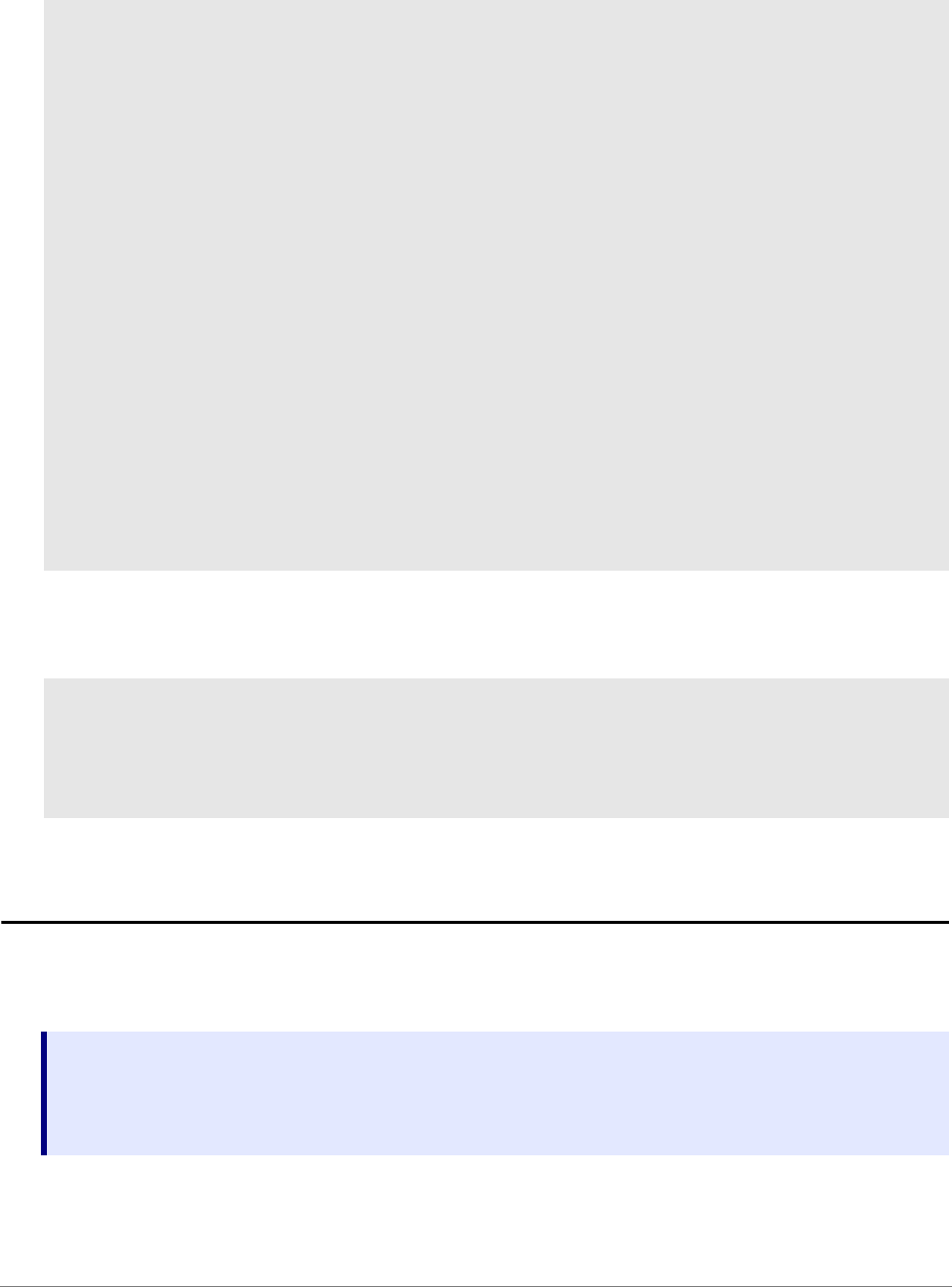
Training Script Language PRACTICE | 130
©
1989-2024 Lauterbach
The JTAG ID code of the nth device in the scan chain can be obtained by using the IDCODE(<n>) function.
Some CPUs do not support byte addressable memory; the smallest addressable unit may be 16, 24 or 32
bits. The script below provides a means of determining this value.
TRACE32 Version
A script should never assume which TRACE32 PowerView features are available to it; it always a good idea
to check. The two main functions for this are:
LOCAL &device
SYStem.RESet
SYStem.CPU ARM7TDMI // Default CPU
SYStem.DETECT IDCode
&device=IDCODE(0)&0x0fffffff
IF &device==0x0B95C02F // TI OMAP4430 (PandaBoard)
(
SYStem.CPU OMAP4430APP1
SYStem.CONFIG CTIBASE 0xd4148000
SYStem.Mode Up
)
ELSE IF &device==0x049220DD // Altera Excalibur
(
SYStem.CPU EPXA
SYStem.Mode Up
Data.Set C15:00000001 %LE %Long 0x0178 // disable Instruction Cache
)
ELSE
(
PRINT %ERROR "Don't know device 0x" %Hex &device
ENDDO
)
LOCAL &width
Data.Set VM:0 %Byte 0 1 2 3 4 5 6 7 8
&width=Data.Byte(VM:1)
PRINT "Width of one address is " %Decimal &width ". byte(s)"
VERSION.BUILD() Returns the build number of TRACE32. Features up to this
build may be included in this version.
VERSION.BUILD.BASE() Returns the base build number for this instance of TRACE32
PowerView. All features of this build will be included.
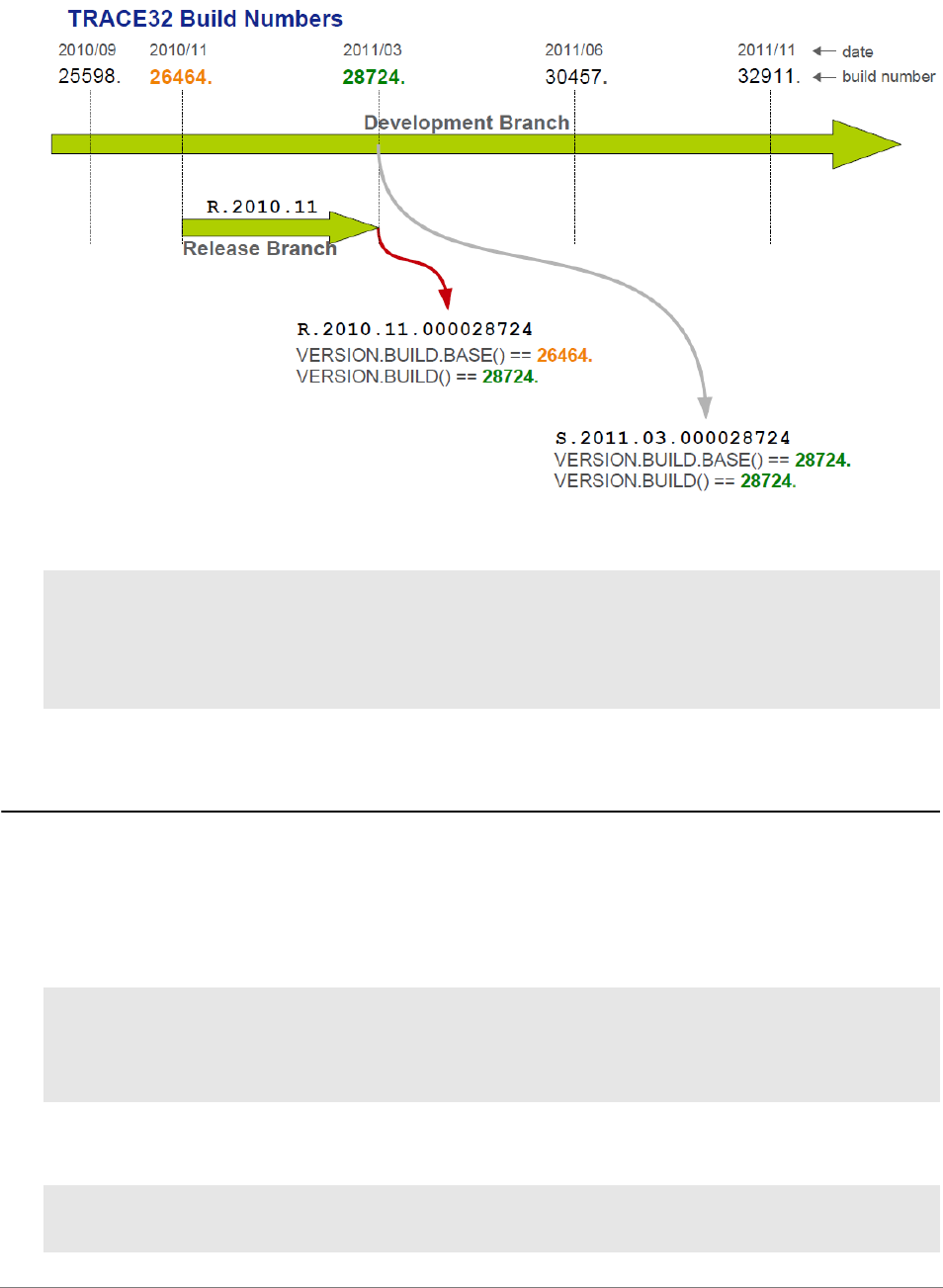
Training Script Language PRACTICE | 131
©
1989-2024 Lauterbach
The diagram here explains the relationship between the two different build numbers.
TRACE32 Settings
TRACE32 is highly customizable and a script should make no assumptions about how a user has their
software configured.
Scripts should not assume a default radix as this is a CONTinue option and users will set it according to their
own preference.
A script should always enforce the radix that it wishes to use to avoid such confusion.
IF VERSION.BUILD()<56572.
(
DIALOG.OK "This script requires TRACE32 build greater than 56572."
ENDDO
)
Data.Set D:10 %Byte 42
; Will write 0x42 to address 0x10 if the radix is set to hex
; Will write 0x2A to address 0x0A if the radix is set to decimal
Data.Set D:0x10 %Byte 0x42 ; Force hex values
Data.Set D:10. %Byte 42. ; Force decimal values

Training Script Language PRACTICE | 132
©
1989-2024 Lauterbach
It is strongly recommended that scripts format any PRACTICE macros before printing them to make the
values un-ambiguous to users. Some examples are shown below.
Three formatting functions exist: FORMAT.HEX(), FORMAT.Decimal() and FORMAT.BIN().
LOCAL &var &text
&var=0x42+23.
&text="The result is 0x"+FORMAT.HEX(0,&var)
PRINT "&text"
LOCAL &var
&var=0x42+23.
PRINT "The result is 0x"+FORMAT.HEX(0,&var)
LOCAL &var
&var=0x42+23.
PRINT "The result is 0x" %Hex &var

Training Script Language PRACTICE | 133
©
1989-2024 Lauterbach
Storing and Retrieving Settings
If a script intends to make use of breakpoints or will open more than a single window, it may be a good idea
to store the users’ current settings and then restore them after the script has completed its work This can be
done using the STOre command.
PRIVATE &bpfile &winfile
; Store user's Breakpoints and Windows away so we can retrieve them
; later. Get temporary files from the host OS
&bpfile=OS.TMPFILE()
&winfile=OS.TMPFILE()
; We'll need to manually add the ".CMM" extension
&bpfile="&bpfile"+".cmm"
&winfile="&winfile"+".cmm"
; Store Breakpoints to temporary file
STOre "&bpfile" Break.direct
; Now clear all the existing Breakpoints
Break.Delete /ALL
; Store Windowss to temporary file
STOre "&winfile" Windows
; Now clear all the existing Windows
WinCLEAR
; Run the rest of the script here
; Restore the user’s breakpoints and windows
DO "&bpfile"
DO "&winfile"
ENDDO
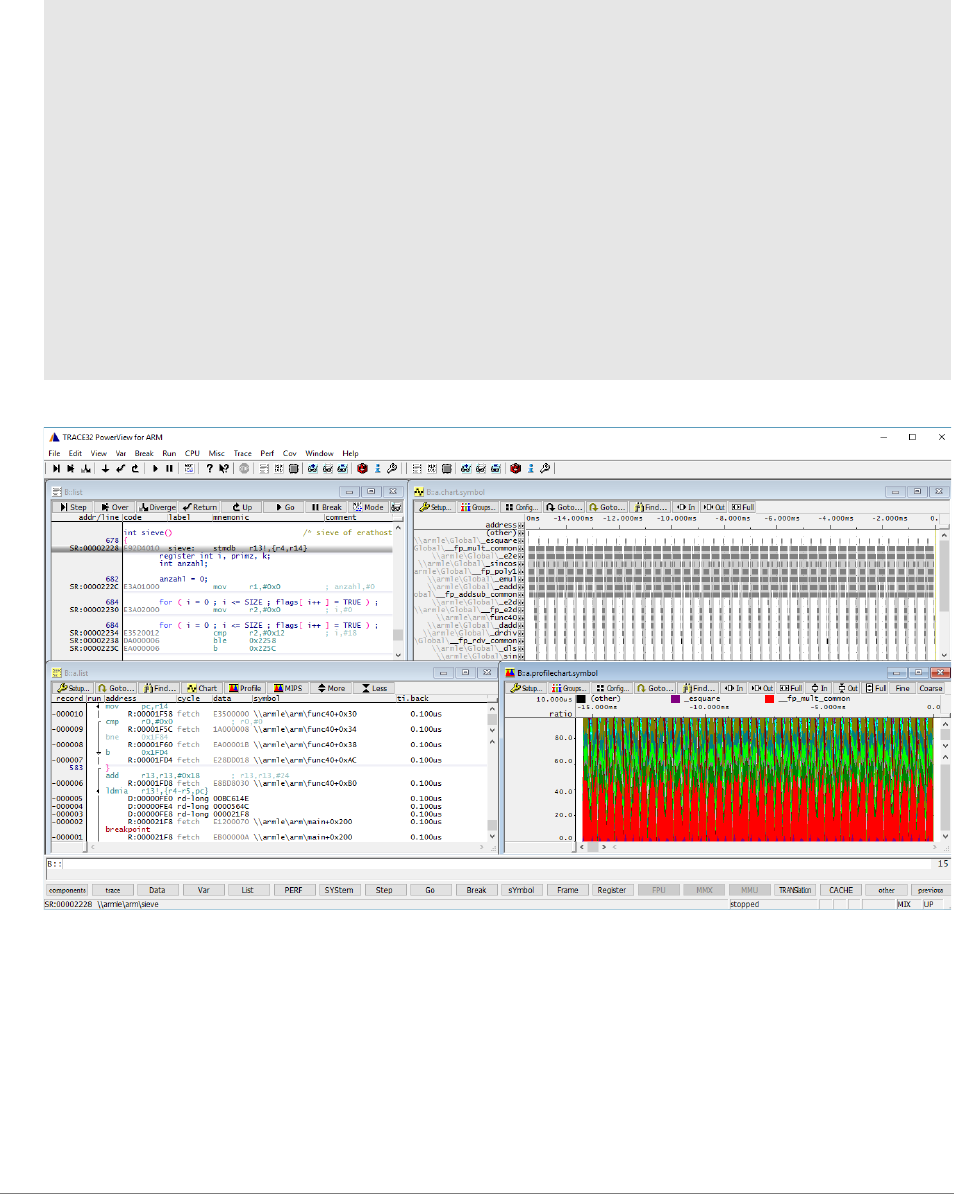
Training Script Language PRACTICE | 134
©
1989-2024 Lauterbach
If the script needs to open any additional windows to display some results it would be unwise to assume that
the script user has a display of a certain size or resolution. Absolute window positioning and sizing may not
produce a readable display. The WinPOS command can take percentages as well as absolute values as its
arguments. Windows could be positioned and sized as a percentage of the current size of the TRACE32
window.
An alternative approach would be to determine the local screen resolution and open a pre-configured
set of windows which match the current screen size. An example of how to do this has been provided in
~~/demo/practice/screen_size.cmm which attempts to extract the screen resolution from the
WinCLEAR
WinPOS 0% 0% 40% 50%
List.auto
WinPOS 40% 0% 60% 50%
Analyzer.Chart.sYmbol
WinPOS 0% 50% 50% 50%
Analyzer.List
WinPOS 50% 50% 50% 50%
Analyzer.PROfileChart.sYmbol
ENDDO

Training Script Language PRACTICE | 135
©
1989-2024 Lauterbach
host OS. An example use case would look like this.
PRIVATE &scrw &scrh
; Call the script which will return the values for screen width and
; screen height
DO ~~/demo/practice/screen_size.cmm
RETURNVALUES &scrw &scrh
; the returned values can be printed like this
PRINT "Screen Width = &scrw"
PRINT "Screen Height = &scrh"
; This handy little trick for PRACTICE will convert the ’string’ macro
; into a ’numerical’ macro so it can be used in a test
&scrw="&(scrw)"
IF &scrw<1280.
(
PRINT "Loading Small screen layout."
; Here, either call a script with windows optimized for a
; small screen or GOSUB to a routine which will open the correct window
; layout
)
ELSE
(
PRINT "Loading Large screen layout."
; Call correct script or GOSUB to routine which opens windows for a
; higher resolution screen.
)
ENDDO

Training Script Language PRACTICE | 136
©
1989-2024 Lauterbach
Robust Error Handling
If a PRACTICE script encounters an error it will halt at the line that produced the error. Using the command
SETUP.WARNSTOP it is possible to also configure a PRACTICE script to halt on a command that merely
produces a warning. More advanced error handling can be used in scripts so that they can recover more
gracefully should something fail. This relies on the event driven features of PRACTICE and in it’s simplest
form looks like the example here. The script will keep running even though an error will be produced.
The call to ON ERROR inherit will restore the previous error handler; error handlers may be stacked. A
better error handler might look like this.
; Enable error handler
ON ERROR GOSUB RETURN
; Execute a command that will fail
Data.LOAD.Elf "non_existent_file.elf"
; Restore previous error handler
ON ERROR inherit
ENDDO
; Enable error handler
ON ERROR GOSUB
(
; Tell the user that the file wasn’t loaded and ask them to browse
; for its correct location.
PRINT "File not found."
Data.LOAD.Elf *
RETURN
)
; Execute a command that will fail
Data.LOAD.Elf "non_existent_file.elf"
; Restore previous error handler
ON ERROR inherit
ENDDO

Training Script Language PRACTICE | 137
©
1989-2024 Lauterbach
Since build 72159 it is possible to check after each command whether or not an error occurred. This allows
PRACTICE script developers to work in a more traditional style. To prevent the script from halting, this
should be combined with the error handler described previously.
IF VERSION.BUILD()<72159.
(
DIALOG.OK "Your version of TRACE32 is too old to run this script."
ENDDO
)
ON ERROR GOSUB
RETURN
; label to return to for re-try
start_here:
; Clear any existing errors
ERROR.RESet
Data.LOAD.Elf "myprog.elf"
; Check if there was an error
IF ERROR.OCCURRED()
(
; Try to determine what the error was and fix it
IF ERROR.ID()=="#FILE_ERRNFD"
(
PRINT "File not found"
Data.LOAD.Elf *
)
IF ERROR.ID()=="#emu_errpwrf"
(
DIALOG.OK "Please apply power to the target then click 'OK'"
GOTO start_here
)
; Finally, an unexpected error. Report it to the user.
IF ERROR.ID()!=""
(
DIALOG.OK "Error occurred : " ERROR.ID()
)
)
ENDDO

Training Script Language PRACTICE | 138
©
1989-2024 Lauterbach
Argument Handling
Designing a script to be re-useable requires that some thought is given to checking argument values passed
in by the user. The script cannot assume that the arguments it gets will always be correct. Using
STRing.SCANAndExtract() can ensure that argument order does not matter but does not enforce the
contents of an argument. PRACTICE macros can always be treated as strings and something like the
IsNum sub-routine below can check that a macro only contains a numerical value in either decimal or hex
format.
; Example sub routine for checking a macro is numeric only
LOCAL &arg1 &arg2 &ret
&arg1=25.
&arg2="Hello"
GOSUB IsNum "&arg1"
RETURNVALUES &ret
PRINT "&ret" ; Prints TRUE()
GOSUB IsNum "&arg2"
RETURNVALUES &ret
PRINT "&ret" ; Prints FALSE()
ENDDO
IsNum:
PARAMETERS &txt
LOCAL &ret &len &i &char
&ret=TRUE()
&len=STRing.LENgth("&txt")
IF STRing.ComPare(STRing.LoWeR("&txt"),"0x*")==TRUE()
(
; Possibly a hex number
&i=2.
)
ELSE
(
; Assume a decimal number
&i=0.
)
RePeaT (&len-&i)
(
&char=STRing.MID(STRing.LoWeR("&txt"),&i,1)
IF STRing.FIND("0123456789.","&char")==FALSE()
&ret=FALSE()
&i=&i+1
)
RETURN "&ret"

Training Script Language PRACTICE | 139
©
1989-2024 Lauterbach
Creating a Custom Command
It is possible to create a custom command in TRACE32. This is done by using the command GLOBALON .
The command <name> is created but is restricted to a maximum of 9 characters. In the example script
below, call it without arguments to register the command, call it with a single argument of "REMOVE" to
remove the command.
GLOBALON CoMmanD <name> DO <script>
PARAMETERS &test &testfile &count
IF "&test"==""
(
; No arguments so register the command
; Command name is limited to 9 characters
LOCAL &this_script
&this_script=OS.PresentPracticeFile()
GLOBALON CoMmanD TESTRUN DO "&this_script"
)
ELSE IF "&test"=="REMOVE"
(
; Use this to remove the global command
GLOBALON CoMmanD TESTRUN
)
ELSE
(
RePeaT &count
(
GOSUB &test "&testfile"
)
)
ENDDO
test1:
PARAMETERS &tf
PRINT "Running test1 with data file (&tf)"
RETURN
test2:
PARAMETERS &tf
PRINT "Running test2 with data file (&tf)"
RETURN

Training Script Language PRACTICE | 140
©
1989-2024 Lauterbach
Once the command has been registered it can be accessed form the TRACE32 command line or from
within another script, for example.
Common Pitfalls
This final section focuses on some of the common mistakes that can be made in PRACTICE scripts.
Try not to use blocking commands unless you are debugging your script. Commands like STOP and ENTER
will stop the script from executing but will give the user no indication that the script has halted or is awaiting
further input. It is a better idea to use a dialog instead.
Watch for white space. It is required after an IF or WHILE command but should not appear in expressions.
; Call the script with no arguments to register the command
DO custom_command.cmm
; Use the command to run the test cases
TESTRUN "test1" "testdata1.txt" "0x10"
TESTRUN "test2" "testdata2.txt" "0x03"
; Call the script again to remove the command
DO custom_command.cmm "REMOVE"
ENDDO
; INCORRECT example
IF(&i<5.)
; CORRECT examples
IF (&i<5.)
IF &i<5.
; INCORRECT expression
&x = ( 5. + 8. * 2 ) / ( 3 + &i )
; CORRECT expression
&x=(5.+8.*2.)/(3/+&i)

Training Script Language PRACTICE | 141
©
1989-2024 Lauterbach
Functions should not appear in filenames.
Always use the correct declaration of PRACTICE macros. Review the difference between LOCAL and
PRIVATE.
Always assume that the default radix is not what you require. Force your macros to the correct radix. For
example, use 0x10 or 16. but never 10 on it’s own.
Use the built-in commands for TRACE32 directories instead of hard coding paths to scripts or files.
Use TRACE32 built-in commands for host OS file manipulation (copy, change directory, delte, etc.). This
makes the script portable across different host Operating Systems.
; INCORRECT example
Data.LOAD.Elf STRing.TRIM("&dir")+"/myprog.elf"
; CORRECT example
&dir=STRing.TRIM("&dir")
Data.LOAD.Elf "&dir/myprog.elf"

